Ahrefs or SEMrush: Which is better?
We get asked this question, a lot.
The truth is, both are fantastic tools that allow SEO professionals to do their work more effectively.
When I started in SEO in 2009, the landscape was very different.
We used Google’s Keyword Planner for keyword research, manually (for the most part).
We checked technical elements and did technical audits, and had very little insight into our competitors outside of how they ranked for the keywords that we targeted as well.
In our present day, the landscape is very different. Tools abound.

As you can see, platforms and tools created to help deep-dive into keyword research and competitors, also use their own
SEOs love time-saving tools, and for every tool that is commonly used, you can find a dozen others focusing on specific elements of that tool or offering something slightly different.
Then there are the industry leaders, including:
[Find a more extensive list here: 9 Absolute Best SEO Website Crawling And Auditing Tools]
While the other tools have their value and place, these industry leaders offer outsized value for their fee.
So let’s dig into the age-old SEO question of “Ahrefs vs SEMrush?” and see if we can help you make the right decision.
If you’re looking to test both tools, make sure you take out trials. Use our link below to get a free 14-day SEMrush trial, and Ahrefs offers select ‘Webmaster’ tools to test for free.
Disclaimer: Credo has paid for our own subscriptions to both Ahrefs and SEMrush. Credo is a SEMrush affiliate, which means that if you use our special link to get a free 14-day trial of SEMrush and then choose to stay as a subscriber, we may receive a commission.
This has not, however, influenced our decision and comparison as both tools are incredibly useful and valuable, and you should use the one that is the right fit for you, your business, and your budget. We have also asked Ahrefs numerous times for an affiliate program and will be the first to sign up when/if they launch it.
Table of Contents
Ahrefs vs SEMrush: Brief Summary
The purpose of this article is to outline the major features of both and to help you understand which one you should use as you look to grow your organic traffic.
In this article we will cover each tool’s capabilities around each of the four pillars of SEO, which are:
- Technical research
- Keyword research
- Competitor research
- Link research
These are the main four areas that most SEOs care about. So they are the ones we will dive deep into.
It is also true that both tools offer many more features than just these four areas. You should investigate each separately and test the best fit for your needs.
For example, SEMrush has a Lead Generation Tool that I have used extensively in the past.
This feature is part of a paid subscription, while Ahrefs has tools like their SEO toolbar, which is a rival to Moz’s MozBar, and uses Ahrefs data.
The Winner
Overall, our winner between Ahrefs and SEMrush is:
SEMrush
While the tools are very competitive, as you will see throughout the deep dives below we feel that SEMrush has a good balance between useful insights, a lot of data, and tools that go beyond just data. Tools that actually help you be a better marketer.
Therefore, the advantage is to SEMrush.
Please remember that both of these toolsets are constantly in flux and seem to be in a race to see who can roll out the newest features currently. You should investigate both as you decide on a tool to check for the best fit.
Technical Research: Ahrefs vs SEMrush
Technical SEO is one of the main pillars of SEO.
Without technical SEO, websites would not be as crawlable by search engines and one could make an argument that user experience (UX) across the internet would suffer as well.
So who wins with their technical SEO tools, Ahrefs or SEMrush?
SEMrush
SEMrush’s technical SEO capabilities and monitoring center around their Site Audit option, located in the left sidebar of their main application.
You set up your Site Audit by clicking ‘Site Audit’ in the left sidebar.
Then, New Site Audit is in the top right.
Finally, you enter your domain and project name:
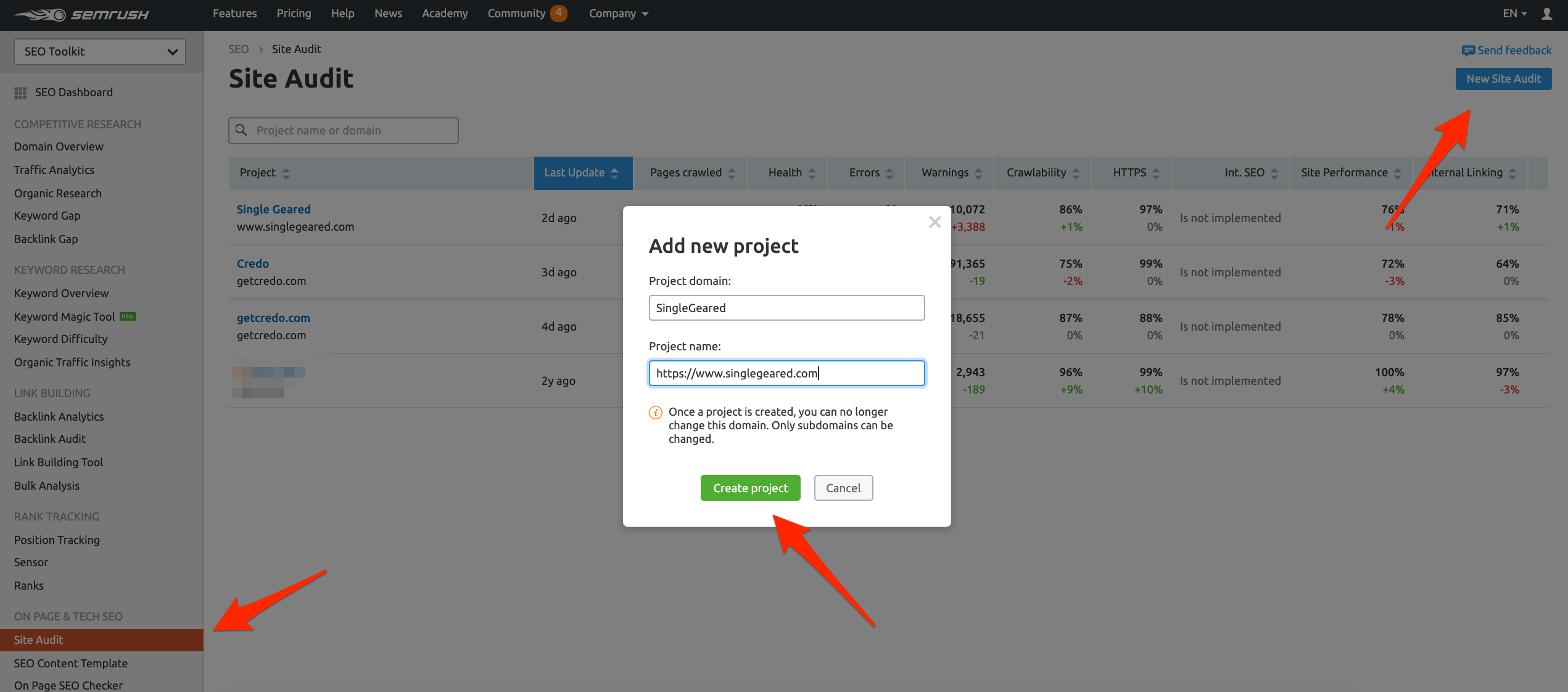
The main dashboard for a configured Site Audit:
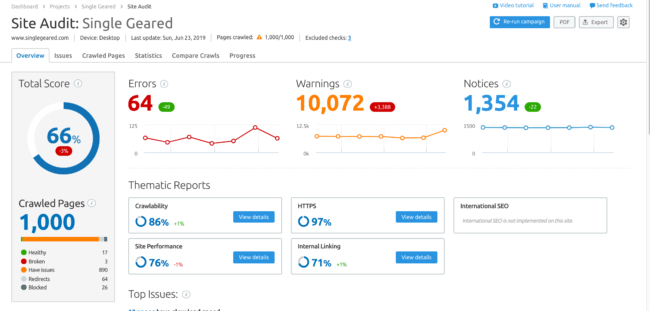
The Site Audit provides:
- The number of pages crawled per crawl (and the ability to change this).
- Ability to hide “non-issues” that don’t hurt your score.
- Quick view of crawlability/HTTPS/internal linking/site performance/
- Numbers of issues in each bucket (Errors/Warnings/Notices) and changes over time.
The SEMrush site audit is split into six main parts, with sub-parts under each of those.
The six main sections of the Site Audit are:
- Overview
- Issues
- Crawled Pages
- Statistics
- Compare Crawls
- Progress
Issues
When you click on one of the issue levels, you get a view like so:
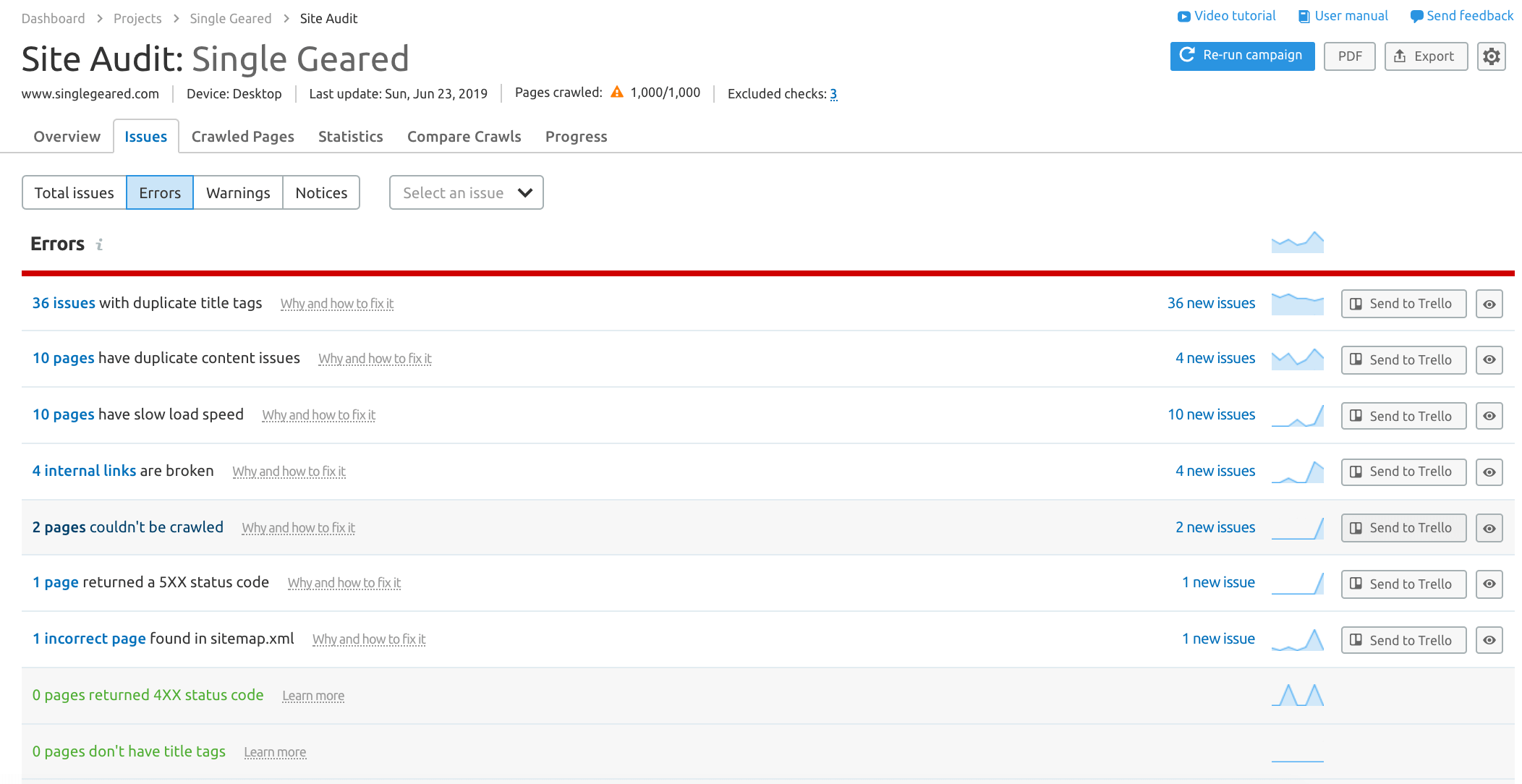
And from here you can click in (using the “XX new issues” link) to a deeper view like this, where you can then hide individual lines as they are fixed:
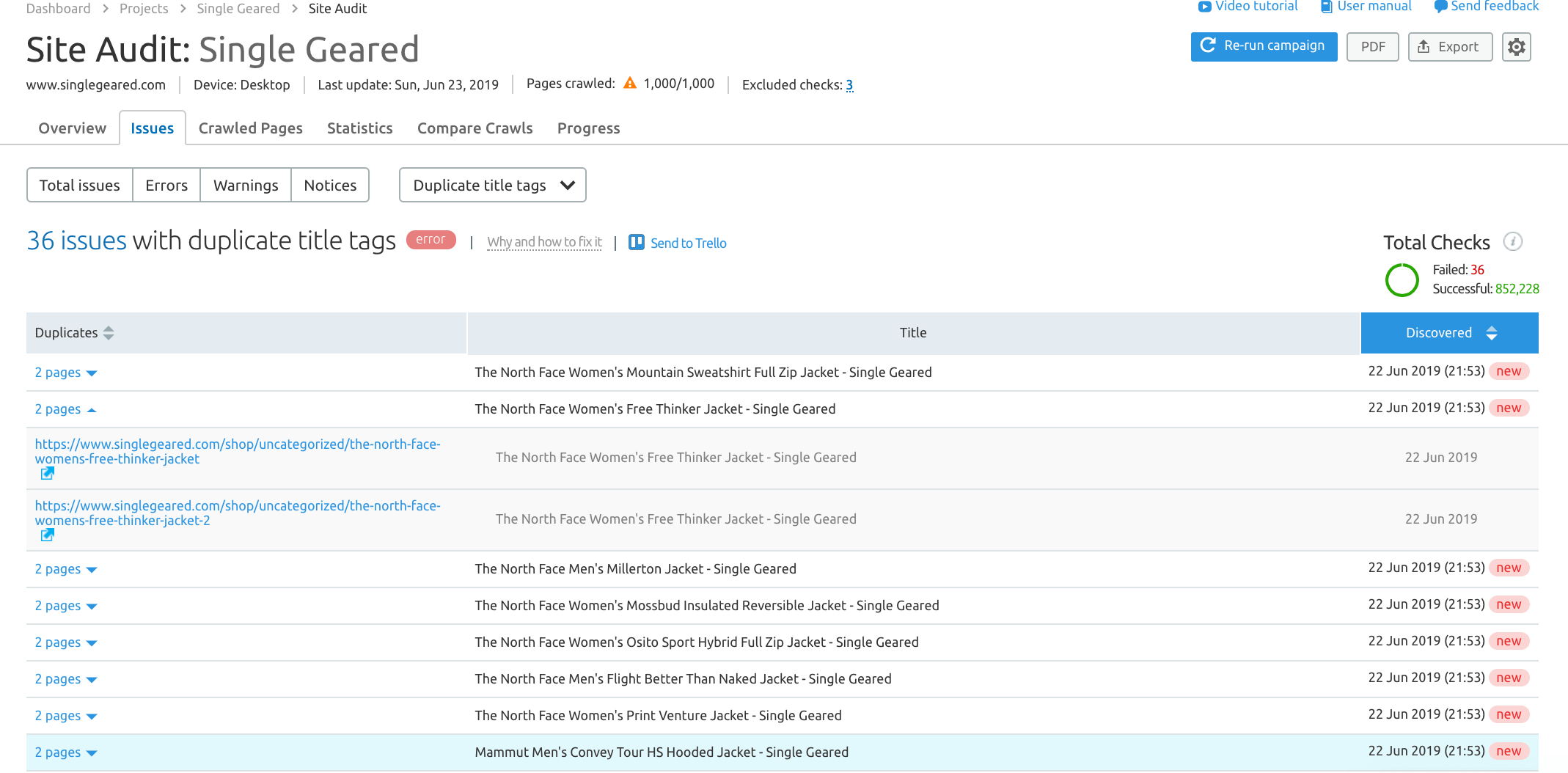
Crawled Pages
You can also see all pages crawled:

Site Structure
This is an extremely useful view of pages by folder structure, which helps you understand your site sections and issues by section so you can prioritize fixes accordingly:
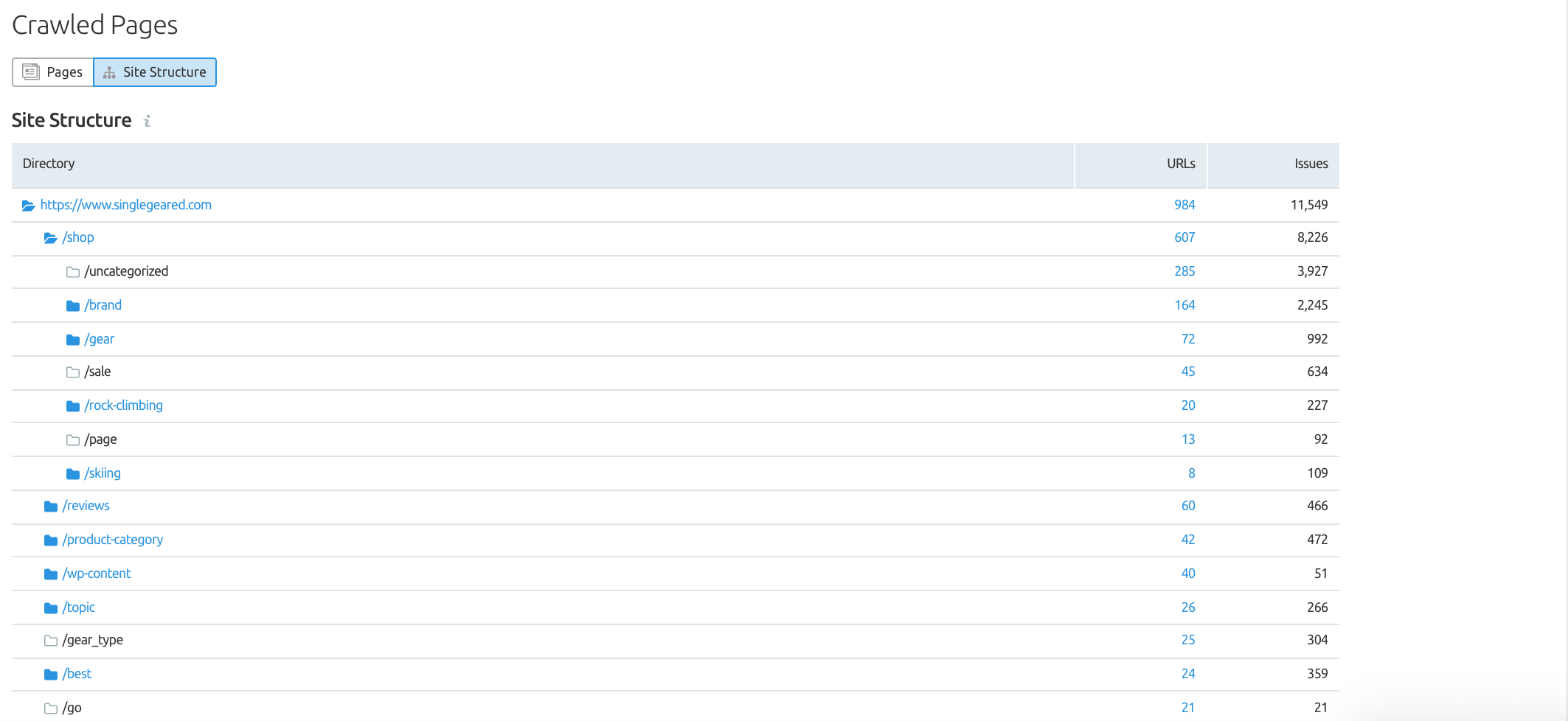
Statistics
And you can also get some very useful graphs to help you see your site’s health.
I do wish some of these were on the dashboard view, but this is a great place if you know what you are looking for.
For example, if you have a lot of pages crawled with zero internal links, this is where you could see that:
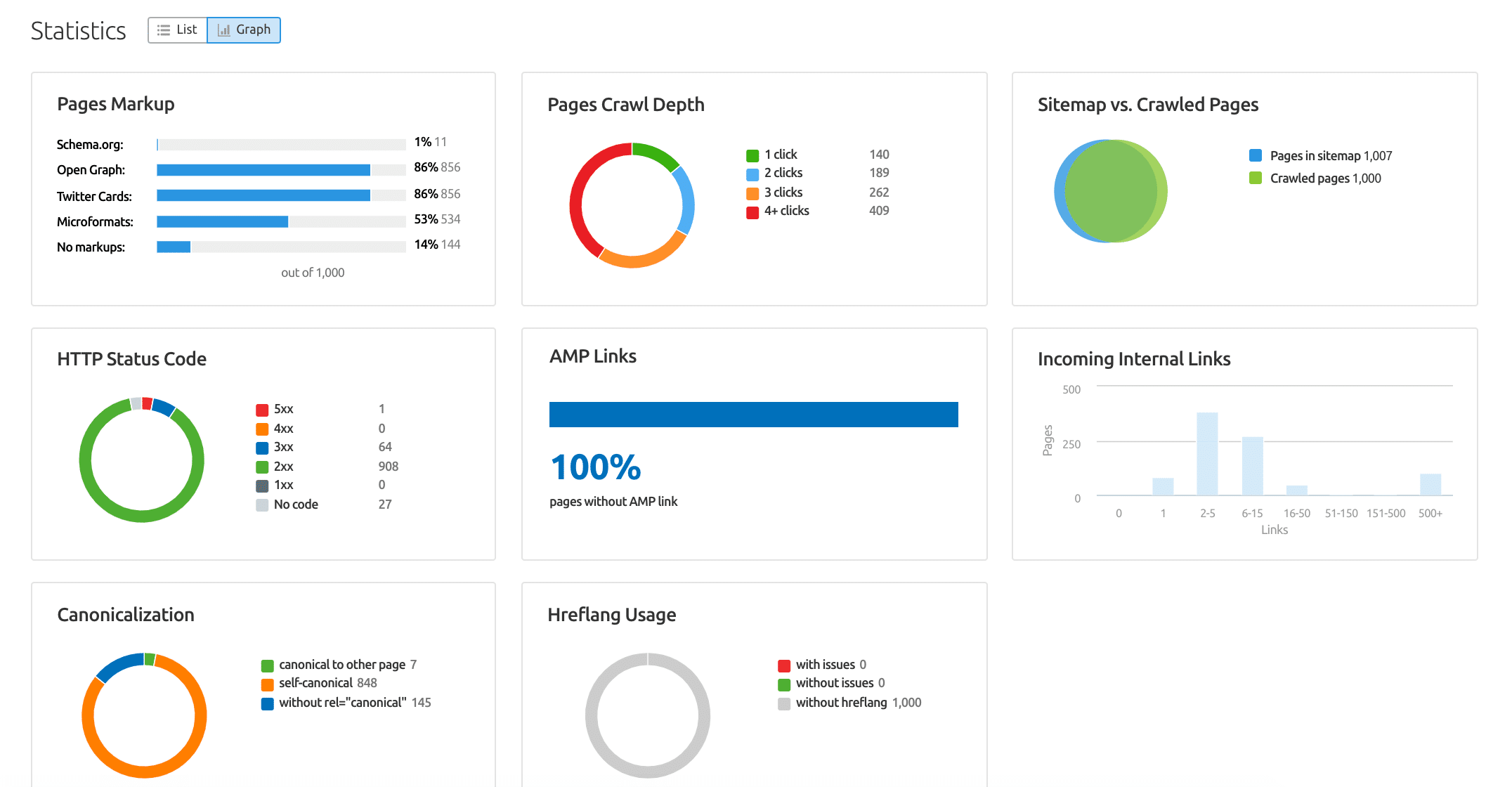
Compare Crawls
SEMrush has the ability to compare crawls as well.
Comparing crawls is useful to track traffic over time, as well as to diagnose reasons for a traffic drop.
This is a great reason to have consistent ongoing crawls set up!
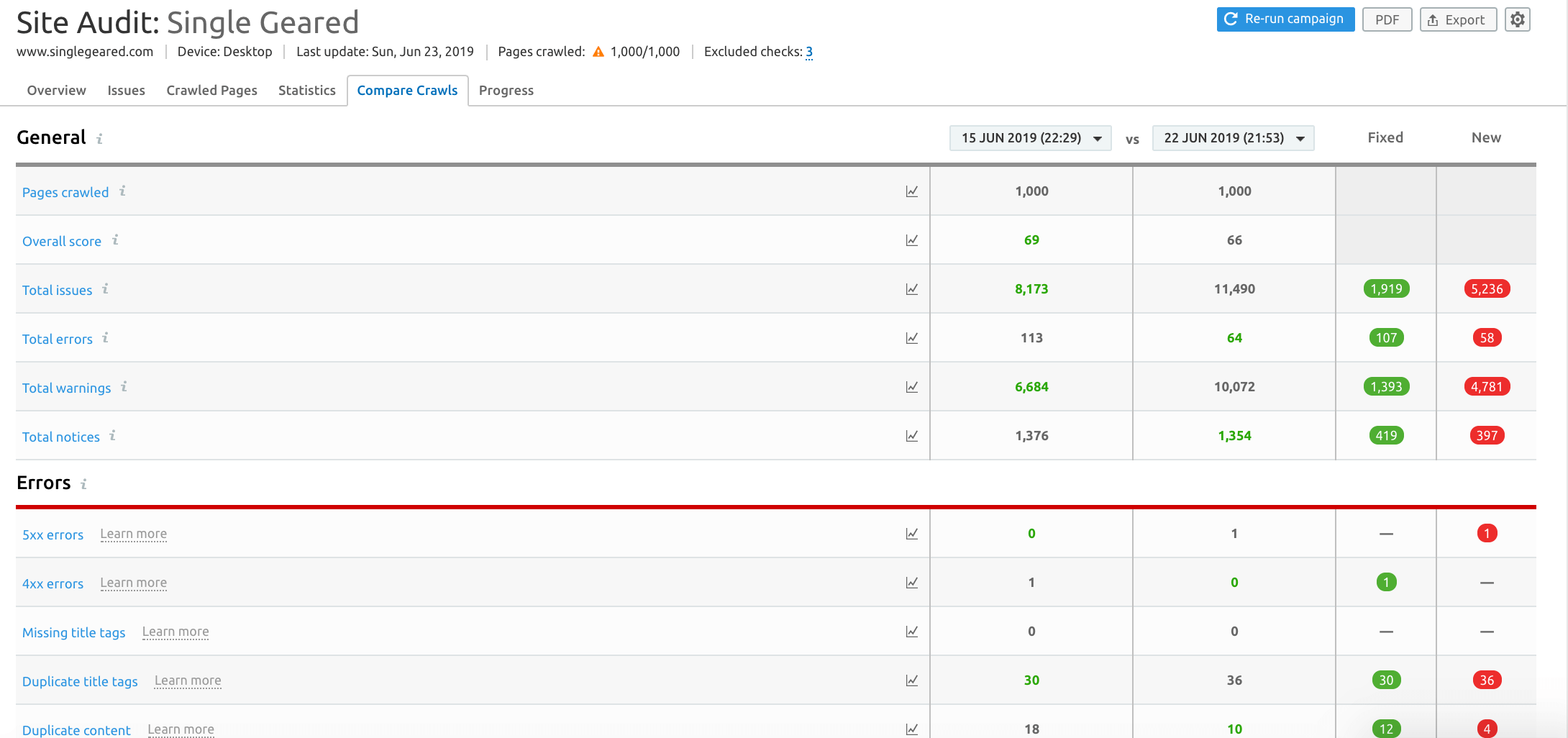
Send to Trello
SEMrush does not have an internal “To do” list like Ahrefs, but they do have an integration with Trello where you can add issues to Trello boards that are then shared with developers:
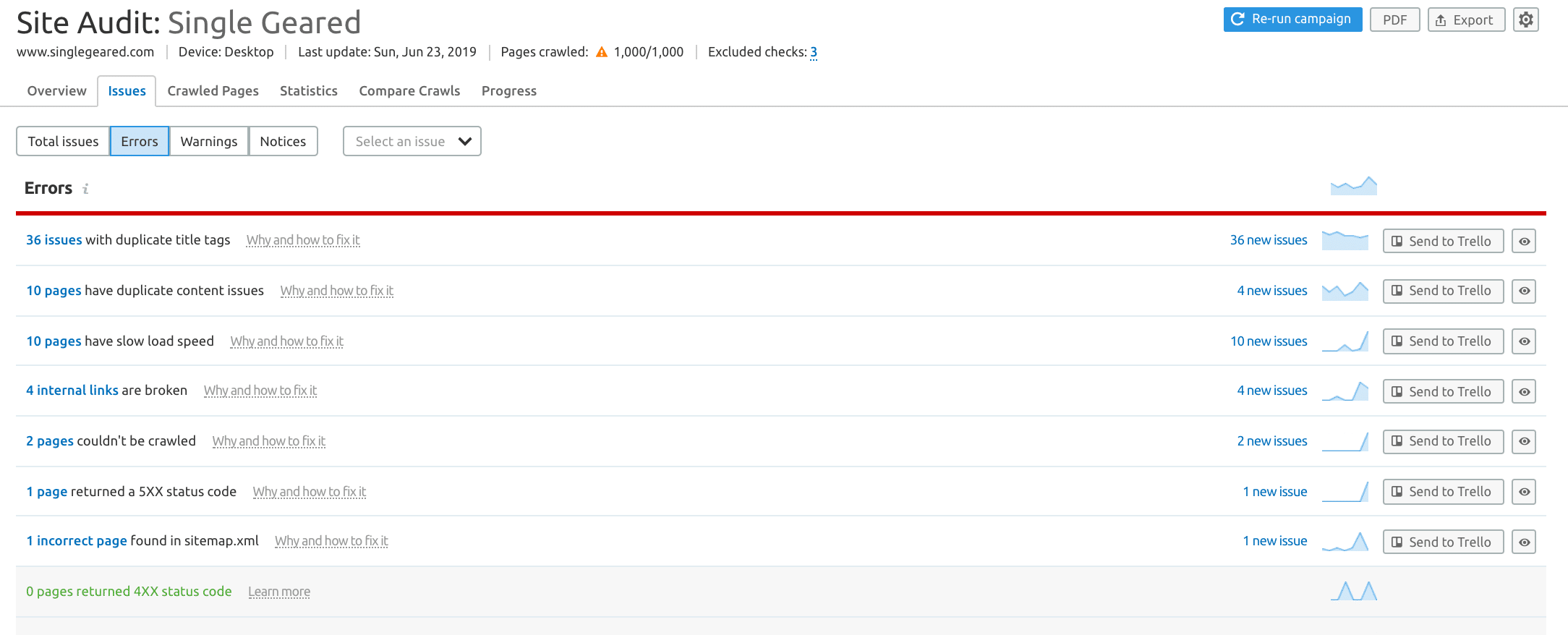
I will say that SEMrush’s current design is not easy to use, but the data and issues they flag up will help you a lot when optimizing the technical aspects of your site.
Ahrefs
Now let’s look at Ahrefs’s technical research.
They’ve invested a lot over the last few years in this product.
When it first launched I was dubious that another was needed. But they’ve done a great job.
You find it at the top of the screen when logged in:

First they ask you to set it up and verify that you own the site:

You verify your ownership:

Then you set up the audit (I use default settings) and then schedule it:
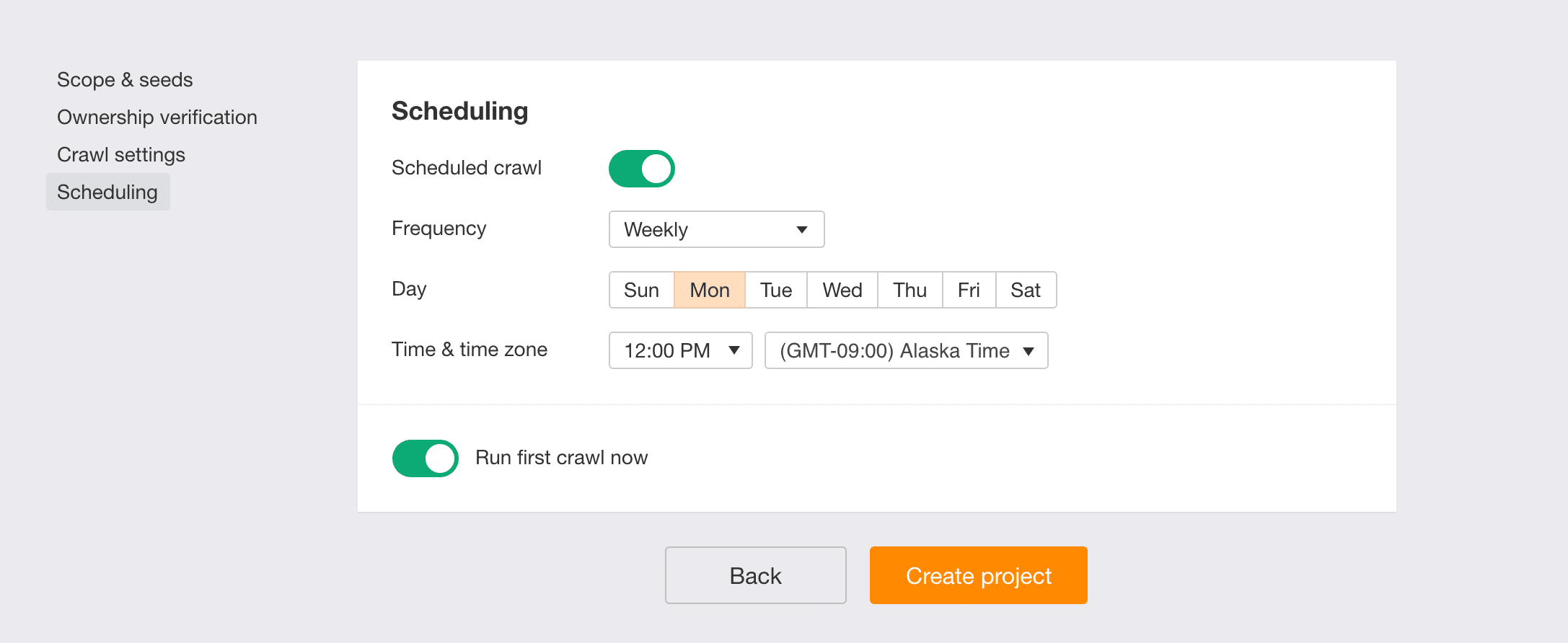
Here’s the site audit dashboard with all of your audit projects:

When you click in, the displayed dashboard provides a very high-level overview:

Once you click in (I use the Total URLs Crawled number link), you are presented with a sidebar with audit options.
This could be easier to access and will likely improve over time:
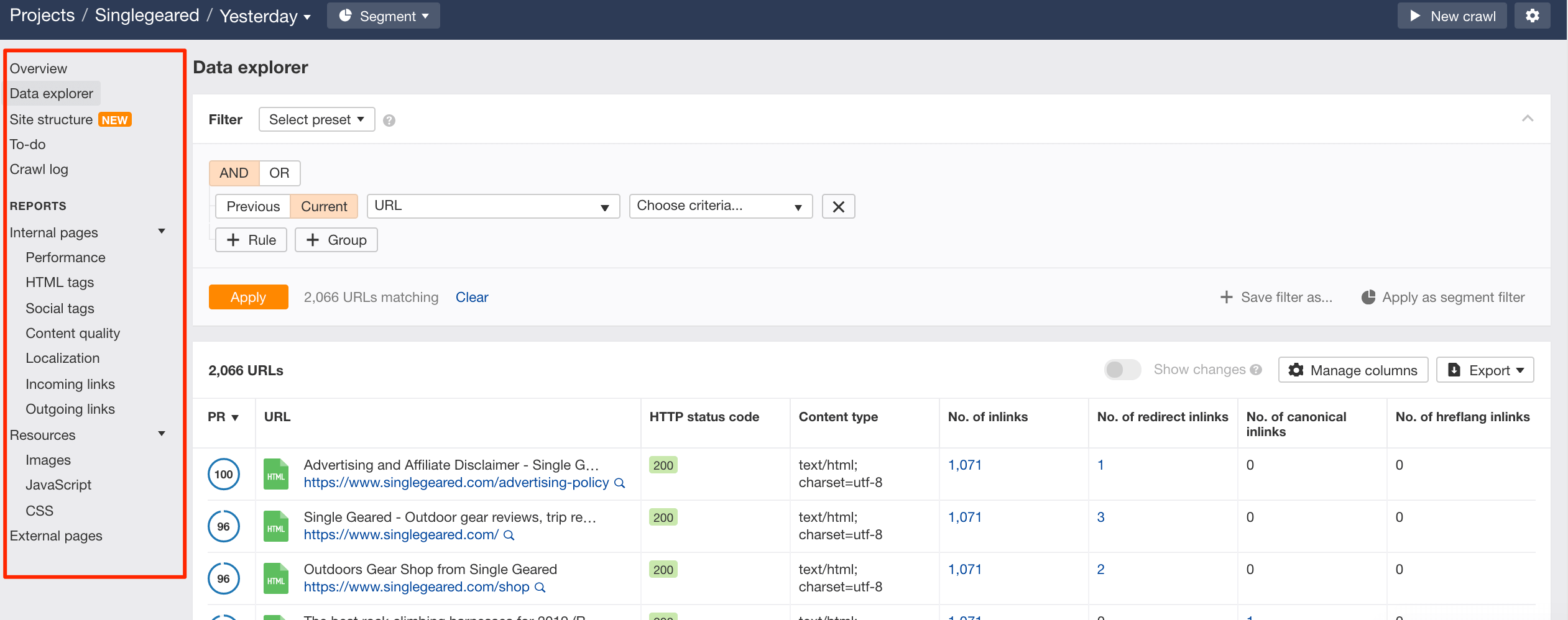
As you can see there are four main sections and 11 reports.
The four main sections are:
- Data Explorer (slice and dice however you want);
- Site Structure (which is new);
- To-do (a way to add prioritized fixes for your developers to work on);
- Crawl log (comparing past crawls).
Data Explorer
Within Data Explorer, you can slice and dice the data however you want.
Here’s a snapshot of the various things you can find based on questions you have, such as “show me all URLs that have a redirect chain”:

Here’s how that looks (and is an issue I discovered on my own site!):
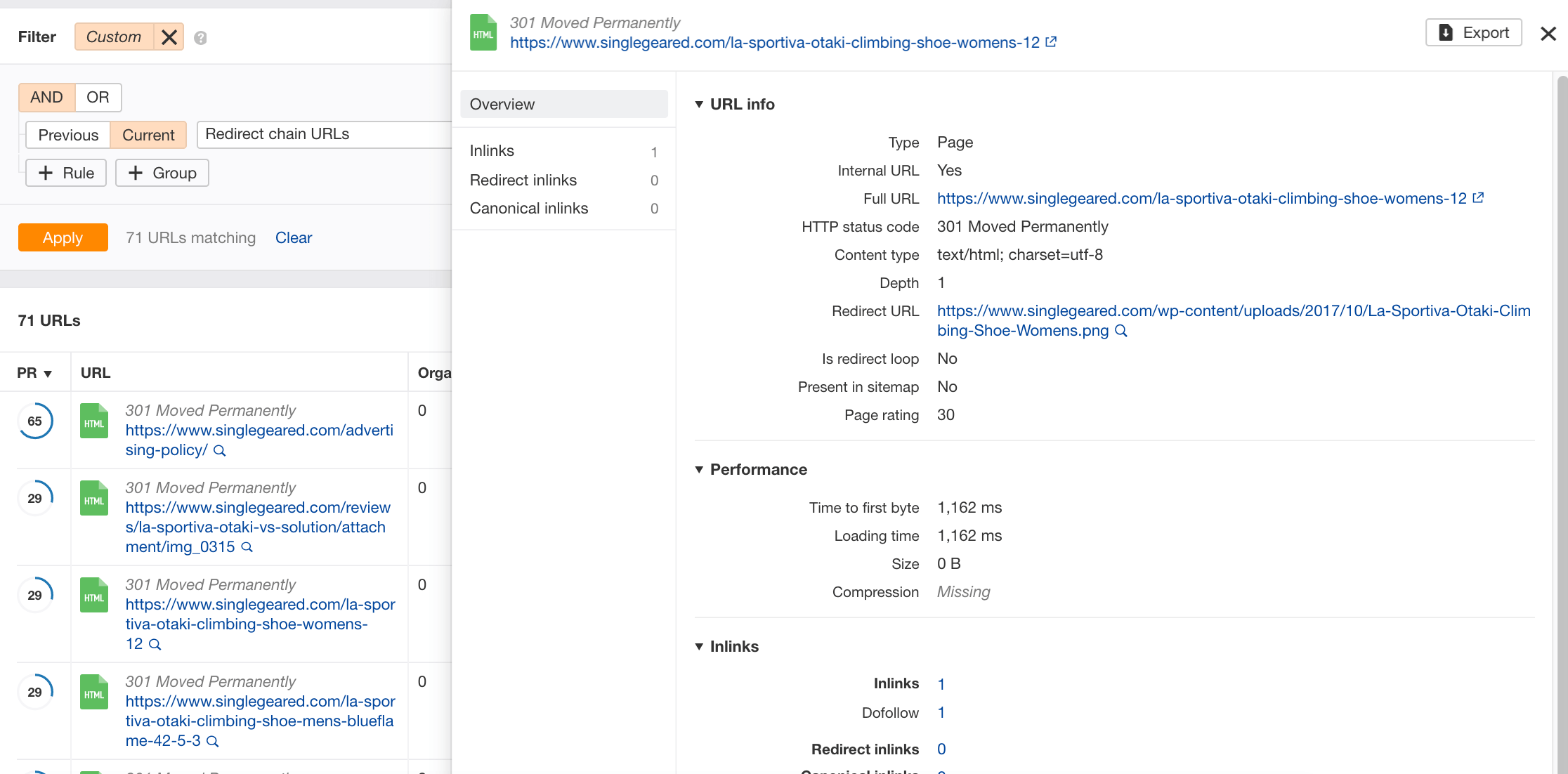
Still a lot of data, but very insightful if you know what you are looking for.
Site Structure
Next is the site structure report.
As demonstrated by SEMrush above, this is becoming an industry-standard report:
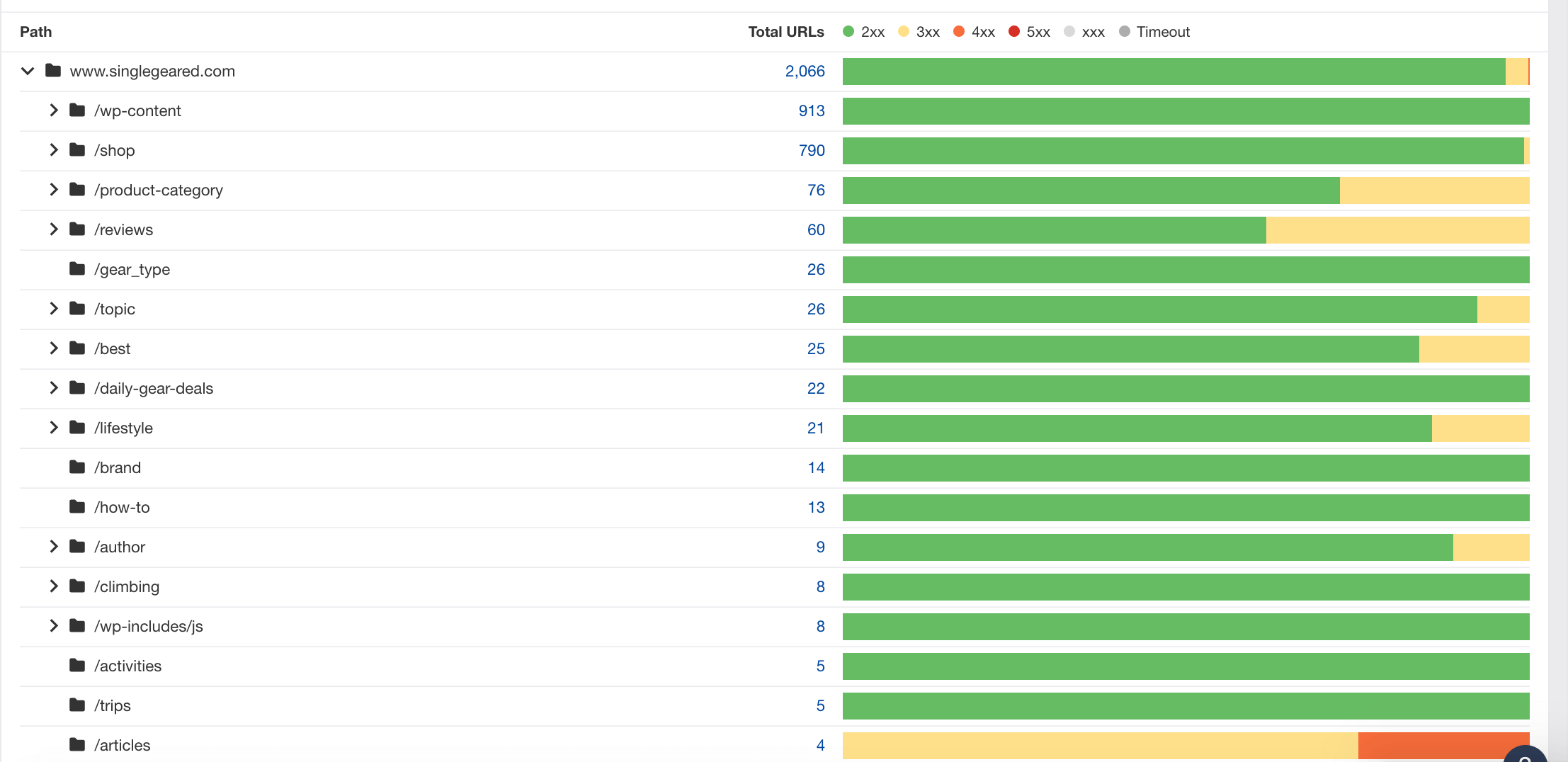
I really like this view as it’s easy to visually see the areas that need help.
It’s not quite as granular as the SEMrush report, but the visual aspect helps me prioritize quickly for status codes.
Unfortunately, this report doesn’t give me anything (at least from what I can find) beyond just status codes
This renders the report only mildly helpful:
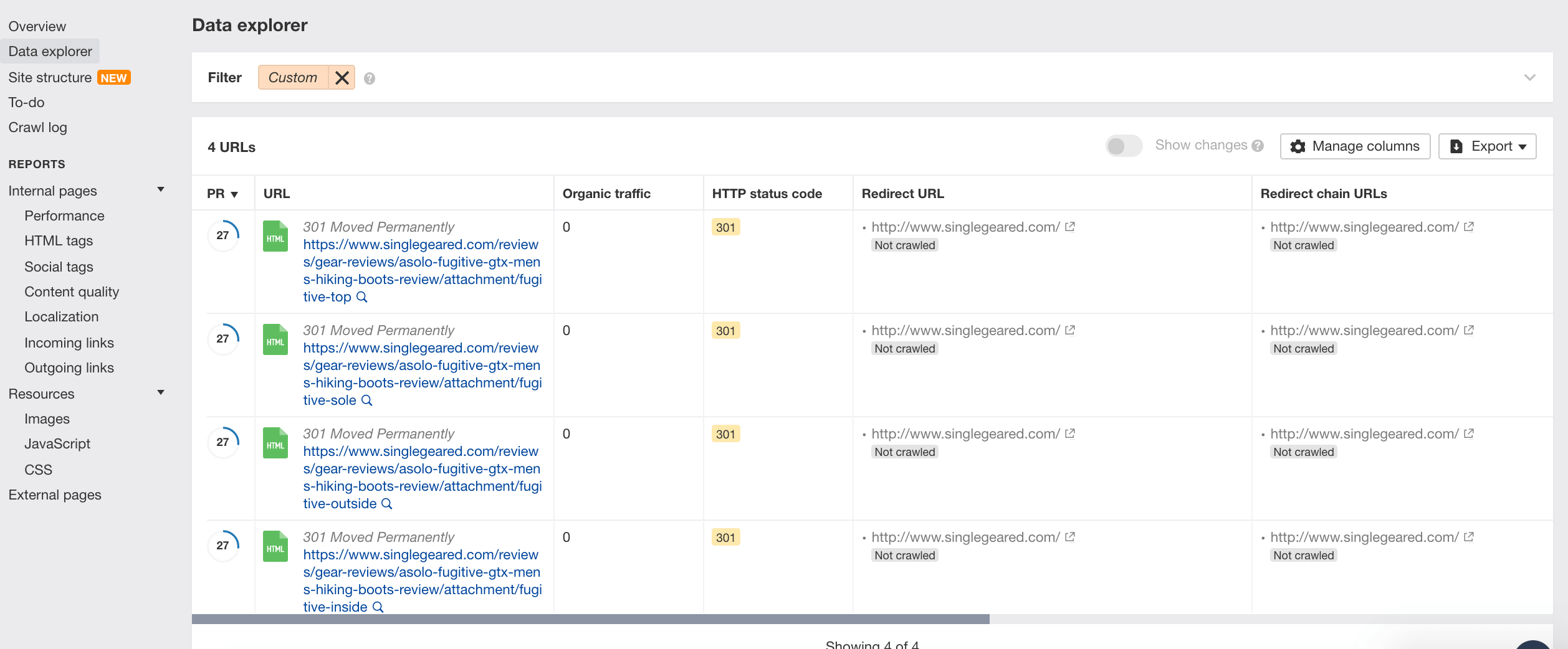
‘To-Do’ On Ahrefs
Next up are To-dos.
This isn’t a prioritized list of features like I assumed at first, but rather a way to mark an issue as a “to do” for your developers, collaborators, and other stakeholders.
Once you add an issue, it appears on this tab. Basically, it’s a project management list for SEO issues within Ahrefs.
Mildly useful as SEMrush’s alternative is to add issues to Trello.

Crawl Log
And finally is the Crawl Log.
You can see the difference between crawls, which can be useful for seeing progress – or when an issue gets a lot worse.
This feature can be very useful for diagnosing traffic drops and identifying specific reasons and time periods for those falloffs.
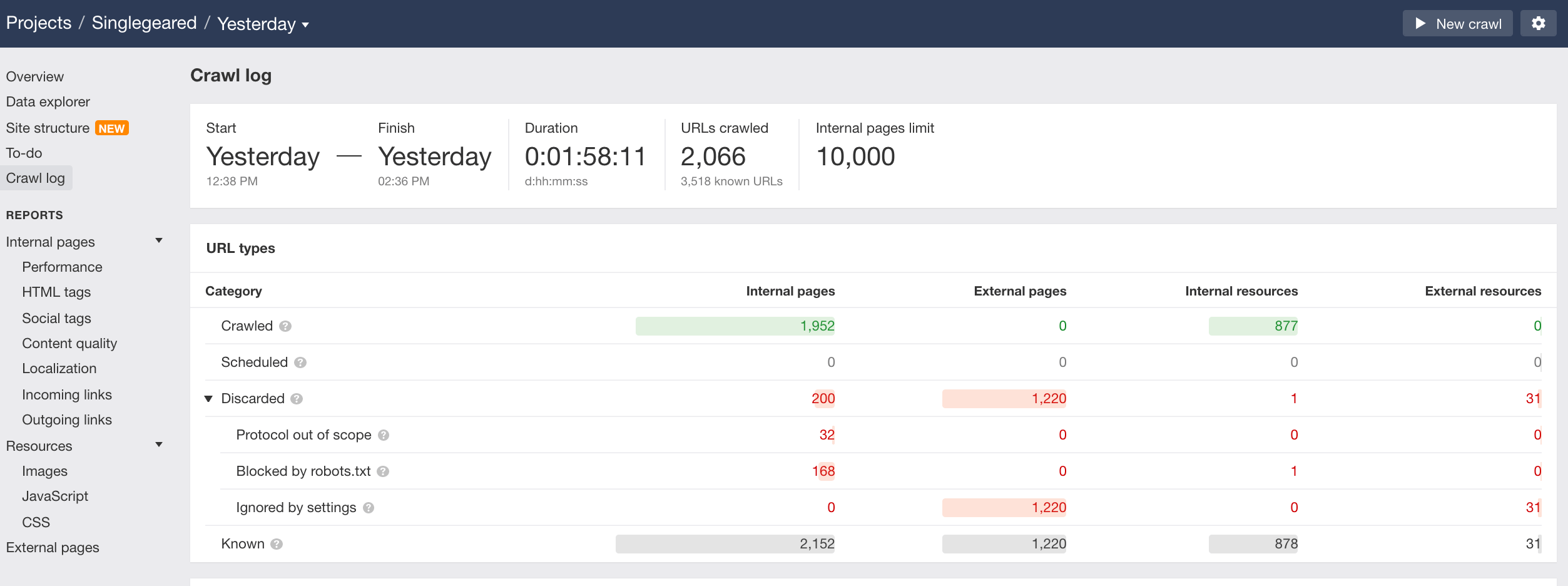
Winner: Toss up
I have to be honest.
Both of these tools rock (which is why we use both at Credo).
Each offers something different, and I find that each flags up different issues that the other doesn’t identify.
I like SEMrush’s data and how they structure things through the audit.
Their Trello integration is very useful for my workflow and I actually like the somewhat simplistic display of data.
For a beginner, this might be offputting or overwhelming.
Ahrefs brings insights to the surface quicker often, but some of their tools (like Site Structure) do not go as granular as I often want.
So honestly, I can’t pick a winner. Use the one that works best for your needs.
Keyword Research: Ahrefs vs SEMrush
Keyword research is the next pillar of SEO and one that everyone comparing SEO tools should look at.
Great keyword research will drive your content strategy, information architecture, and overall digital strategy.
The first two (content strategy and information architecture) help you rank as well as possible (and when coupled with solid technical SEO and link acquisition, you’ll really win).
So, let’s compare Ahrefs vs SEMrush for keyword research.
Keyword Research with SEMrush
In our guide to keyword research with SEMrush, we cover many of the keyword research tools and processes available within SEMrush.
With a keyword database of over 10.6 billion global keywords, there’s a lot to work with.
At a top level, SEMrush has five main ways to do keyword research and discovery:
- Overview research tool;
- Keyword magic;
- Find Keyword difficulty;
- Keyword gap;
- Self and competitor keyword opportunity analysis.
Let’s look at each of these in order.
Keyword Overview Research Tool
SEMrush’s Keyword Overview Research Tool is a tool for diving deep into an individual keyword to see its volume, trend, SERP, ads and ad copy, and phrase match and related keywords.
Here’s what the tool returns for a specific jacket from ‘The North Face’:
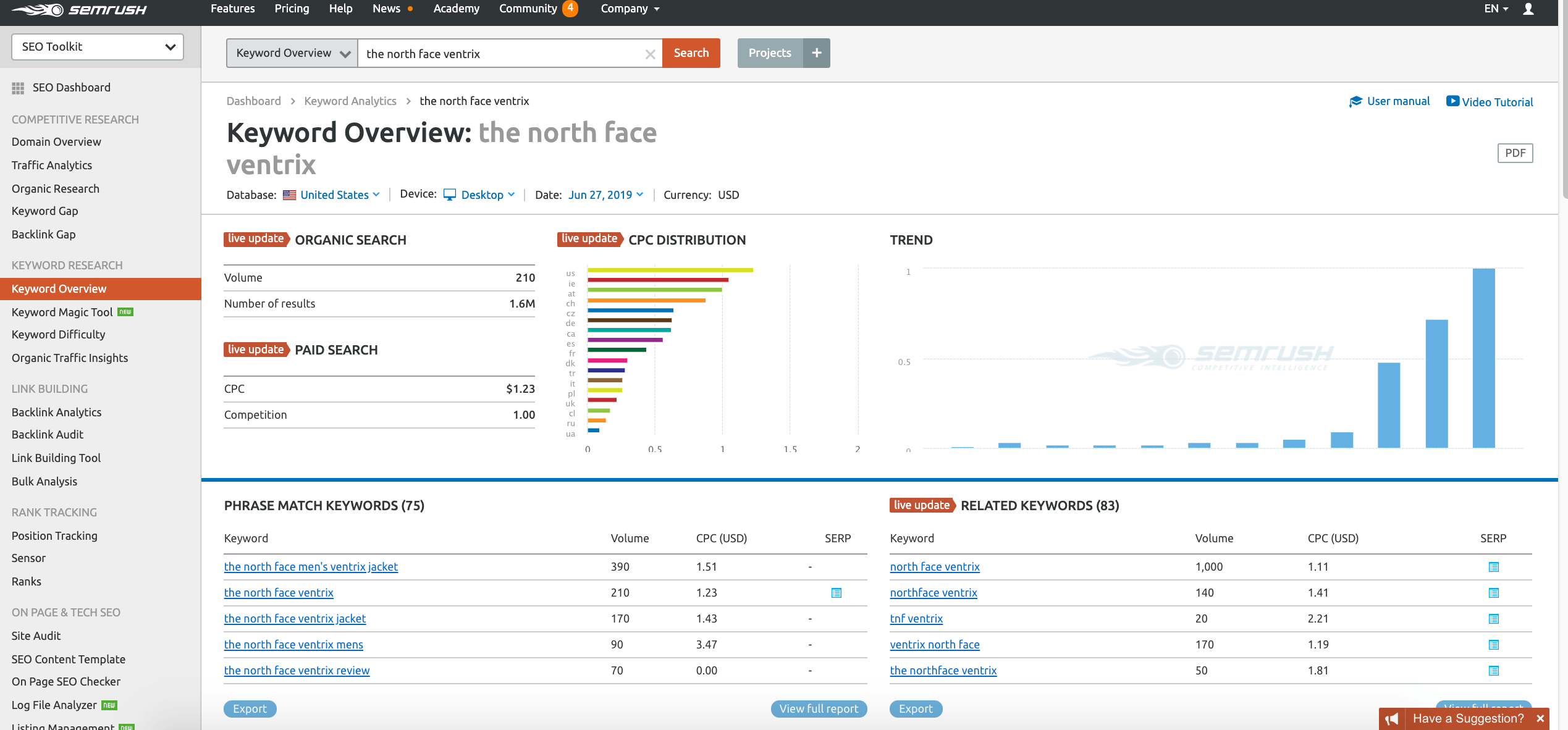
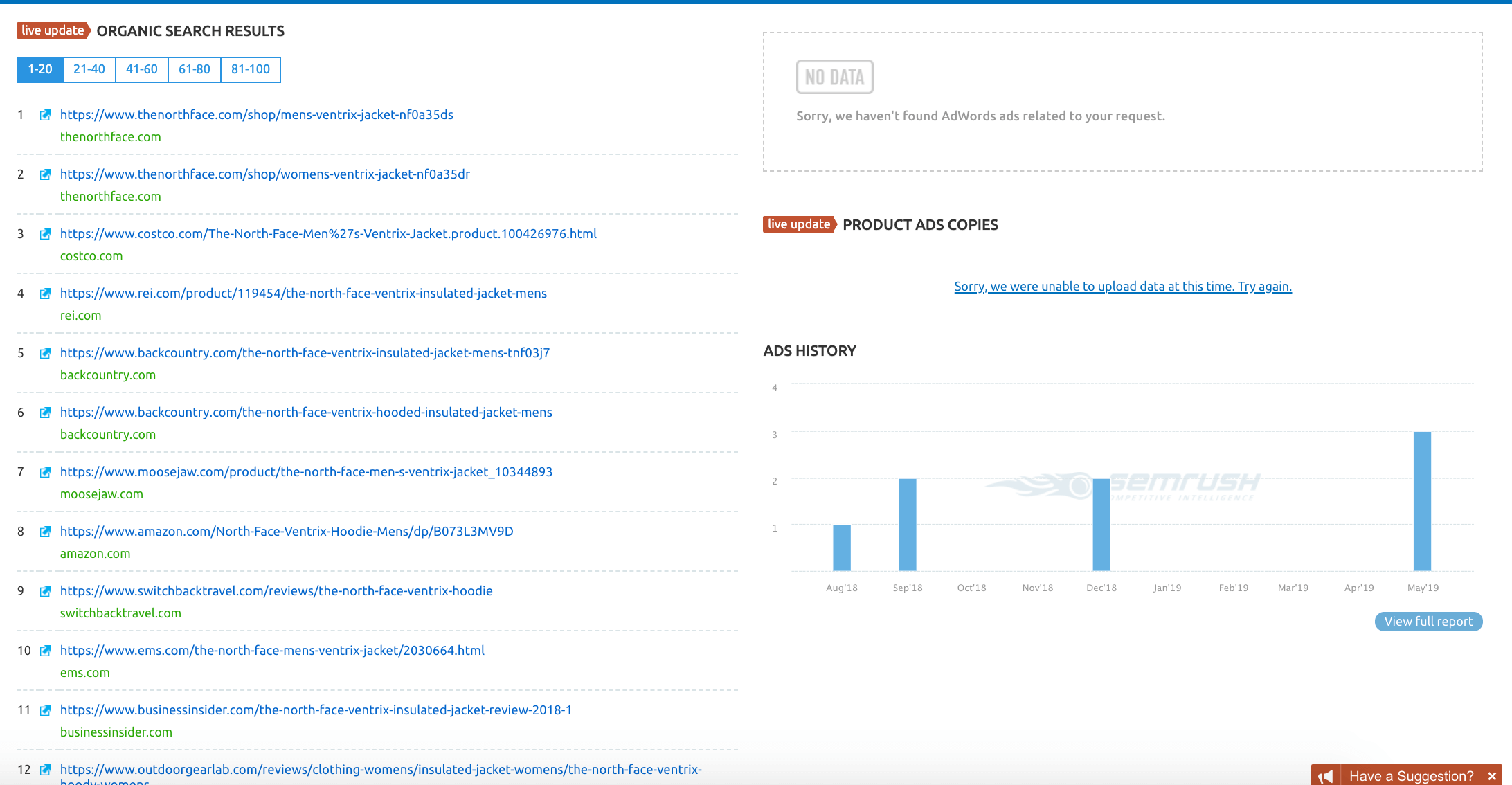
This tool is mainly useful once you’ve discovered your keywords.
You can then go deeper to find related keywords that you may not have thought of – or that you may be able to build pages for to target.
For example, for this specific jacket, an ecommerce store targeting it should also be sure to build out pages for both men’s and women’s versions.
They should probably also target “hoodie” and “review”:

As mentioned, this tool is great for looking at individual keywords, though keyword difficulty would be a useful metric on this display.
But what happens when you first need to build a list of keywords?
Enter the Keyword Magic tool. For it is, indeed, magic.
Keyword Magic Tool
SEMrush released the Keyword Magic tool in 2017.
It was a big step forward for keyword research, as it actually began helping digital marketers do topic research and not just keyword research.
Here’s how it works:
Put your keyword (if you can, a higher level topic like I use in this example) into the box, select your target country keyword database, then hit ‘Search’:

You’ll be taken to a list like this:
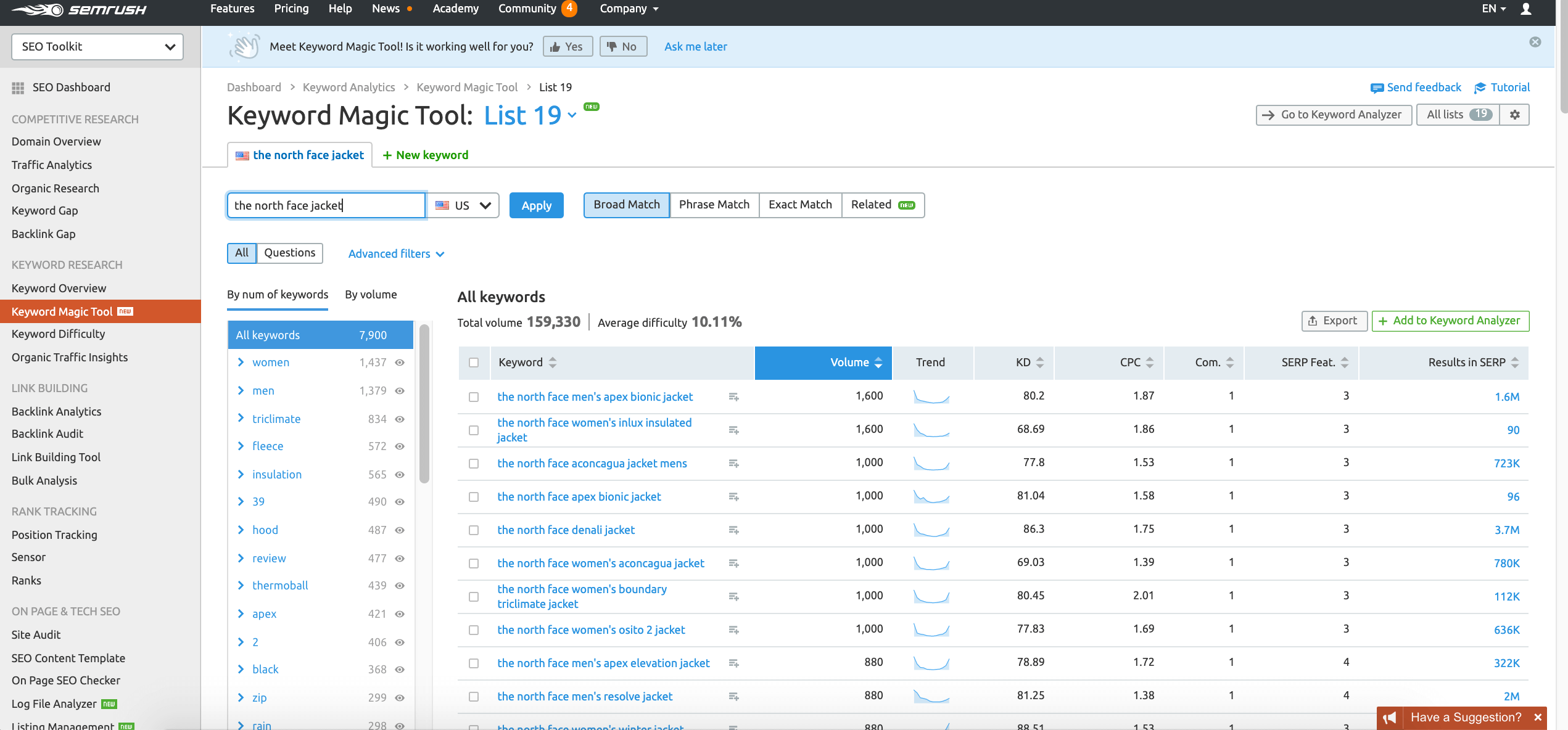
Basically, SEMrush has done a ton of work to help you find the various categories around that keyword.
In this case, information like gender, individual jacket names, jacket types (“triclimate”, “fleece), and more.
There is also a full list of keywords that you can filter through to target.
Each keyword also has:
- Keyword
- Volume
- Trend
- Difficulty
- CPC (cost per click for Google Ads)
- Competition
- # of SERP features
- # of results for the query
It is also then quite easy to add keywords to the SEMrush Keyword Analyzer i.e. your list as you do research.
Filter down to the area you’re investigating, select them with the checkbox, and click “+ Add to Keyword Analyzer” in the top right:

Then you get to your set of keywords which you can then export, send to other tools (like Position Tracking or the PPC Keyword Tool), or just keep to reference.
Keyword Difficulty
SEMrush’s keyword difficulty tool is pretty straightforward.
You put in a list of keywords and the tool spits out each keyword:
- Difficulty
- Volume
- # of Google search results
- Search Results Page (SERP) features
Here’s how it looks:
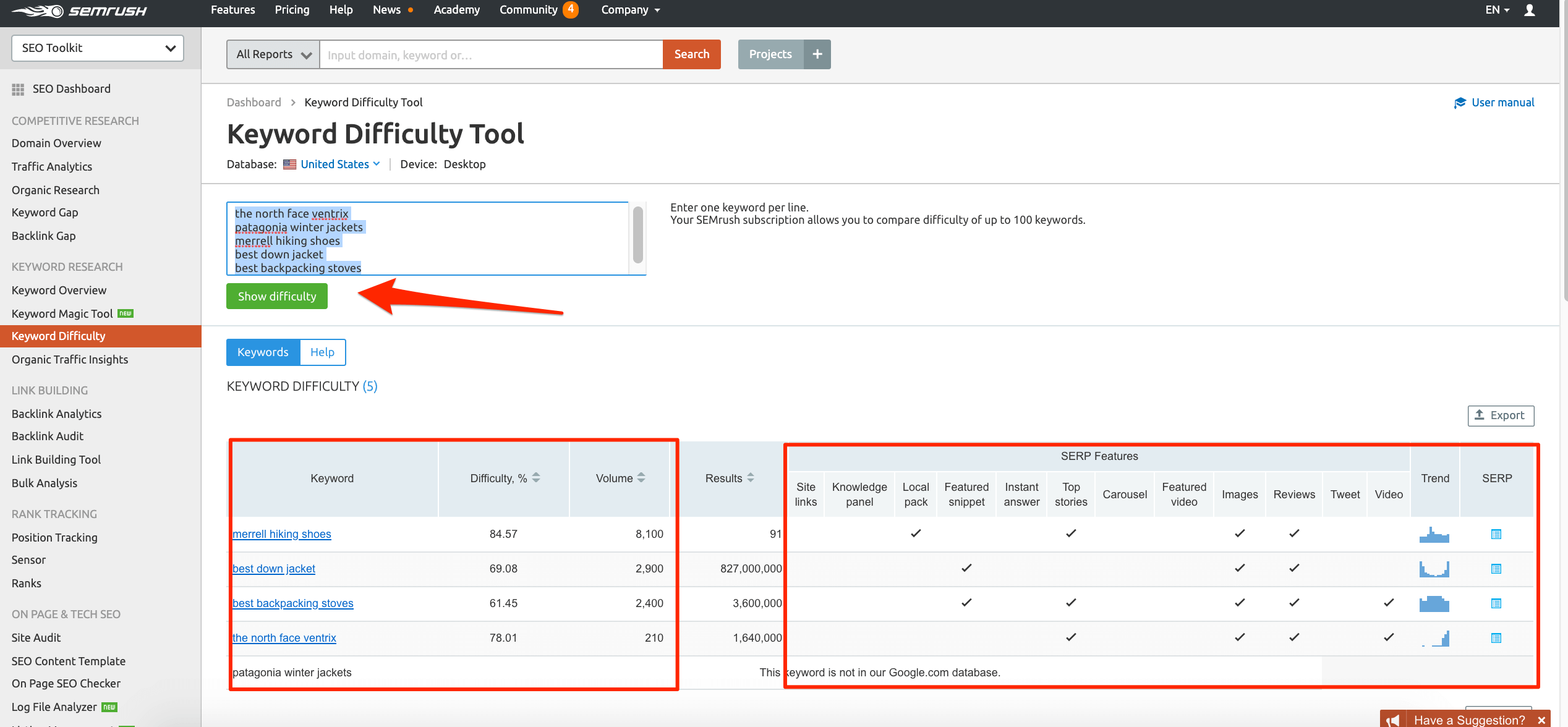
Of course, SEMrush doesn’t tell us exactly what goes into calculating their difficulty score.
This type of score is also expected within a tool, first pioneered by Moz and now copied by everyone (with their own unique take on it).
SEMrush though does tell us that:
The score is a percentage from 0 to 100 and the higher the percentage, the more difficult SEMrush predicts it would be to rank for. To calculate keyword difficulty, SEMrush takes into consideration the authority of the domains that are showing up on the results page and then estimates how hard it would be for a new website to outrank its current competitors on the SERP.
While that’s great and all, this tool is relatively straightforward and simple; limited and moderately helpful, at best.
My favorite part is the ability to see SERP features by individual keyword in a layout like this, which could help with SEO as you can rank better and improve your clickthrough rates for your rankings.
Keyword Gap
Another one of SEMrush’s keyword research tools (which they put under Competitor Analysis) is the Keyword Gap Tool.
To use this tool, select it from the left sidebar then enter in a competitor domain and your domain (or, a bunch of competitors).
You will then see this view:

Here, you can basically see that the competitor site has far more keywords for which they are ranking than my site.
I can also see all of the keywords we have in common.
This is useful but doesn’t really help me be proactive with targeting new keywords with new content.
So I can click on my competitor’s site, and then I like to just look at keywords ranking on the first page.
You can also do “less than 21” for the second page and so on:
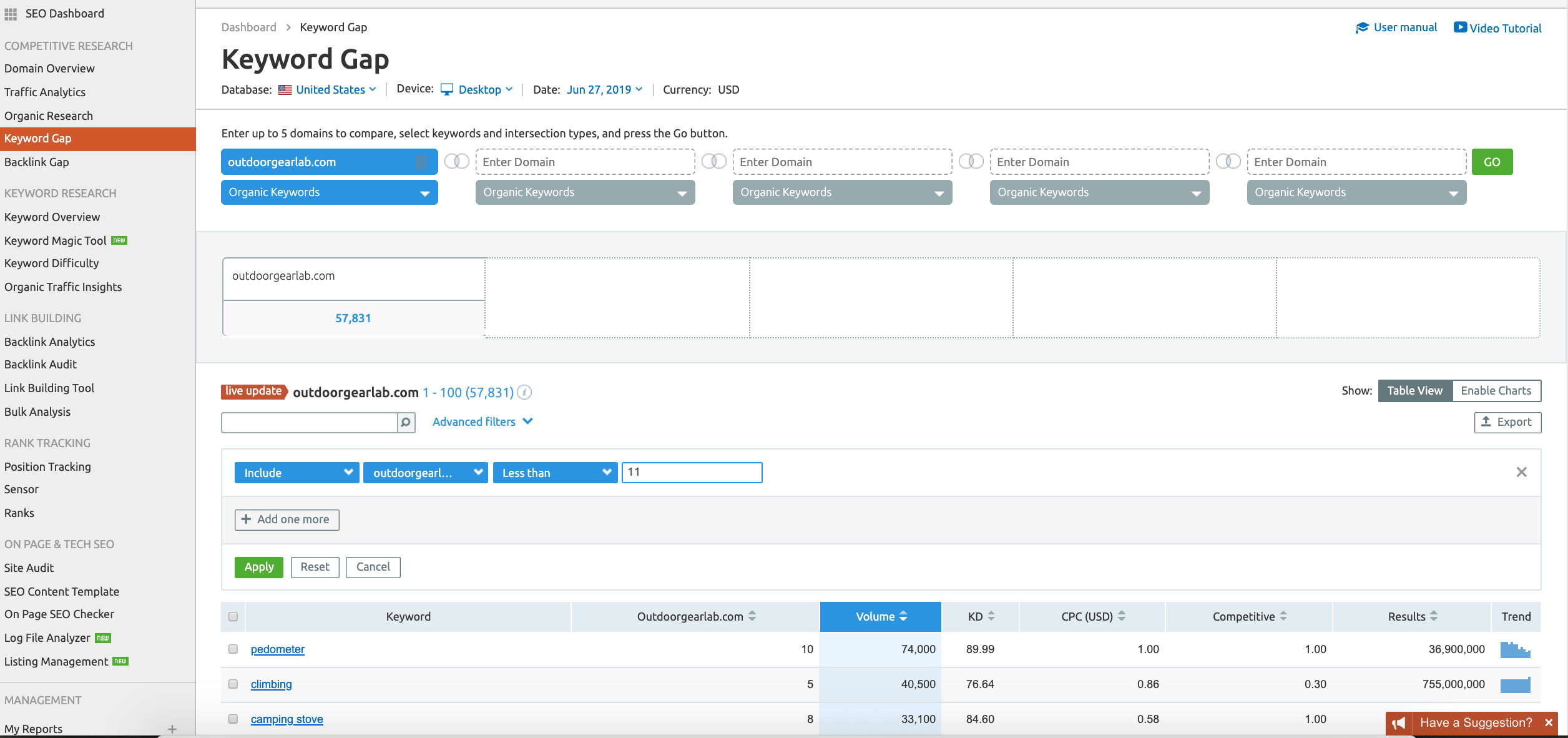
If you want to change the filter to show the keywords unique to the first domain (e.g. keywords your competitor ranks for, but you don’t) then you should click the two overlapping circles and change it to “Unique to the first domain”.
Then filter down to keywords ranking on the first two pages and voila.
You know now which keywords your competitors have deemed worthy of creating content/ranking for that you have not yet targeted.
For example, I can filter down to keywords my competitor ranks for that I don’t, where my competitor ranks on the first two pages and the term contains the word “best”.
Just like that, I have a lot of content to go create:
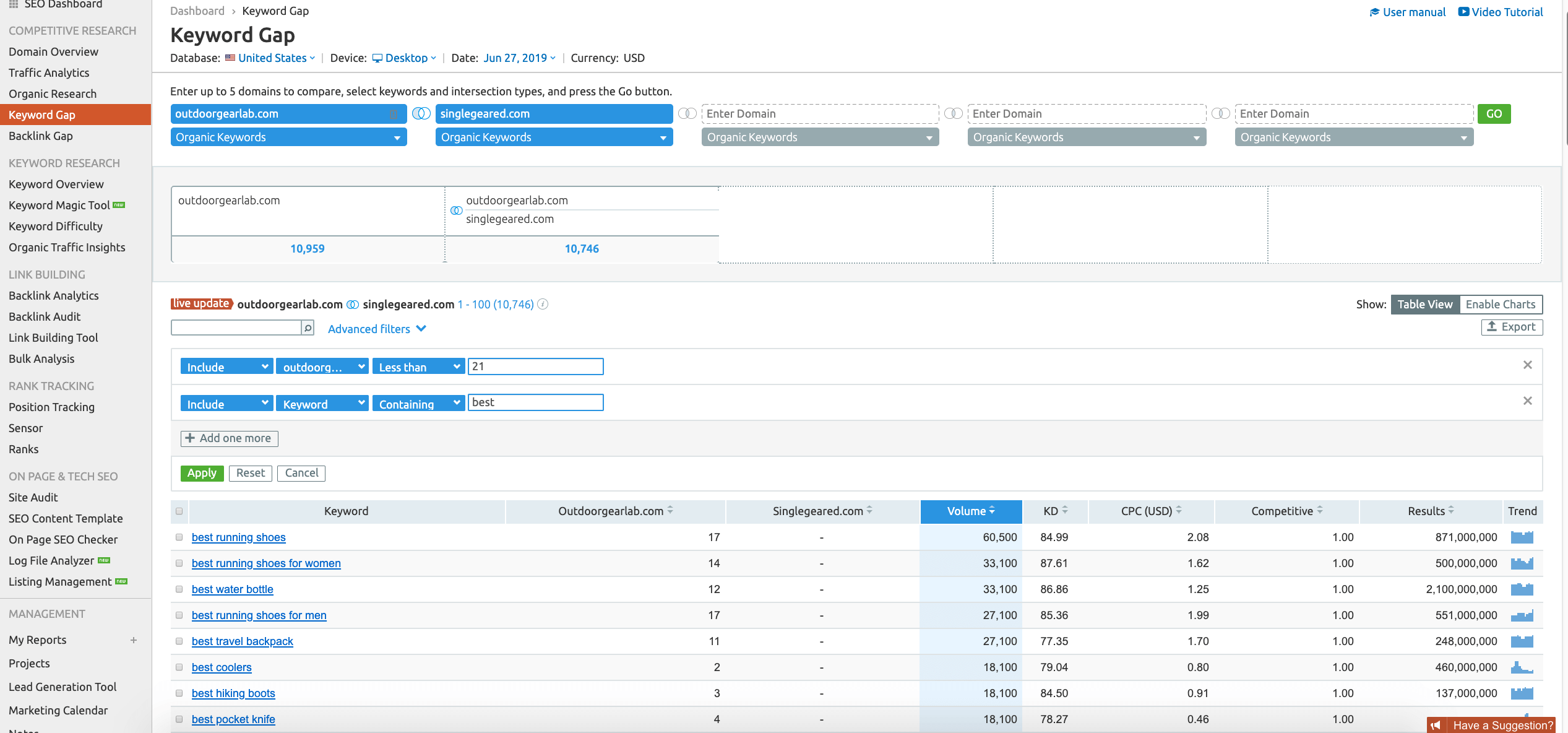
Self and Competitor Keyword Analysis
Finally, you can also do your keyword research manually by looking at your own keywords that you rank for but maybe not with a dedicated page, or the keywords your competitors rank for.
To do this, go to Domain Overview and enter your domain.
You’ll see this view:

Then click into ‘Top Organic Keywords’, and filter down to rankings higher than 20 (basically, anything not on the second page).
Depending on your domain, you may need to go to 30 or higher:
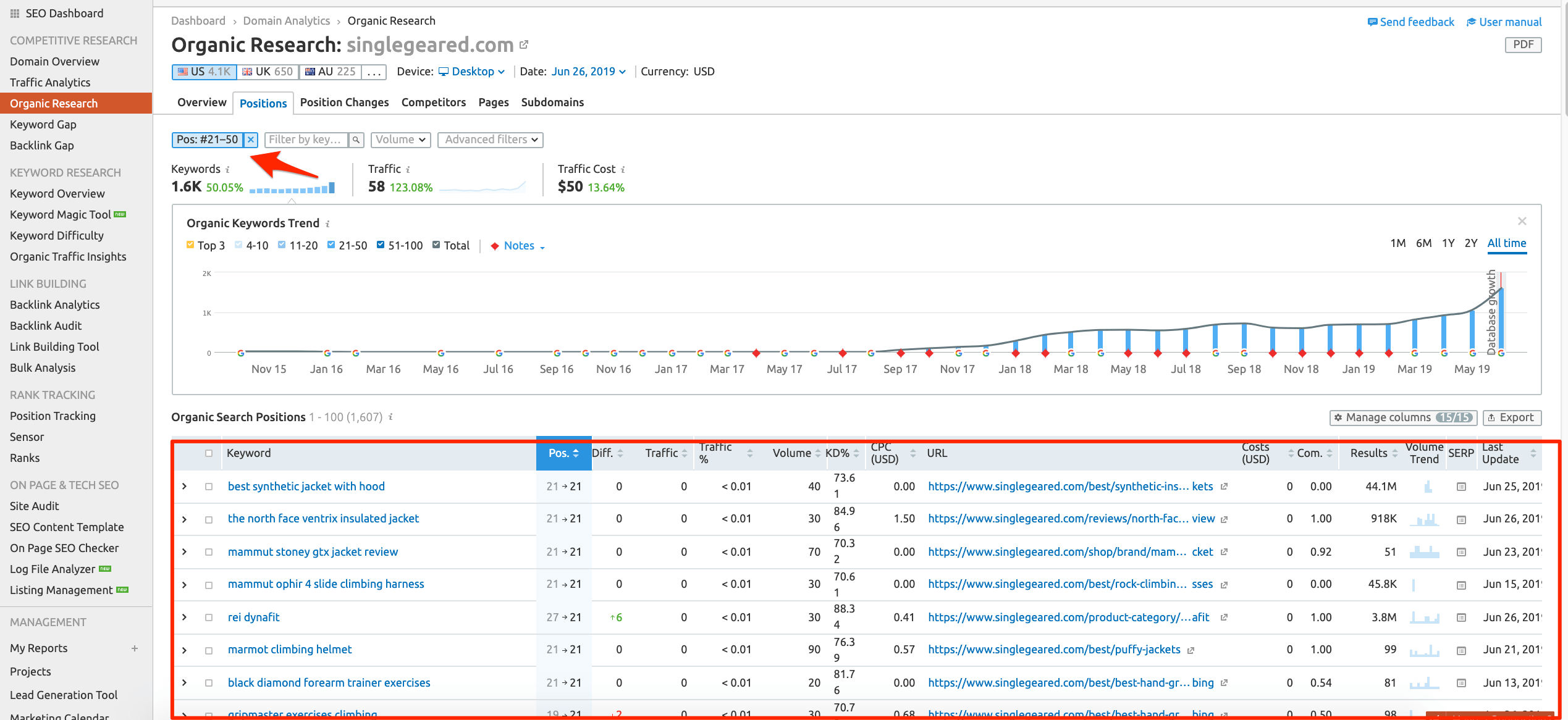
Now I have my list of keywords to look at where I may need to adjust the ranking page or build a whole new page to target the terms.
Keyword Research with Ahrefs
Now that we’ve covered SEMrush in-depth, let’s look at Ahrefs’s keyword research tools and how to use them.
Ahrefs has 7.9 billion keywords across 10 search engines and 171 countries (according to this page).
Therefore, it’s smaller by about a third than SEMrush, but how do their keyword research tools hold up?
Ahrefs has these main keyword research tools:
- Keywords Explorer;
- Content Gap;
- Organic Keywords, with New and Movements.
Let’s look at each.
Keywords Explorer
Ahrefs’s main keyword research tool is Keywords Explorer.
When using this vs SEMrush’s Keyword Overview, I actually usually find myself preferring the Ahrefs tool because of the cleaner UX.
You enter your list of keywords then hit the magnifying glass search button:
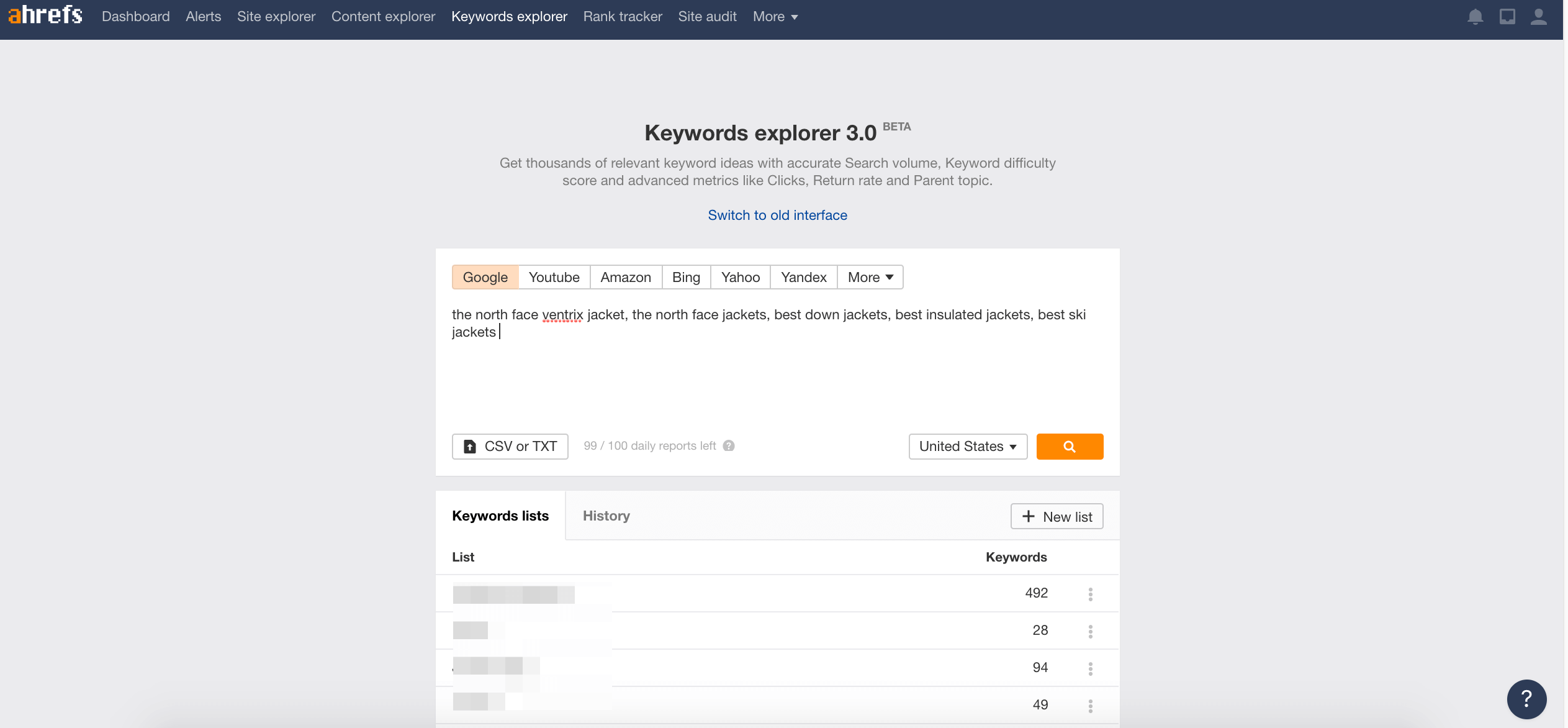
Then you’ll be presented with a view like this:

When you click on the + mark beside each, you can then add the keyword to a list:
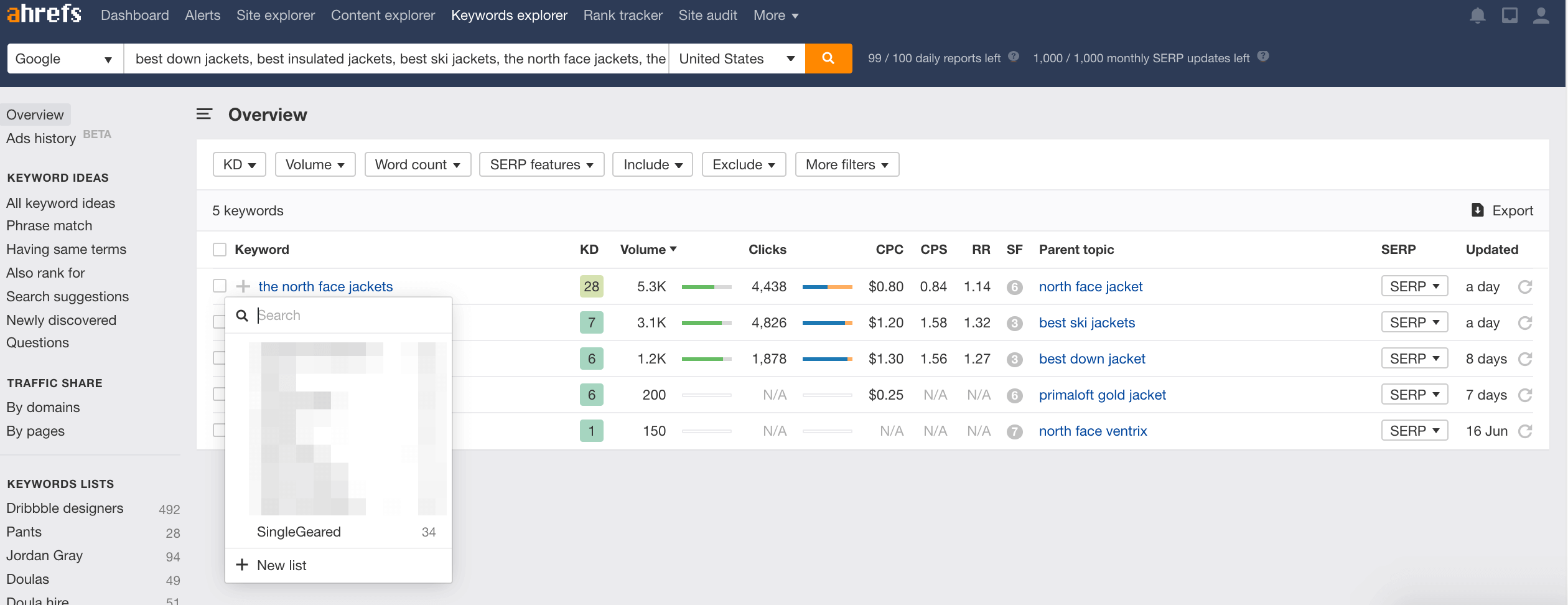
To go deeper into a topic, click on the “Parent Topic”.
For example, “best ski jackets”:
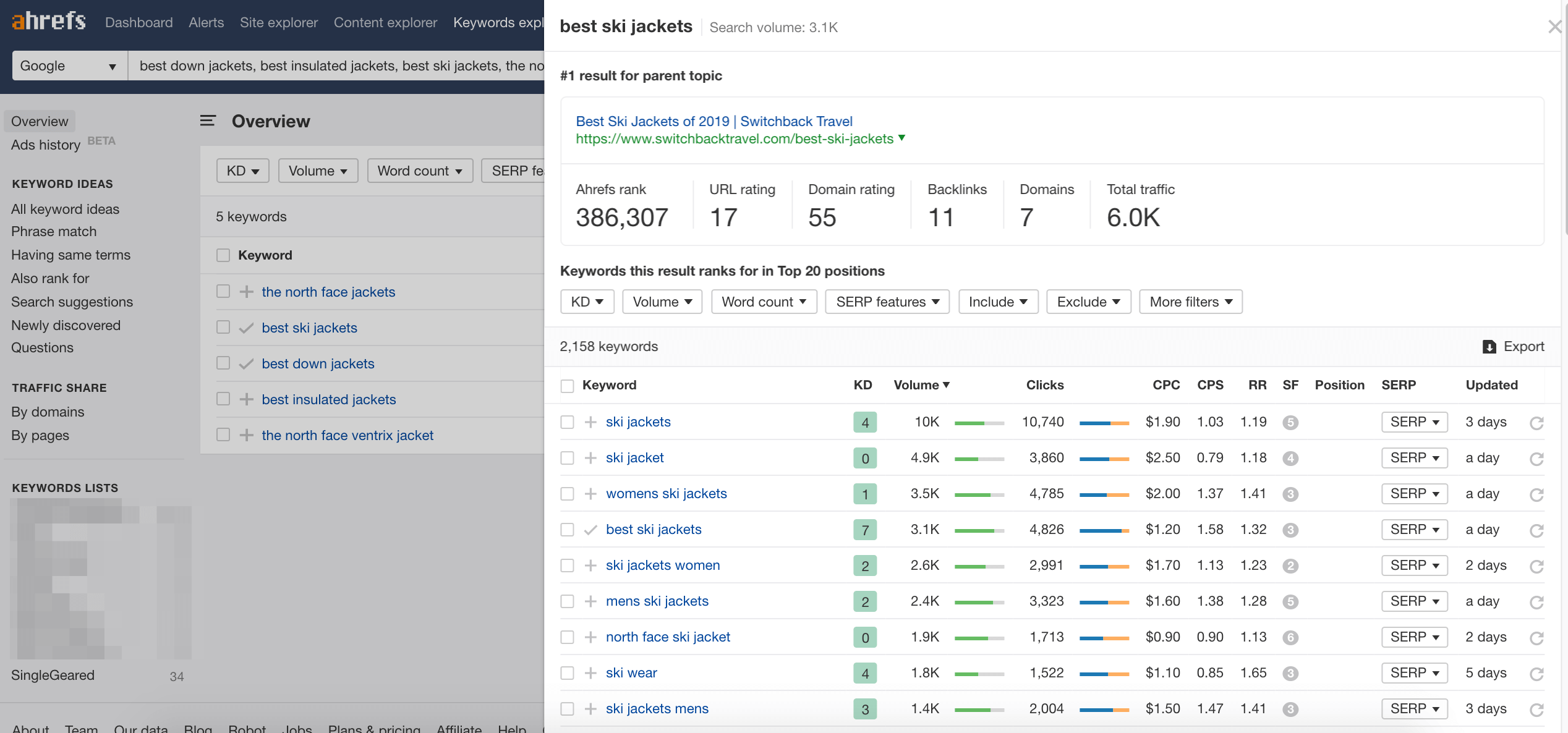
Content Gap
Ahrefs Content Gap tool is found on the left side under “Organic research”.
You put in the domain you’d like to research as well as the domain you’d like to look at but does not rank for the same keywords:
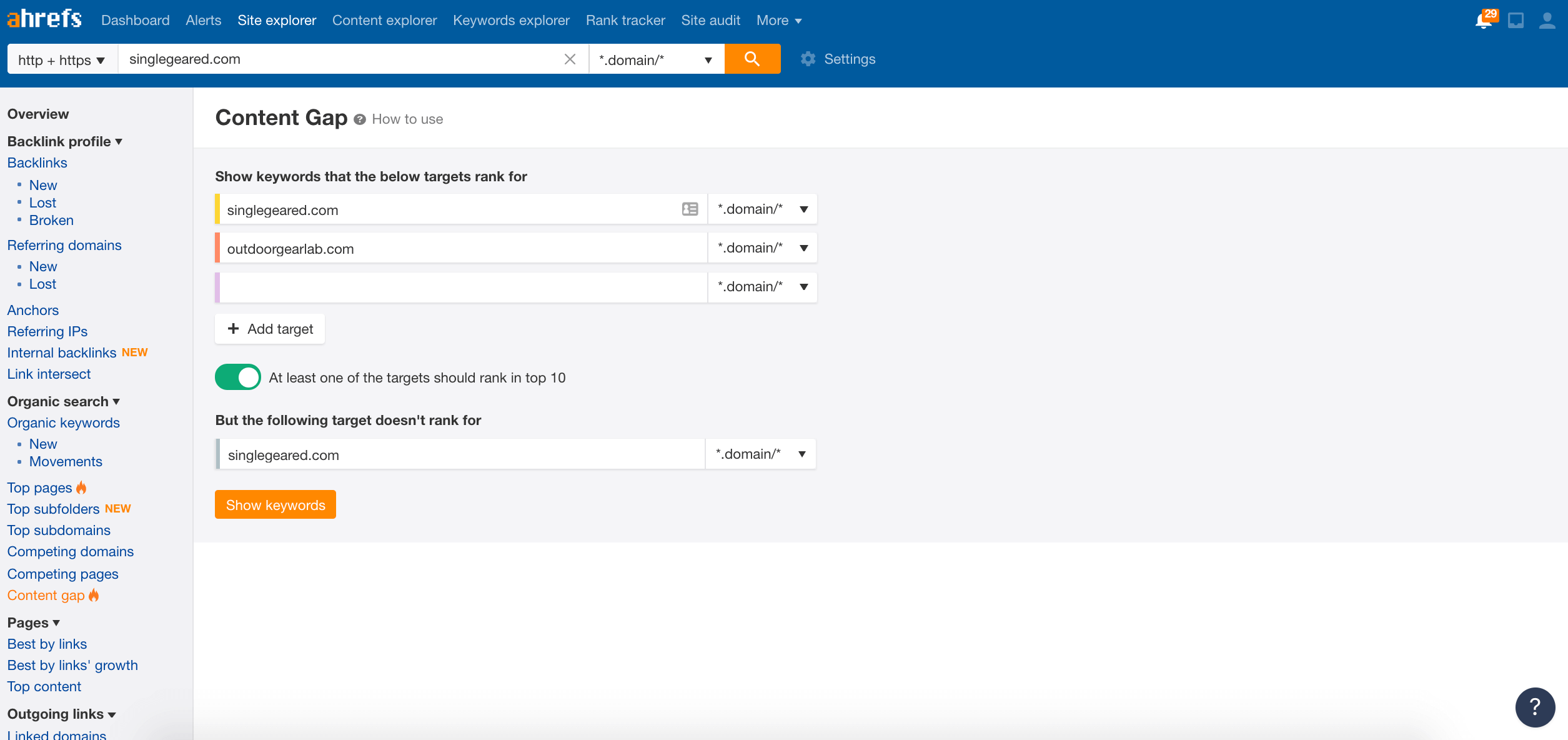
You’ll then get a view like this (which I’ve filtered to only “best” keywords):
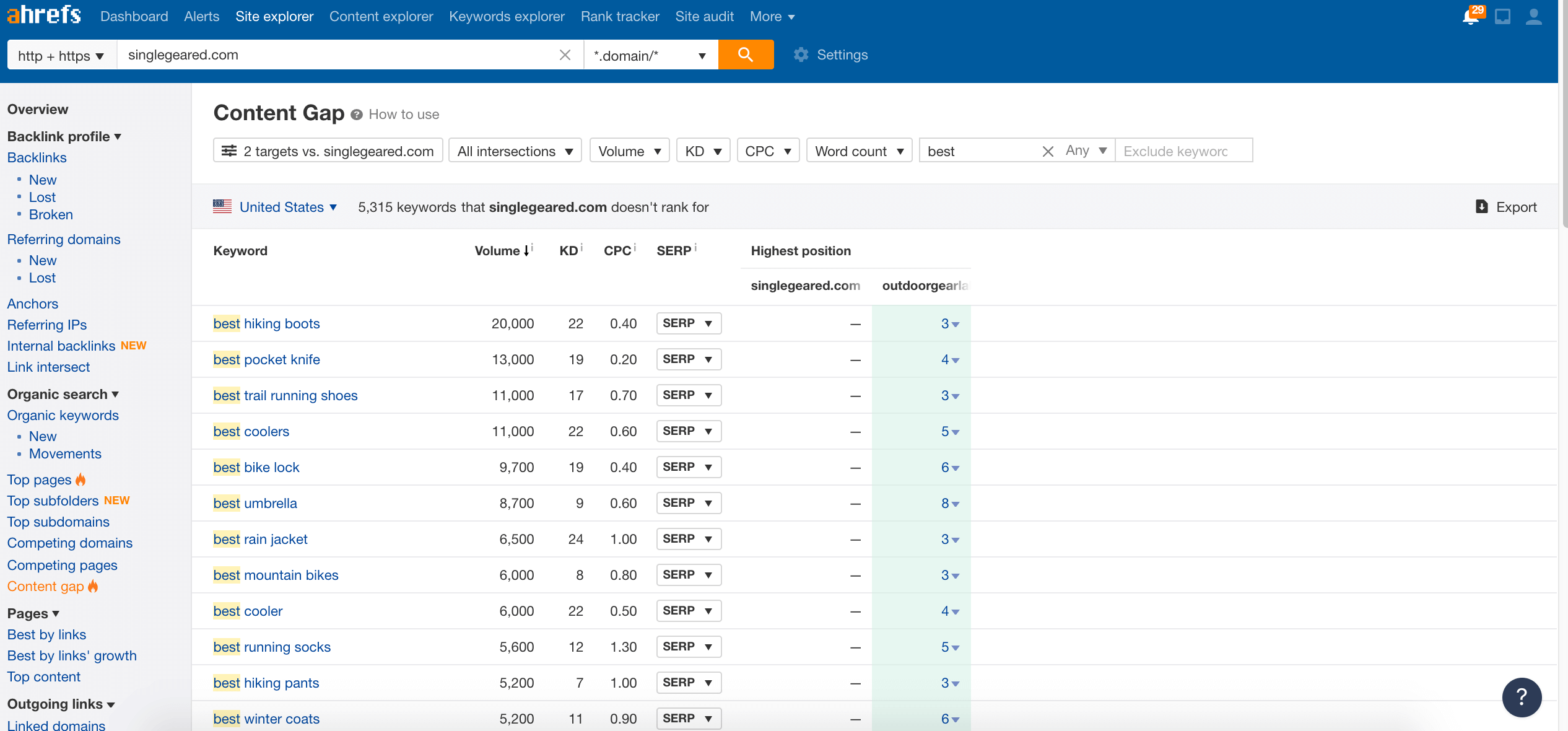
The option here now is to export and manage elsewhere.
Organic Keywords/New/Movements
Within your own domain, you can also look at your own organic keywords to identify those for which you are ranking
Look up your site using Site Explorer, then click Organic Keywords and filter to keywords ranking from 21-100:
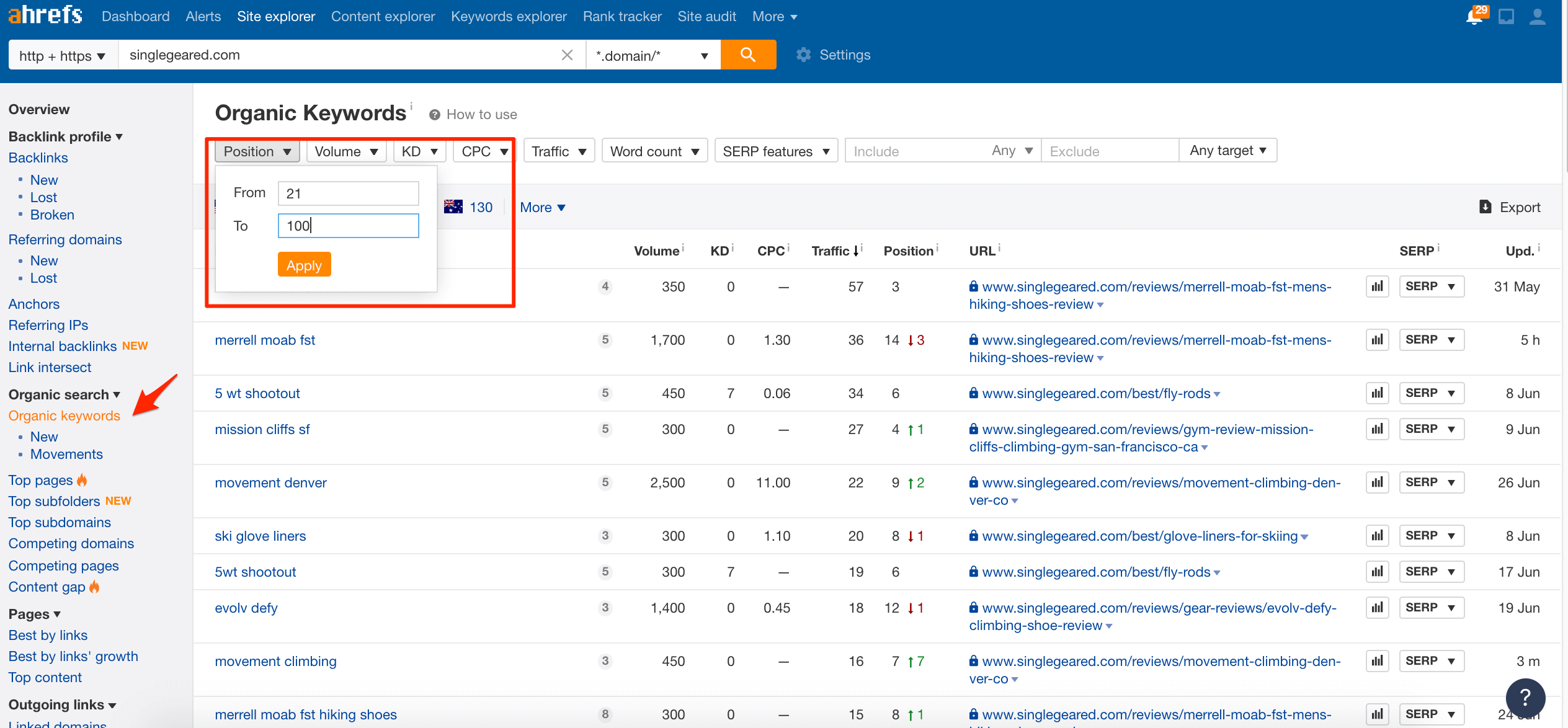
You can then export and copy/paste into Keywords Explorer, but you can’t add a keyword to a keyword list from this view.
You can also see your keywords that are moving:
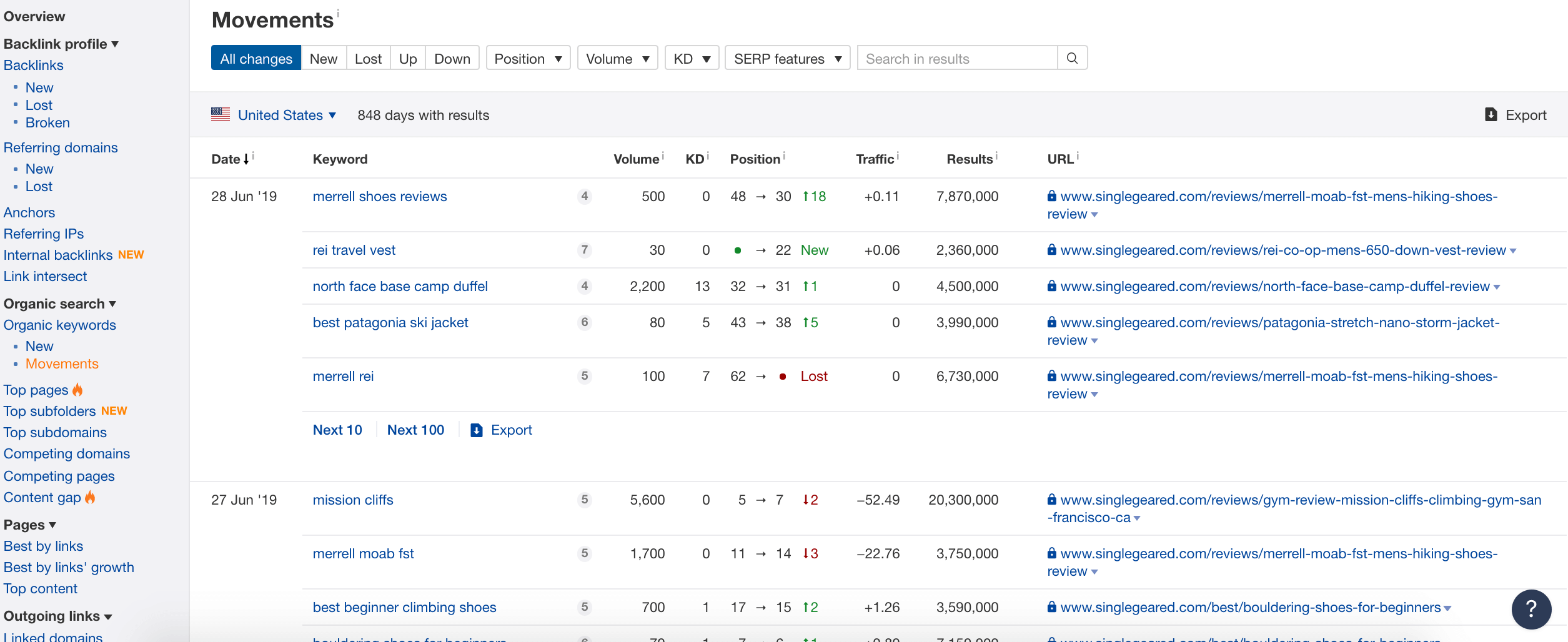
That’s a nice report to see, but it’s also kind of a vanity report because there’s no context around it.
Winner: SEMRush
So who wins with their keyword research tools, Ahrefs or SEMrush?
In our opinion, SEMrush wins the keyword research comparison.
They’ve invested a lot of time and effort into their tools and machine learning, and while their UX isn’t as good and the keyword research workflow is a bit disjointed, you can discover more keywords in less time.
Ahrefs looks better and has a better UX, but in our opinion, they’re still way behind in this part of their toolset.
Competitor Research: Ahrefs vs SEMrush
Competitor research is the next pillar of SEO, as it informs your overall SEO strategy and especially your content strategy and link acquisition strategies. Thus, it is important to have good data on your competitors so that you can identify their SEO strategies and use that to inform your own.
So who wins with their competitor SEO research tools, Ahrefs or SEMrush?
Competitor Research with SEMrush
Within SEMrush’s platform/dashboard, there is a dedicated menu section called “Competitive Research”:

It contains five “tools”:
- Domain Overview
- Traffic Analytics
- Organic Research
- Keyword Gap
- Backlink Gap
Each of these is meant to either let you dive into a competitor specifically or to compare the competitor’s domain against yours (or domains of other competitors).
Using these tools, you should be able to gain a complete view of a competitor.
Let’s look at each tool.
Domain Analytics
First up is Domain Analytics, which is actually SEMrush’s main view on domains. Most people use it for their own domain (to see Organic visibility), but it is just as useful for competitor domains.
Let’s use my “competitor” Outdoor Gear Lab. Here are two screenshots of the dashboard view you see within SEMrush:
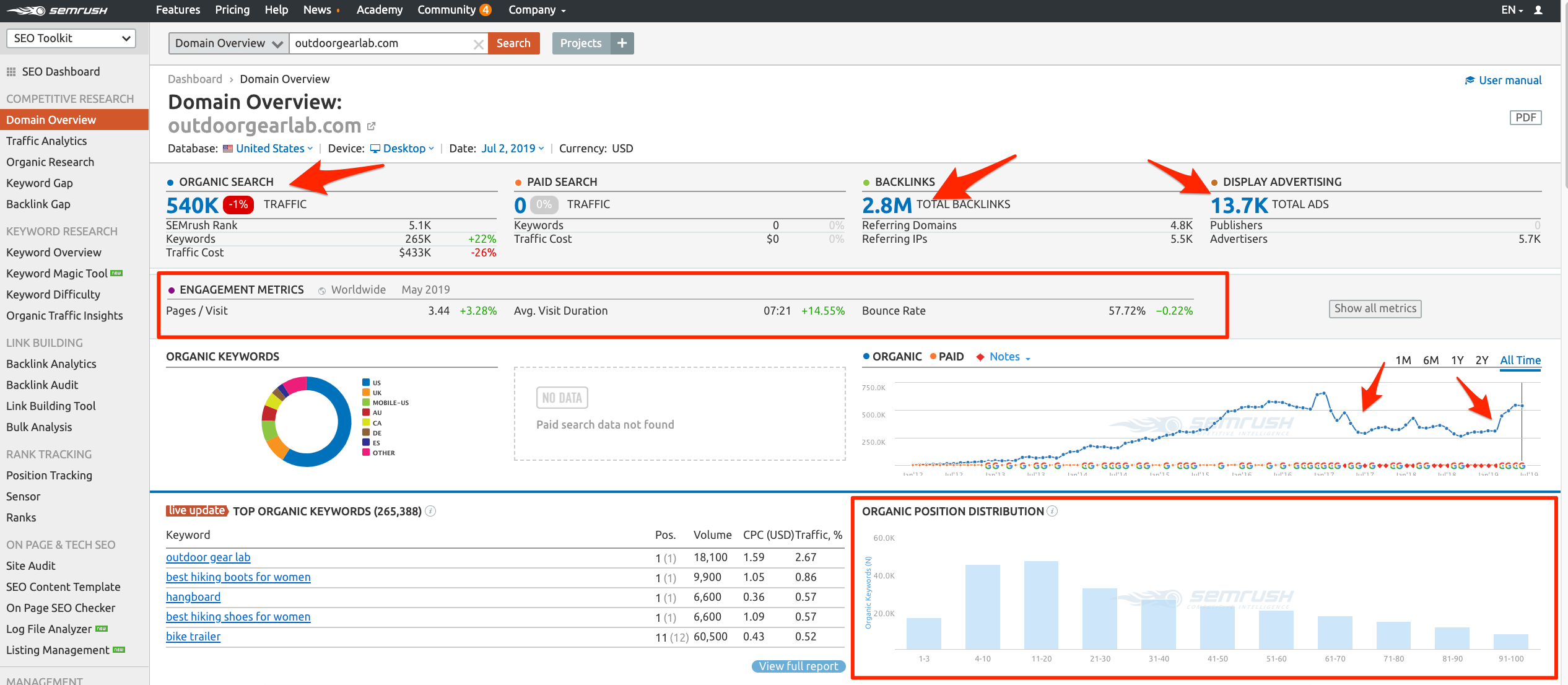
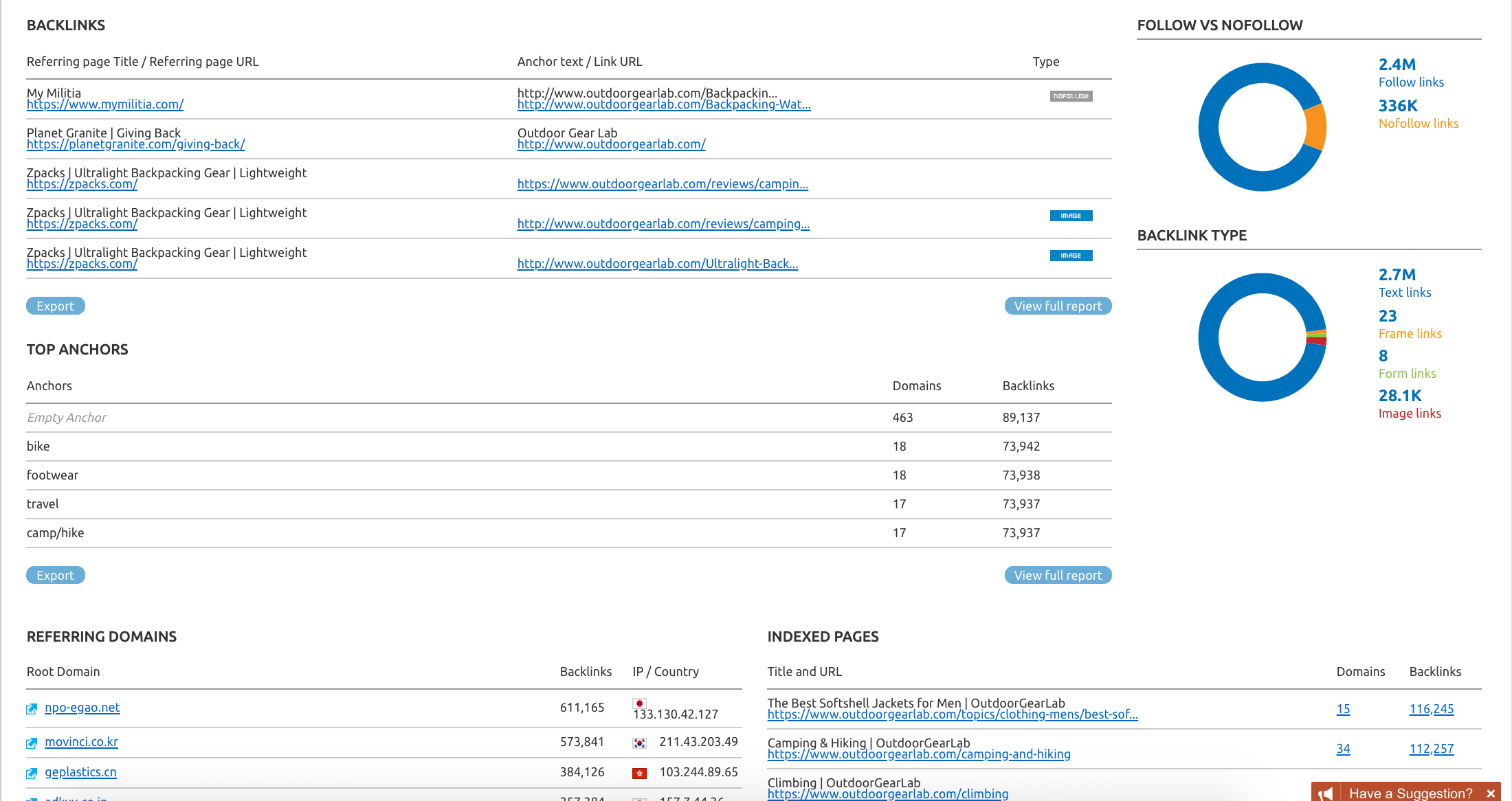
There is a TON of data here, covering a lot of areas including:
- Visibility (paid and organic);
- Main competitors;
- Competitive map;
- Main keywords (with subsets);
- Branded traffic percentage;
- Top backlinks;
- Followed vs no-followed link percentages (useful for determining how natural their backlink profile is);
- Indexed pages.
Each of these is a high-level view where you can then dig deeper.
For example, if I wanted to dig into OGL’s backlinks I could click on the Backlinks section which takes me to this page (technically called Backlink Analytics) and this view:
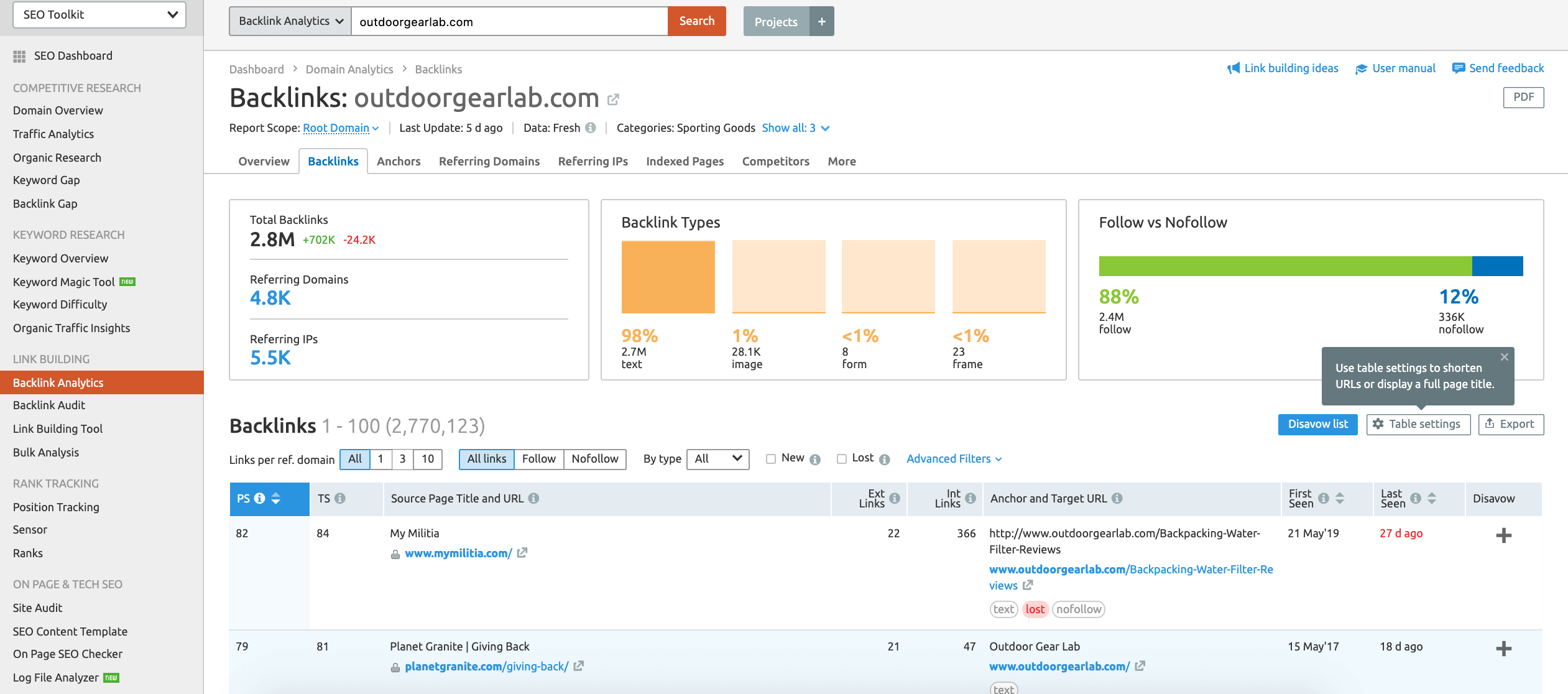
This gives me a good high-level view at the top and then all of their backlinks below with optional filters and follow/nofollow link views where I can get more granular.
I also really like the New and Lost checkboxes because these let me see where they are actively acquiring links and where they may have lost them (and I could swoop in to get them pointed to my own site).
That’s just one example of a deeper investigation you can do on a competitor to build your own SEO strategies.
Traffic Analytics
Next up is SEMrush’s Traffic Analytics which is useful for determining where your competitors are getting their traffic, their breakdown between organic/direct/etc, and even comparing competitors (and yourself).
Here’s the initial view across three screens:
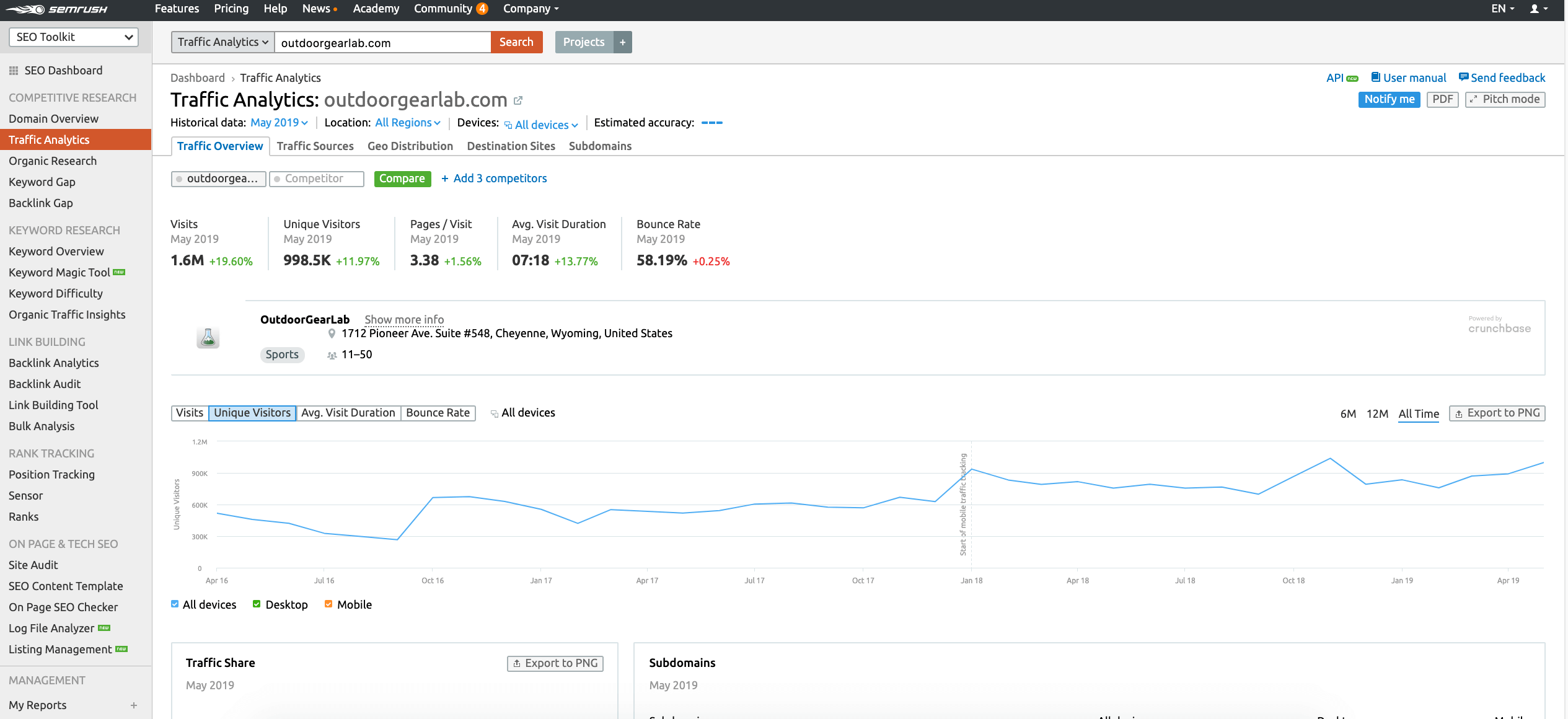
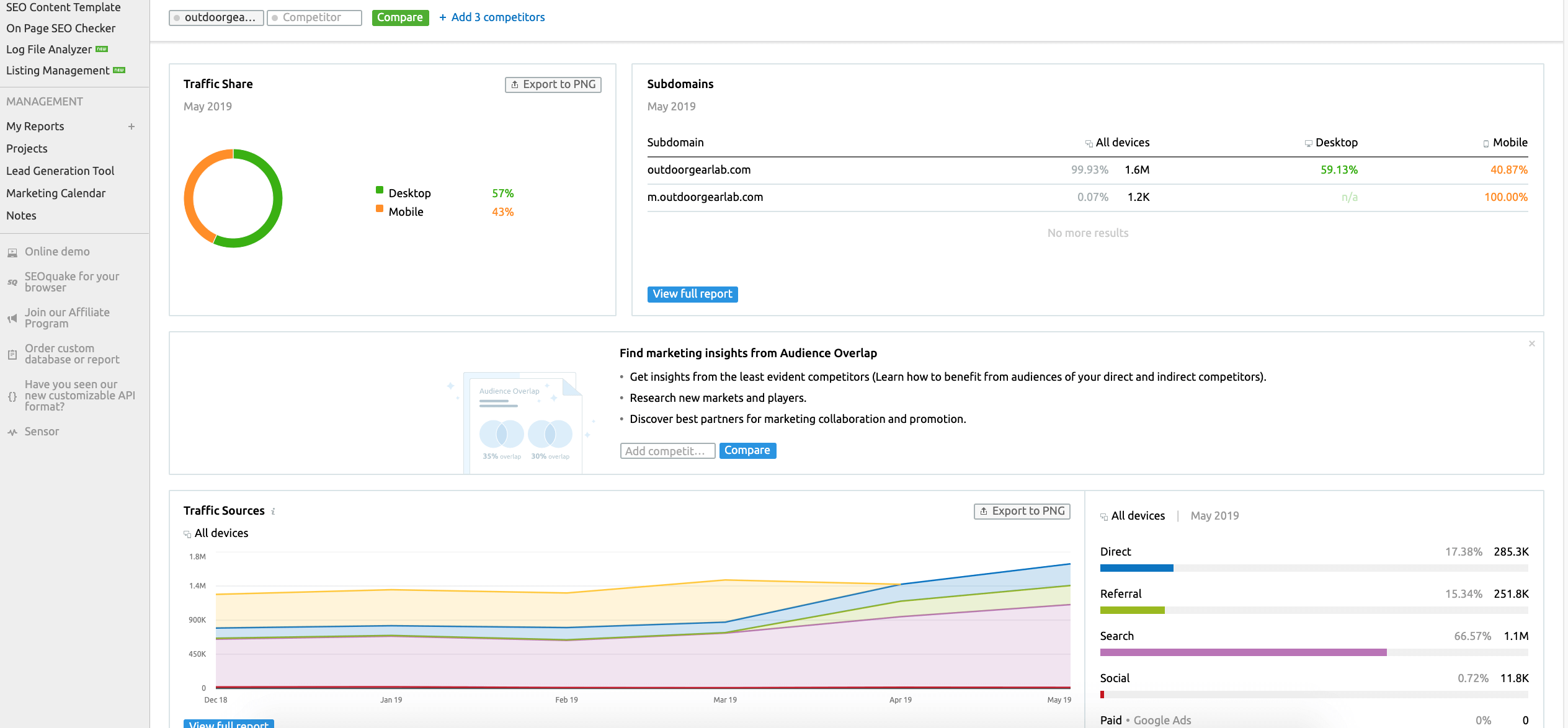
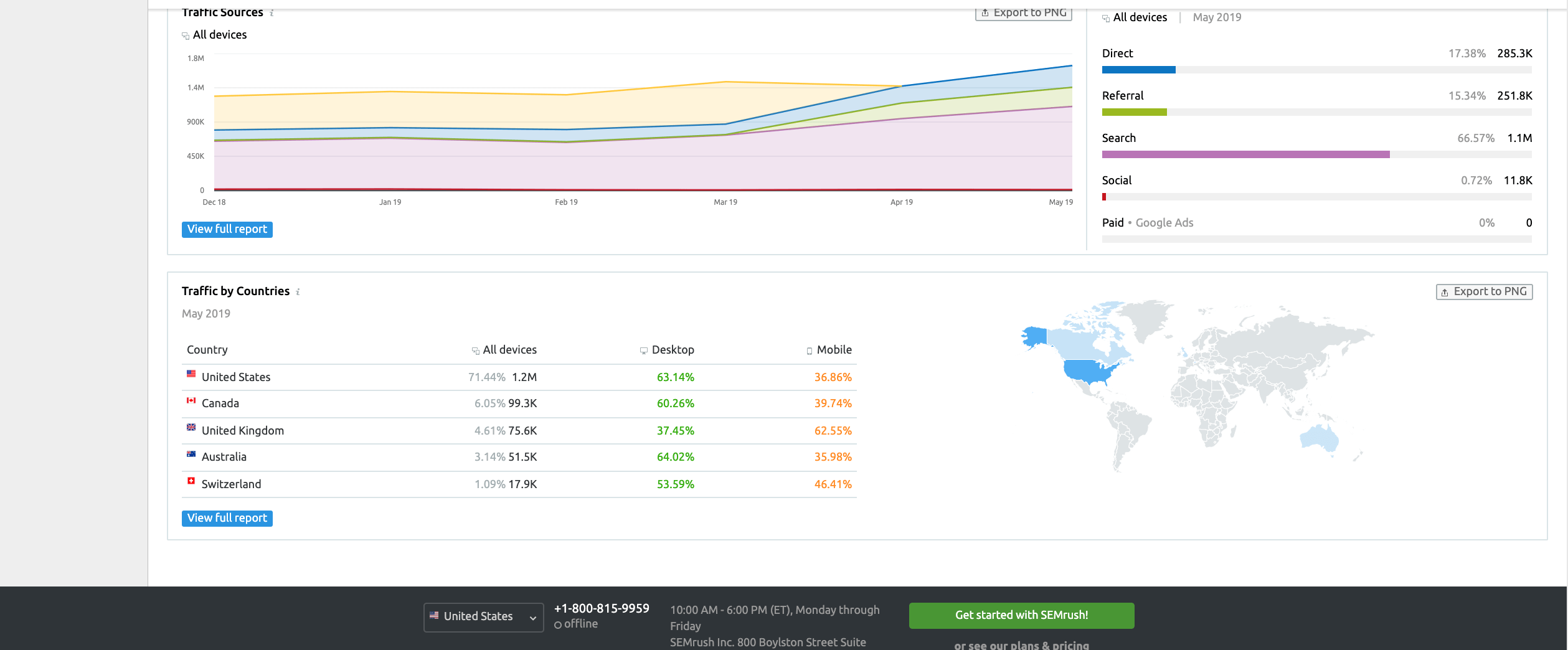
As you can see, SEMrush gives you insight into:
- Visits
- Unique visits
- Pages/visit
- Average visit duration
- Bounce rate
- Traffic breakdown
- Subdomains (if they exist)
All of this data used to take a subscription to another product to get, but now it’s been rolled into SEMrush.
Like any tool relying on third-party data like this, their numbers are not exact but are directionally correct especially when you also bring into account comparisons.
This is a feature I recently discovered within Traffic Analytics, and here’s how it looks:
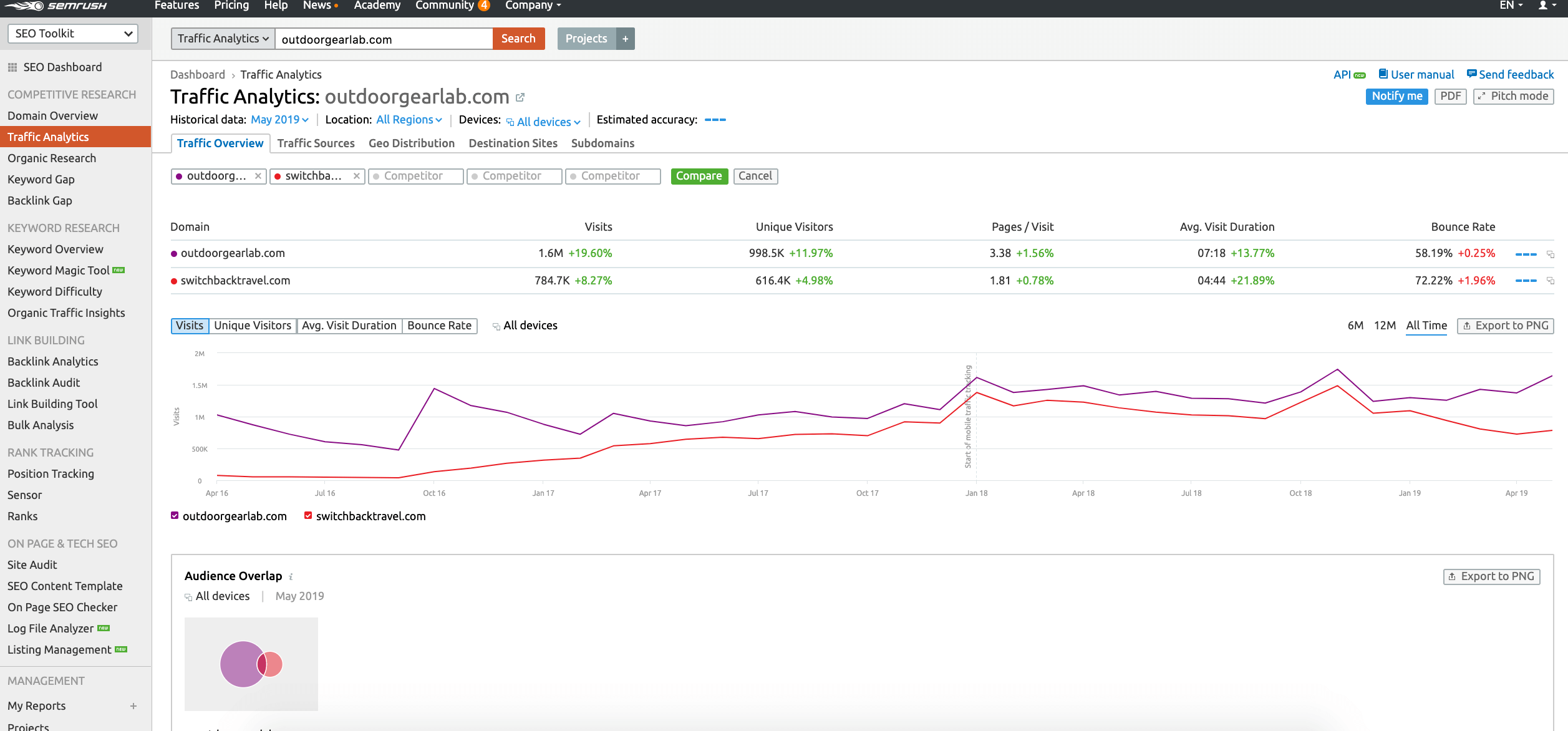
This feature is useful because you’re able to see various competitors against each other and benchmark yourself from there.
This is a killer feature, in my opinion. SEMrush has outdone themselves.
Organic Research
Next, let’s look at SEMrush’s Organic Research tool as it pertains to competitive analysis
Found in the left sidebar, organic research is the place where you can dive deep into a competitor’s organic rankings, the number of ranking keywords, keywords for which they rank, and the various search result features they are currently gaining.
Here’s how the view looks:


From here you can dig deeper into each various area to see the competitor’s history.
For example, I can look at how many keywords Outdoor Gear Lab is ranking for with a featured snippet:

Keyword Gap
Next, let’s look at SEMrush’s Keyword Gap tool which we’ve covered above already a bit.
My primary usage for this tool is to see which keywords my competitor is ranking for that my site is not.
Here’s how that looks:
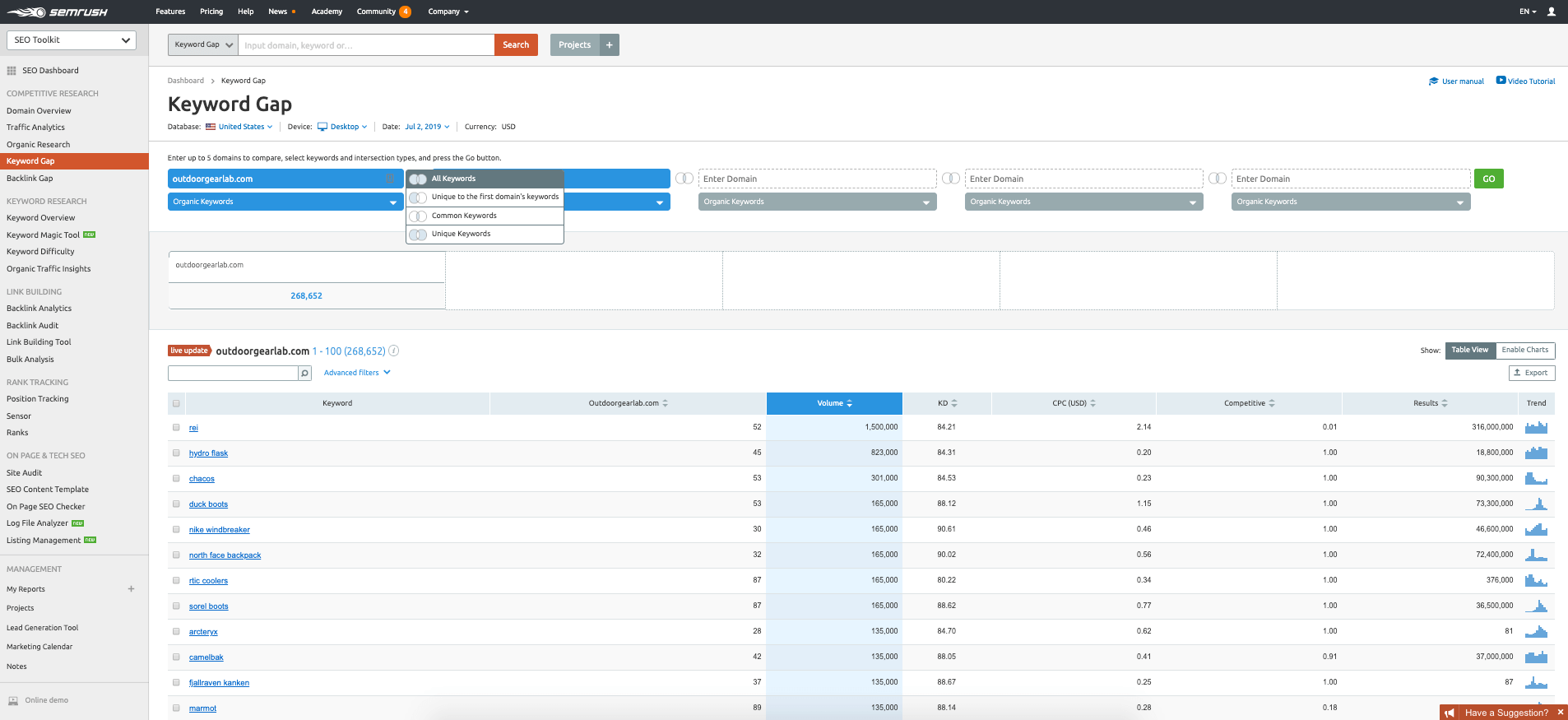
To get the following view, you select “Unique to the first domain’s keywords” to see this:
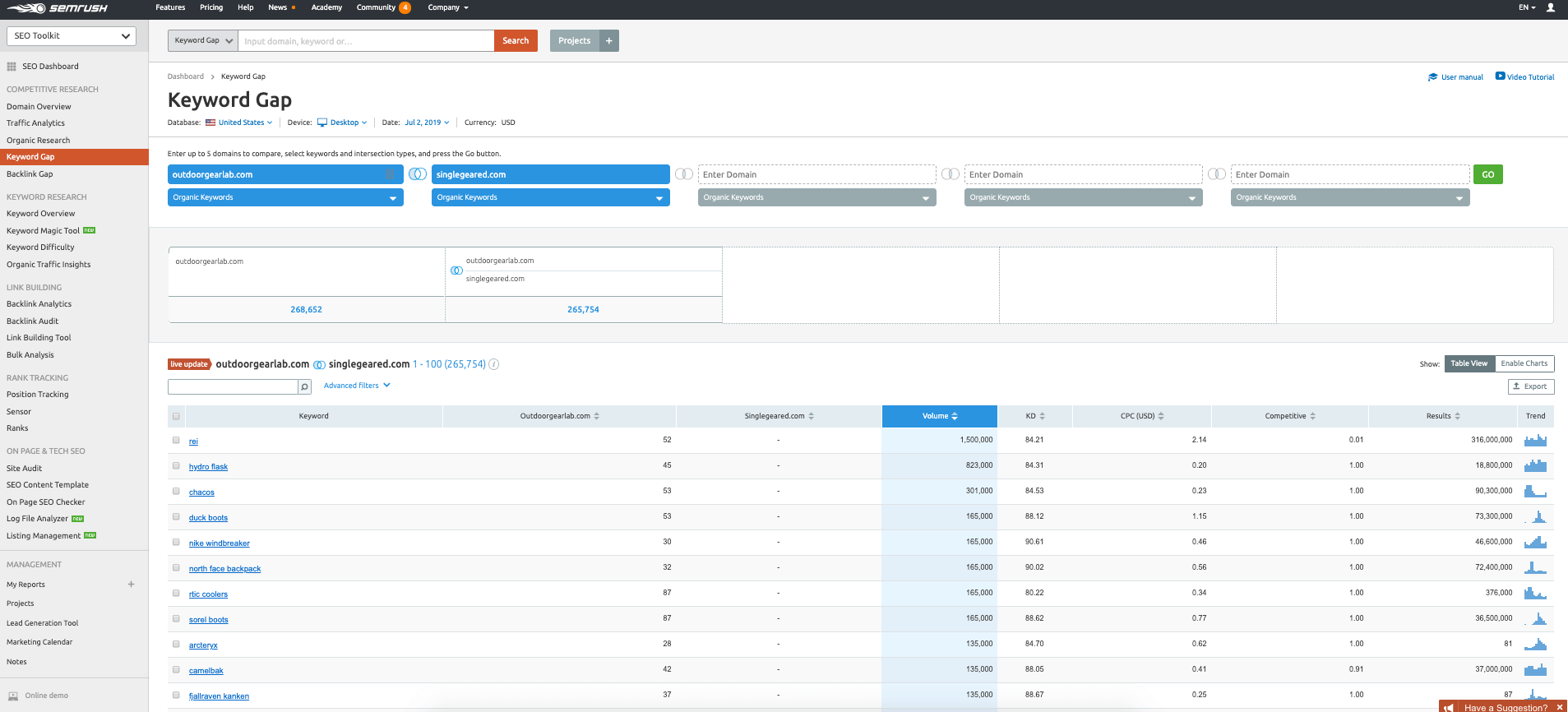
From here, you can slice and dice to your heart’s content, such as this one that says:
- Show me just keywords that OGL is ranking for and I am not
- Where the keyword contains the word “best” and
- OFL ranks on the first or second page.
And, voila:

Backlink Gap
Finally, SEMrush offers a Backlink Gap tool that lets you compare backlink profiles amongst your competitors and your site to identify where they have acquired links and you have not.
You can also use this to potentially reverse engineer their backlink acquisition strategies.
To use this tool, enter competitors as well as your own domain then use the green button to run the report, then select your domain to see links to your competitors that you do not have:
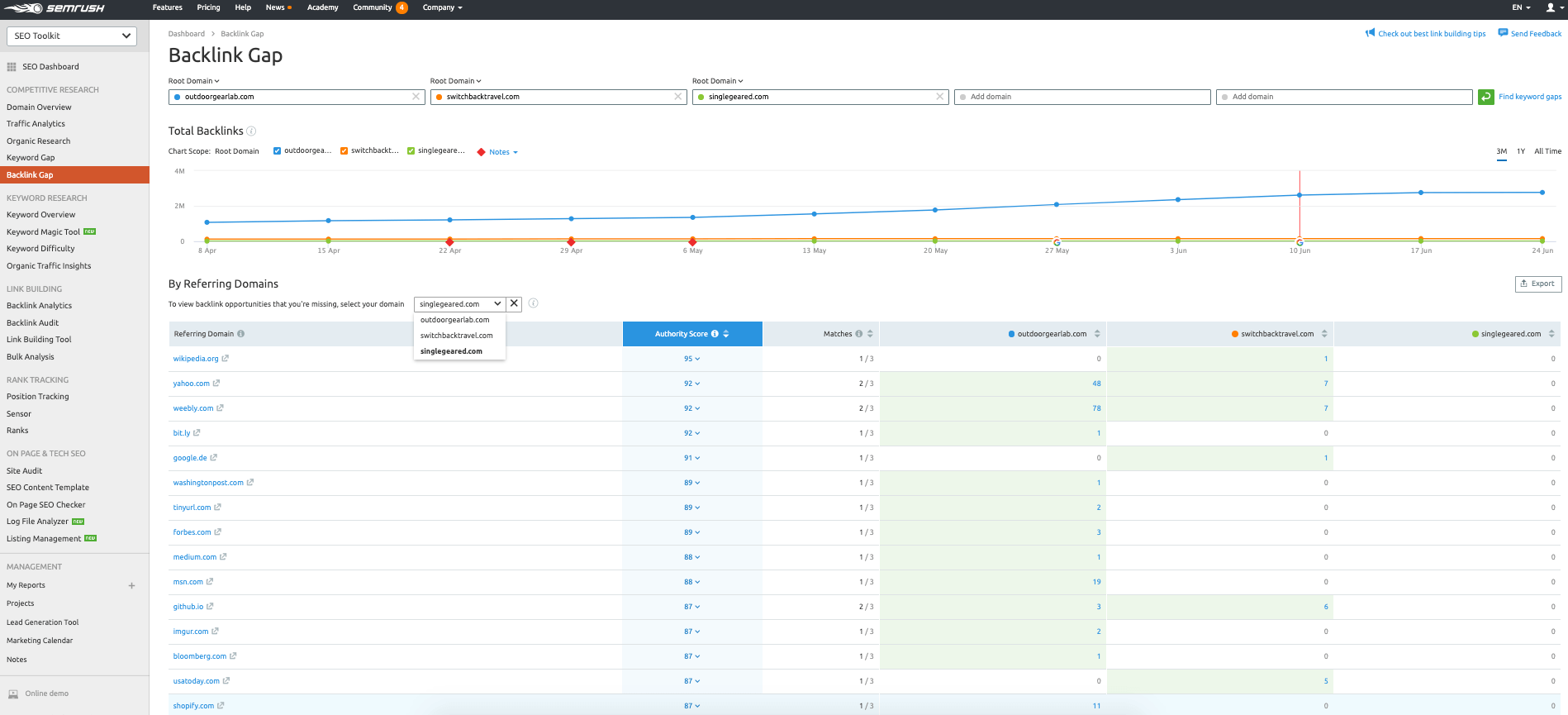
That’s the extent of the filtering abilities within this tool, so from here you’d be wisest to export and filter from there in Excel.
You can also of course click into individual domains to see the links your competitor has from there.
For example, it looks like Outdoor Gear Lab has been leveraging Stack Exchange threads for links:
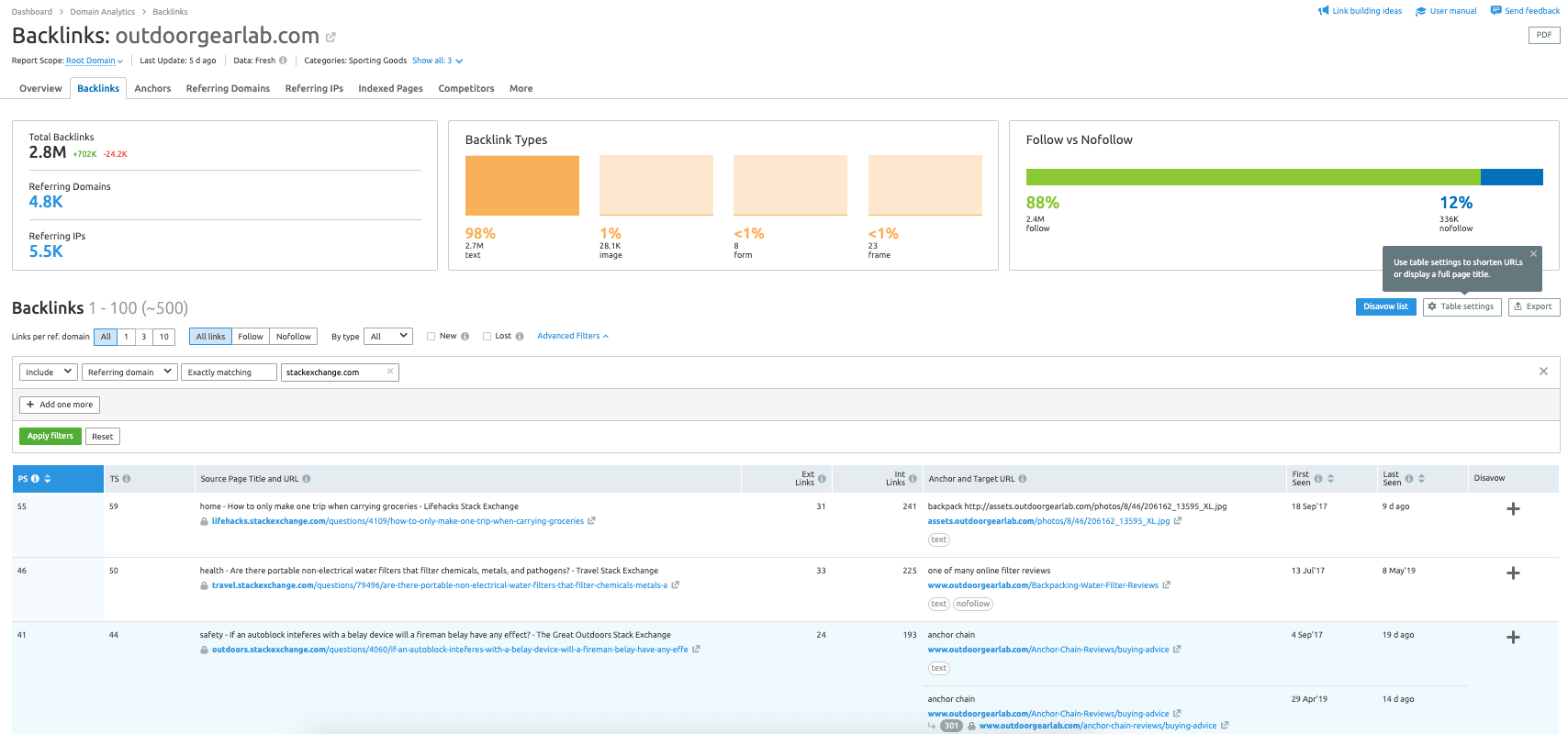
Competitor Research with Ahrefs
Now that we’ve looked at SEMrush for competitor research, let’s look at how Ahrefs can be used for competitor research.
Starting from your main dashboard, there are a few competitor-focused tools in the top navigation such as Domain Comparison and Link Intersect.
The real focus comes once you go into a domain view and then see the competitor tools on the left side.
They are not messaged as “competitive analysis” tools like in SEMrush, but that’s what they are:
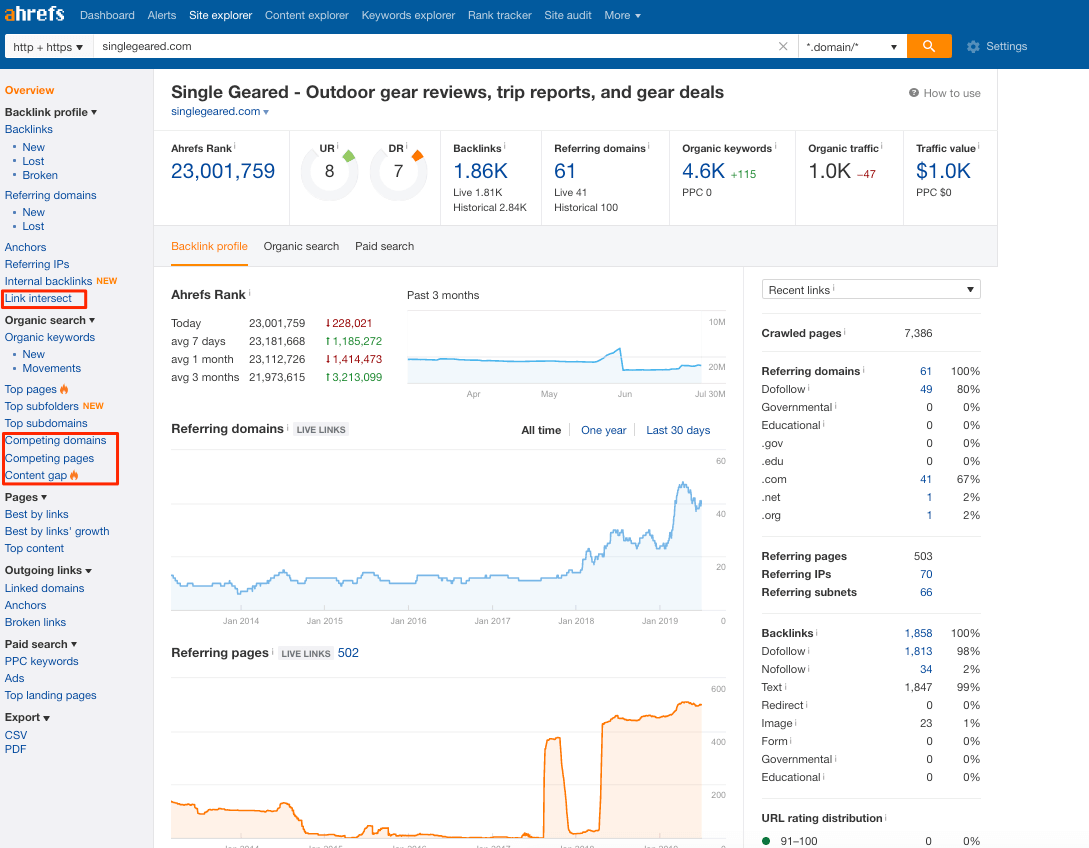
The tools we’ll look at are:
- Domain Comparison
- Link Intersect
- Competing Domains
- Competing Pages
- Content Gap
Let’s get started.
Domain Comparison
Domain Comparison is a tool that allows you to input up to five domains (all competitors or four competitors plus your own site) and see basic metrics on each site that are mostly focused around backlinks.
Here’s a view:
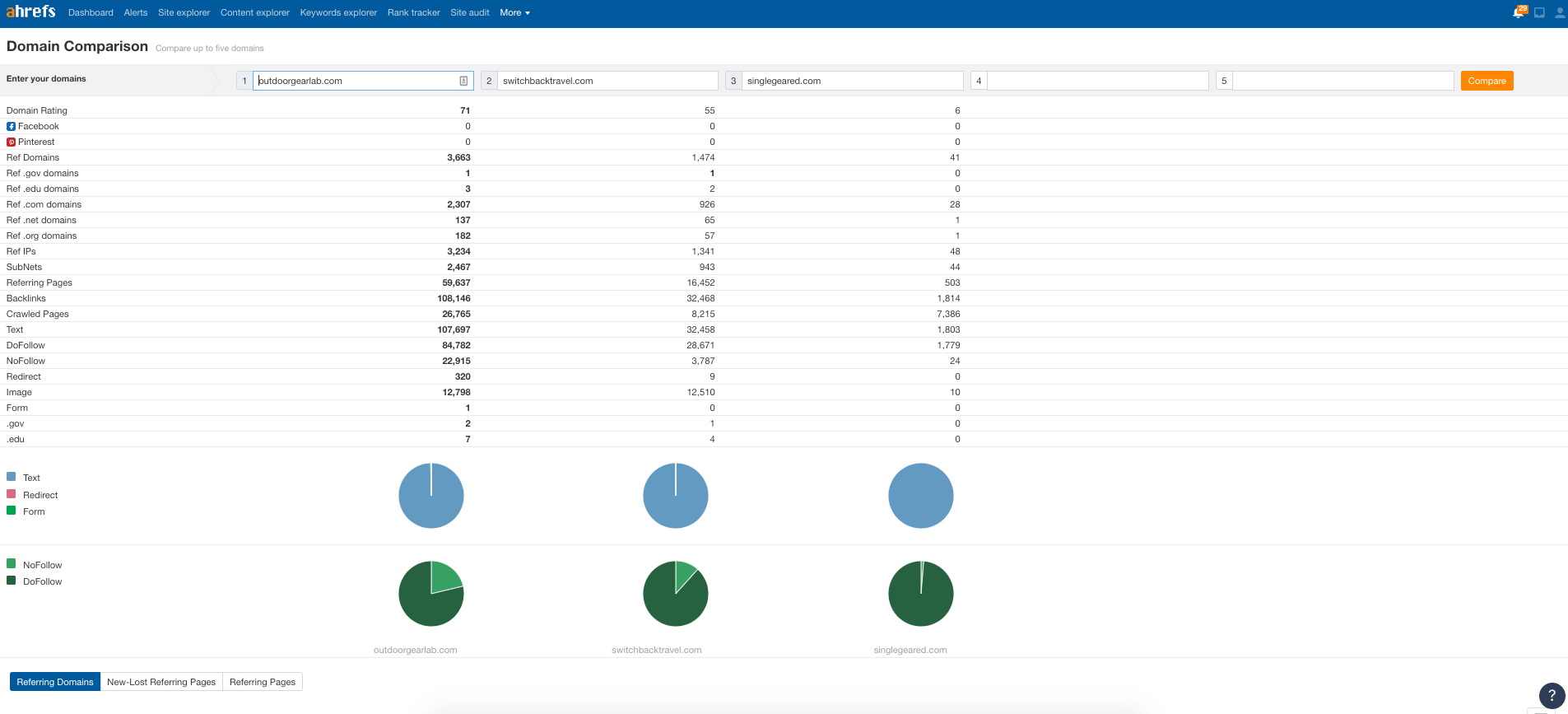
Further down the page shows some rather simple graphs comparing backlinks profiles across Referring Domains/New-Lost Referring Pages/Referring Pages:

Overall this is a snapshot that I can see being useful at the beginning of a link audit or when trying to win an account by showing them how far behind they are, but as a professional SEO it’s not really useful beyond that.
Link Intersect
Next is the Ahrefs Link Intersect tool, which can be found in the Ahrefs top navigation:
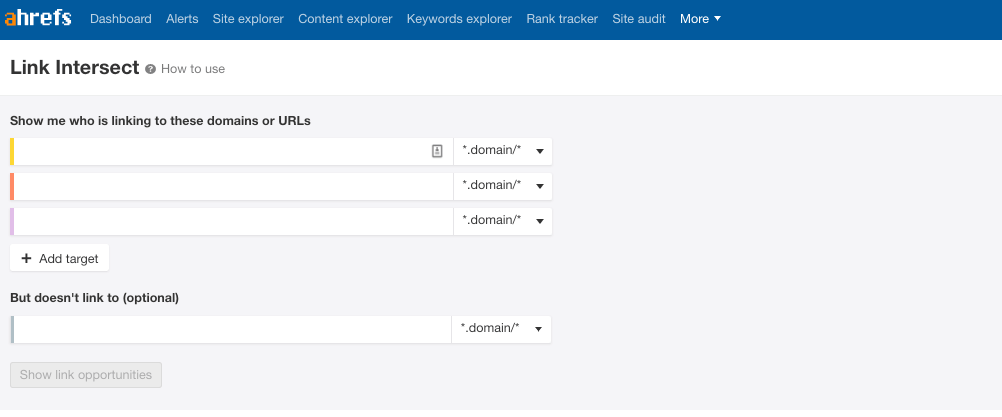
This tool is super useful (and a better user experience than the SEMrush version) as you can input competitor domains and then specify the domain (yours, usually) that you want them to compare the link profiles against so that you can quickly identify link acquisition targets.
Here’s how that looks:
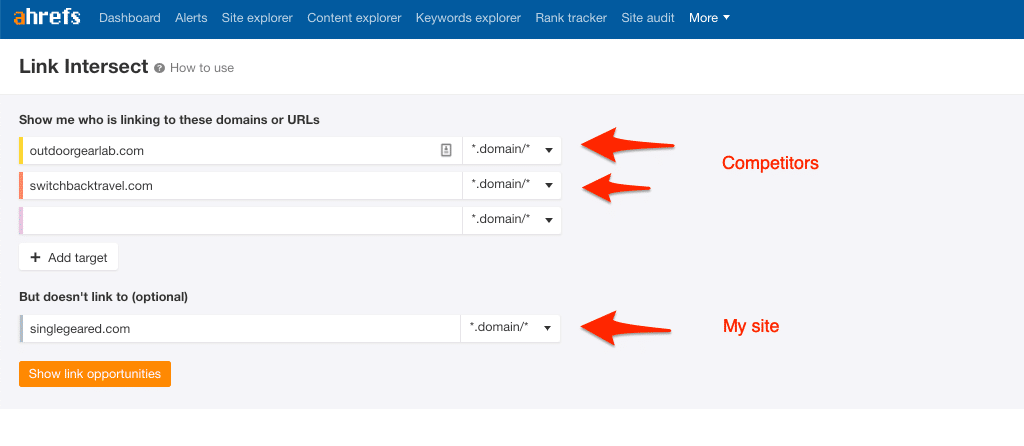
And here’s the view of the results:
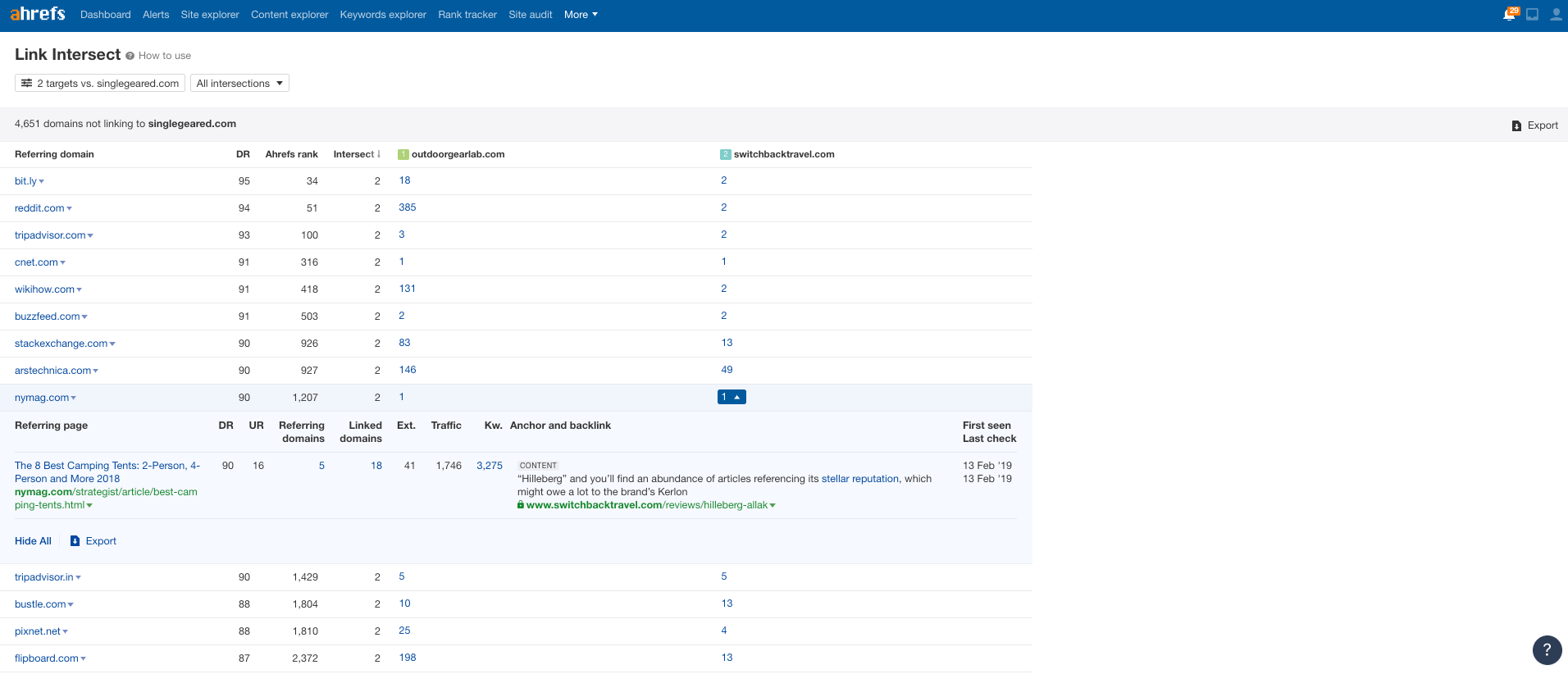
You can then Export in the top right, though that export only gives you the domains and not the individual links.
So while it’s nice to have the domains, you have to use the Ahrefs front end to decipher their link acquisition strategies.
Overall the tool loads quickly and gives you a lot of data, but doesn’t go further.
Competing Domains
Next up is Competing Domains.
This is Ahrefs’s answer to SEMrush’s Competing Domains view on their dashboard.
To access it for your site (or a competitor’s), use the Site Explorer option (in the top nav) to input your site, then find Competing Domains on the left sidebar:

Basically, this report gives you the domains that you compete with most often in the search results, including:
- Keywords you rank for, but the competitor does not;
- Common keywords;
- Keywords unique to this competitor (aka, keywords you do not currently target).
This is a great high-level report that can help you prioritize competitors to investigate deeper.
You can then click on the “Keywords unique to competitor” number which takes you to the Content Gap tool, which we will cover below.
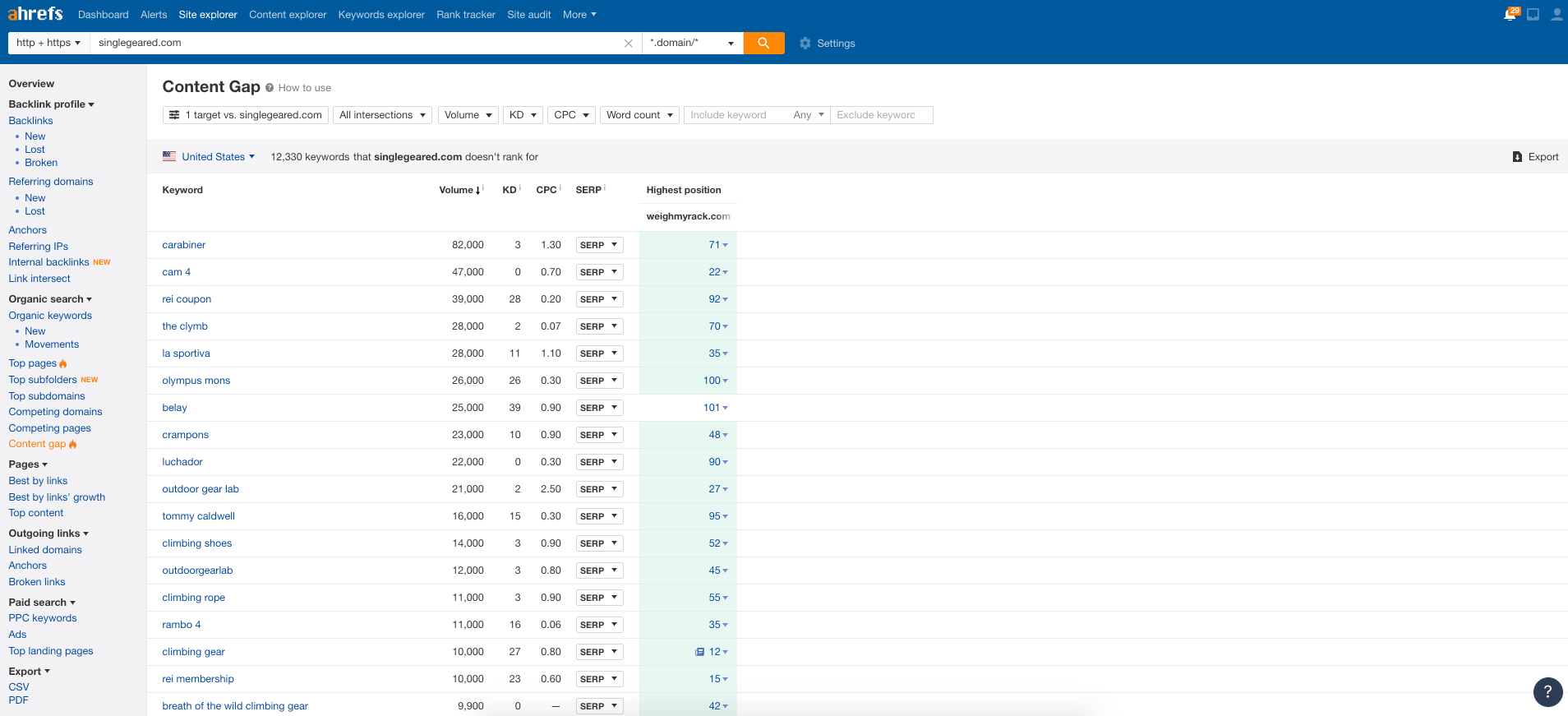
Competing Pages
Next, let’s look at the Ahrefs Competing Pages report which is also found in the left sidebar just underneath “Competing domains”:
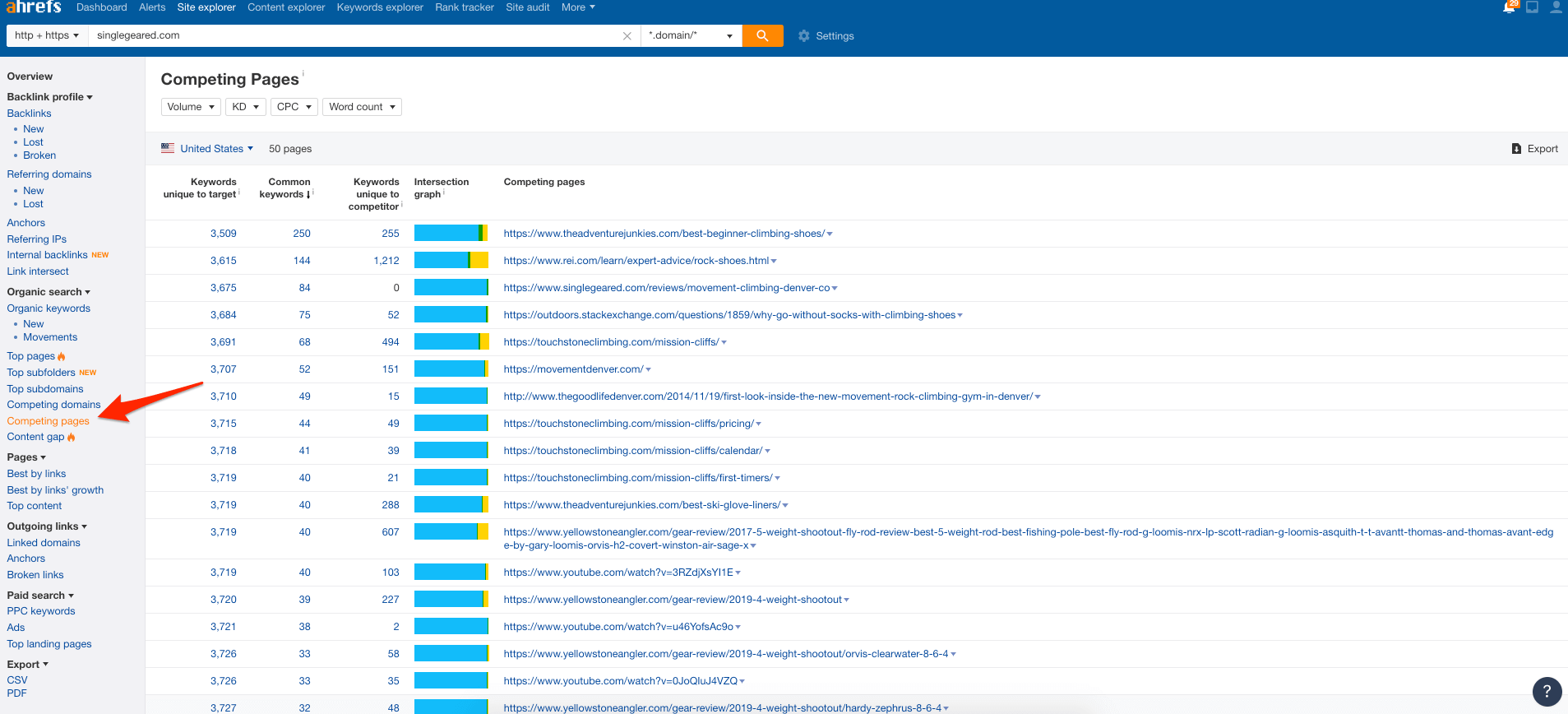
To access this view, once again use the Site Explorer tool to enter your domain then click that link.
You’ll get a view that shows you the pages on competing domains that compete with your content the most often.
The problem with this report is that it doesn’t also tell you the keyword, and I’m not quite sure what I’m supposed to do with this data. I can think of a few use cases, those being:
- Look at these individual pages to see how I can improve my own content to better compete;
- Find new keywords that those pages are ranking for that I am not targeting;
- Try to get links from some of these pages, perhaps.
Overall, it’s an interesting view that others don’t have but I am not sure why it is here or what it is meant for.
Content Gap
The final Ahrefs competitor research tool is their Content Gap tool, which I already mentioned above in the Competing Domains tool section.
This tool is also found in the left sidebar, right under Competing pages:
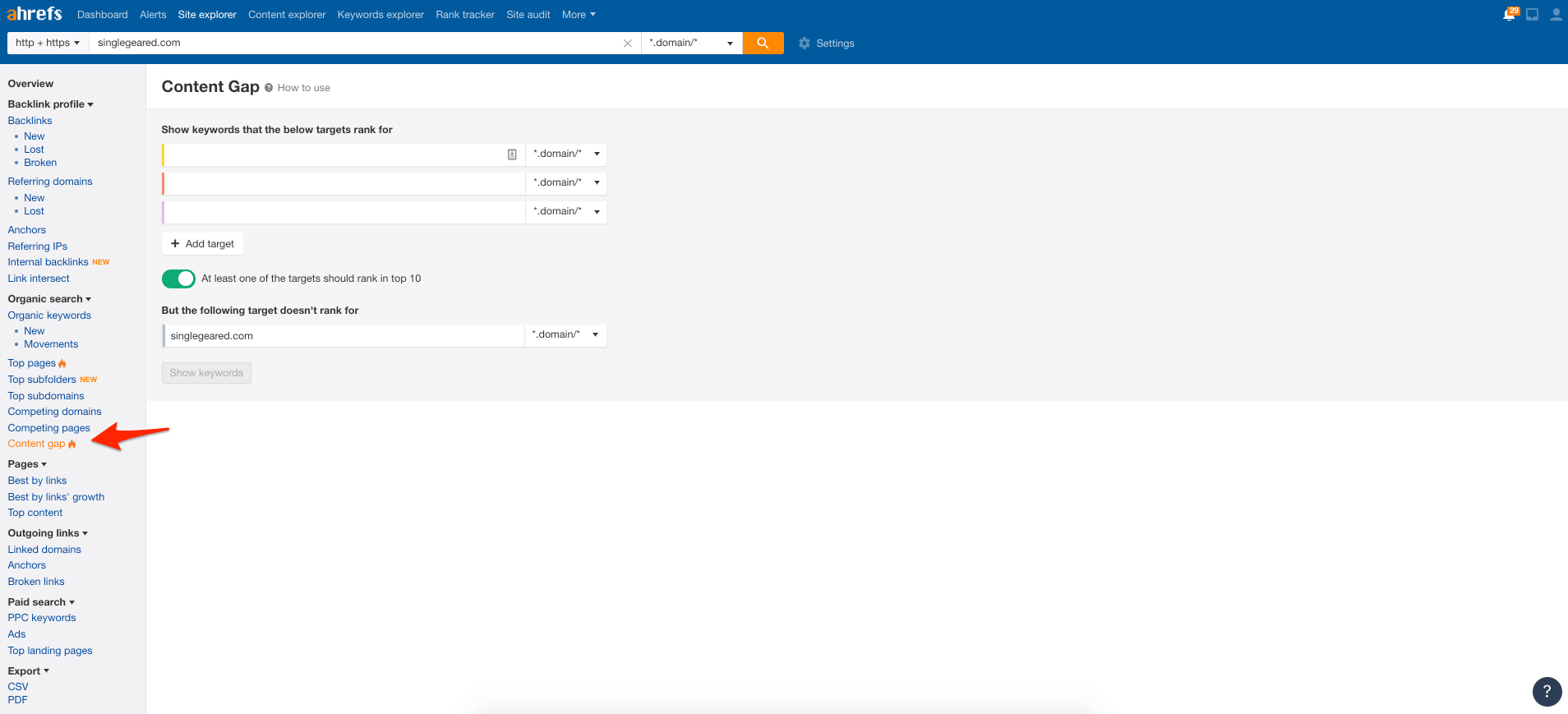
This is actually the most useful competitor keyword research tool in Ahrefs, in my opinion.
By entering a few competitors and your own domain, you receive a list of keywords that they are actively ranking for but that you are not.
Here’s an example:
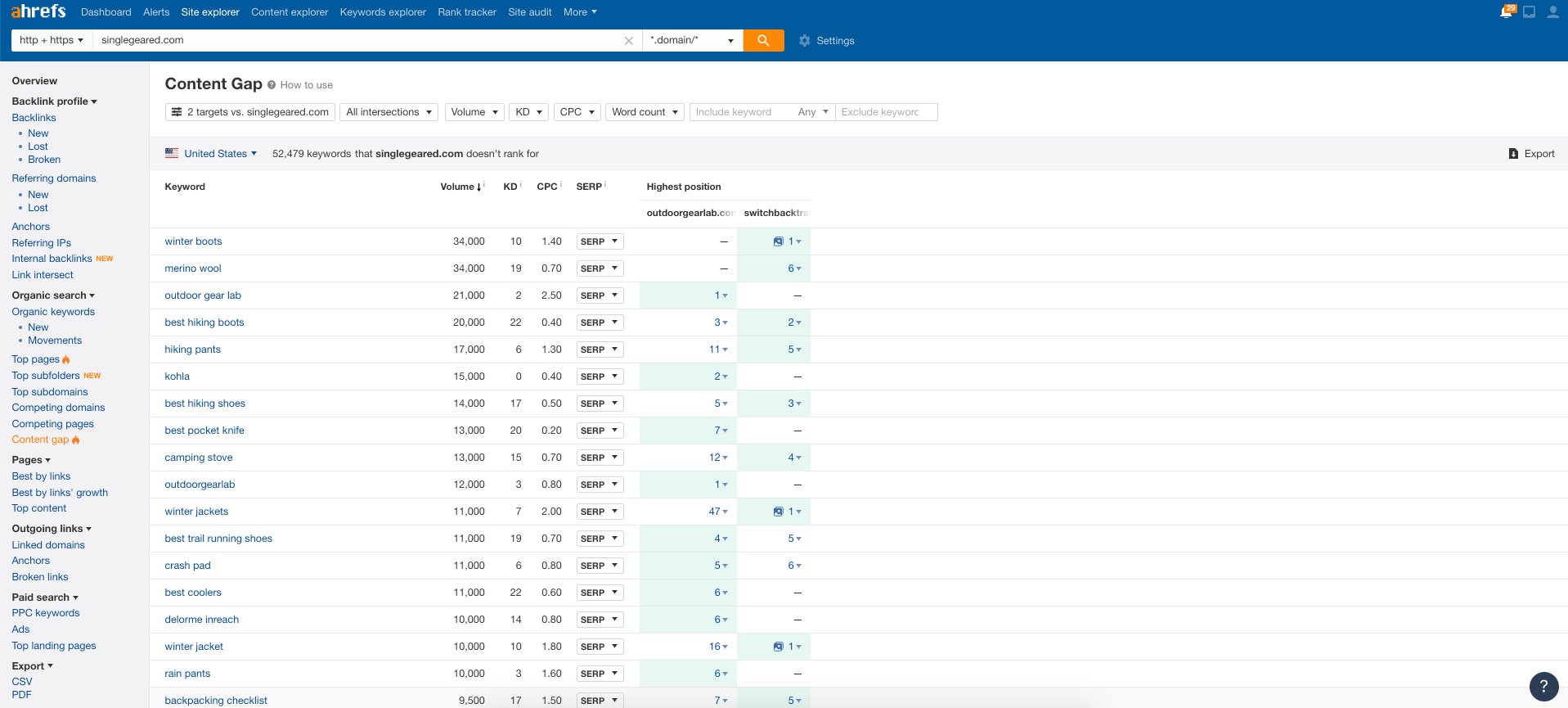
This is an extremely actionable report because I can also slice it by specific intersection types or filter based on keywords.
For example, show me all terms here containing “best”:
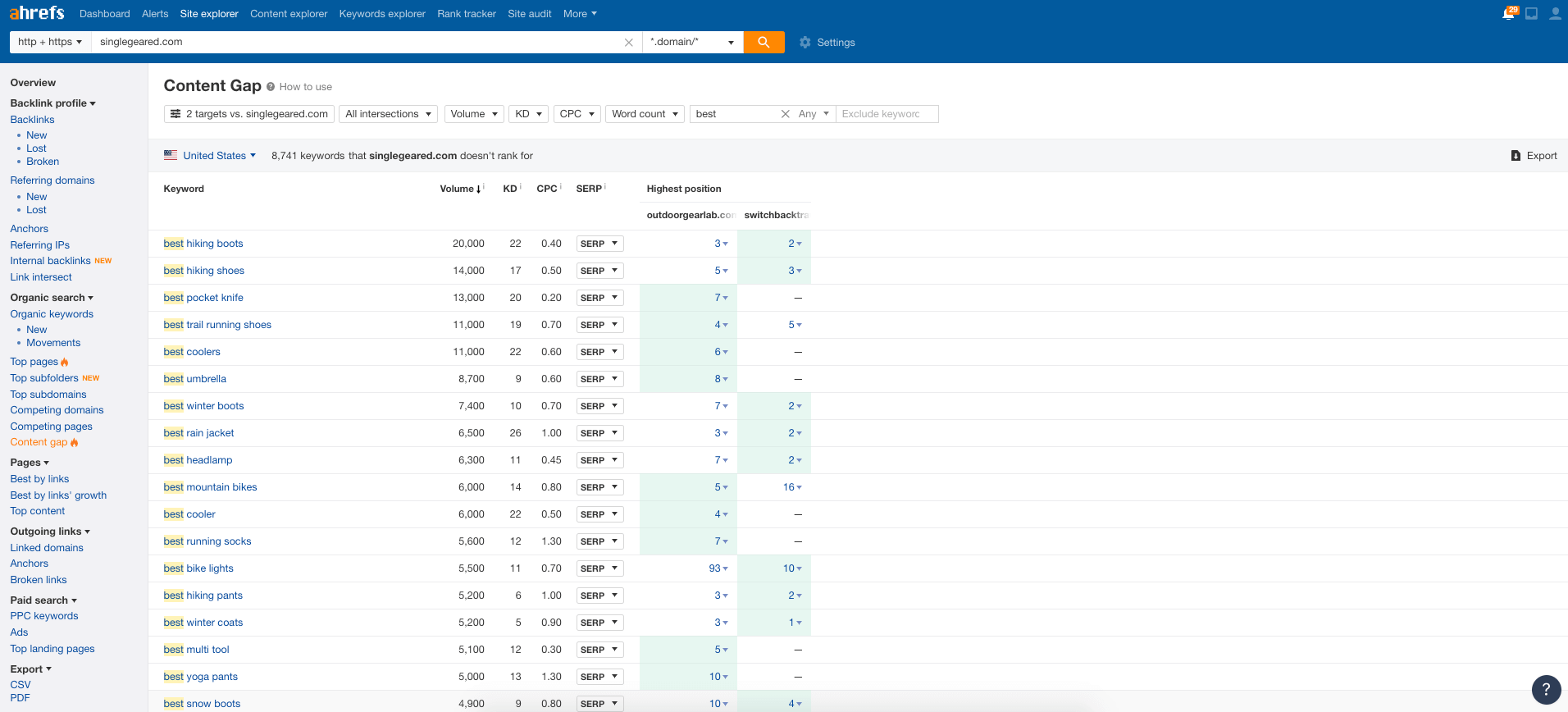
Bingo.
I do wish I could take this further and add specific keywords to keyword tracking, though.
At this point, my best action is to export and then upload it as a keyword list.
Winner: SEMrush
In our opinion, SEMrush is the winner for competitor research because they have put thought and effort into specific tools meant for competitor research that go deep enough to be useful.
While their UI isn’t as crisp as Ahrefs, the ability to get the data and then put it into action with keyword tracking and more takes them to the next level and makes them the right choice for competitor research.
Link Research: Ahrefs vs SEMrush
Finally, the fourth (and arguably most effective) pillar of SEO is link building, and you can’t target the right links as effectively without great data.
So who wins with their link research tools, Ahrefs or SEMrush?
Link Indices Compared
Before we get into the individual tools, let’s talk about the link indices behind SEMrush and Ahrefs.
It’s important to understand that Ahrefs began as a link index (and announced in 2019 that they’re building a search engine), and currently has (as of August 2022) according to this page 219M domains, 412B pages, and 27.5 trillion backlinks in their index.
Ahrefs’ index is massive.
SEMrush on the other hand began as a keyword tool with its keyword database (which as of August 2022 has 22.3B keywords). They also have 6.1B URLs crawled per day, 16.8T backlinks, and 997M referring domains.
So according to these self-reported numbers, SEMrush actually has the bigger backlink database.
Others have done a better job of comparing the link indices against each other, and it is not our job here to do that. Instead, read this from Russ Jones (Moz) comparing Moz and SEMrush link indices, and this Quora thread comparing tools also. Make your own determination from there.
SEMrush link research tools
Let’s jump into SEMrush’s backlink tools and talk about them individually.
Their backlink research tools are:
- A Backlink gap;
- Backlink analytics;
- A Backlink audit;
- Link building tool;
- Bulk analysis.
Let’s look individually.
Backlink Gap
First up is the Backlink Gap tool, which is found in the left sidebar under “Competitive Research”.
I guess technically this is a competitive research tool, but it is one of my favorite tools in SEMrush for identifying domains where my competitors have links but my site does not.
Note: when it comes to backlink strategies it is not advisable to only copy your competitor’s backlinks and targets.
However, in many industries where the SERPs are competitive, it can be very useful to build a list of initial backlink targets based on your competitors.
Here’s a screenshot of SEMrush’s Backlink Gap tool where I have inputted my domain as well as two competitors:
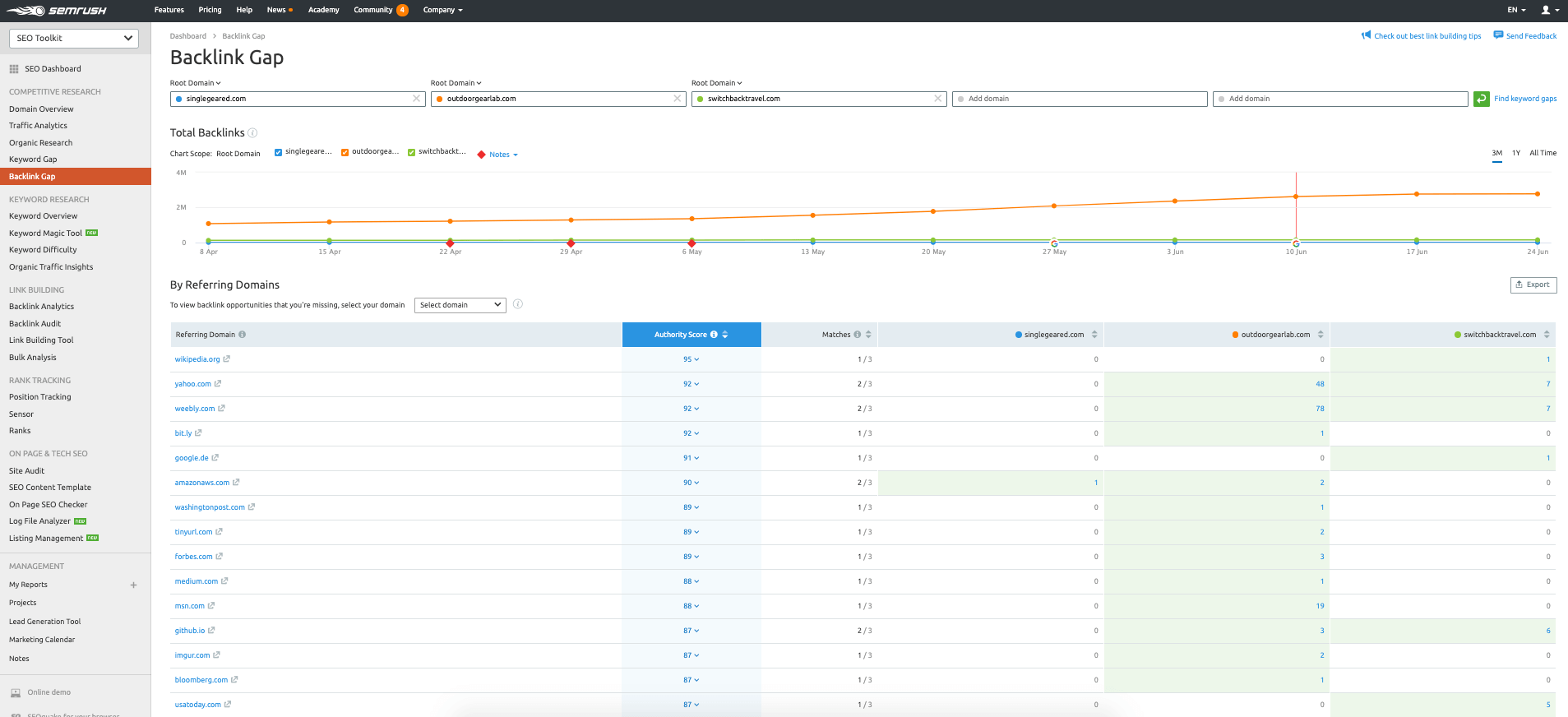
Then, I can also filter down to the linking domains that link to my competitors but not my site:
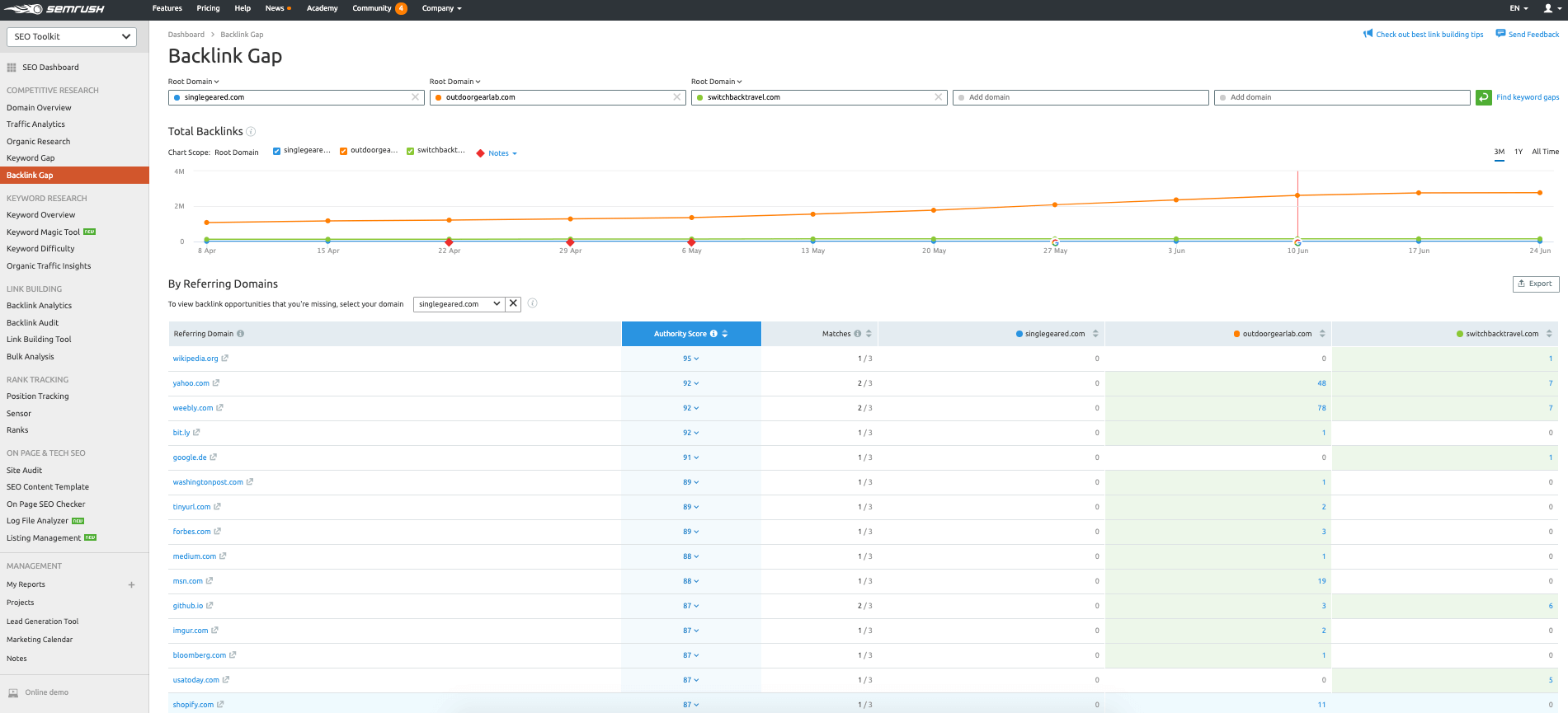
From here, you can click into the individual domains per site and analyze them to identify how your competitors are building links. You can also export this view to Excel to do your own analysis there.
Backlink Analytics
SEMrush’s first dedicated backlinks tool is their “Backlinks Analytics” tool, which looks thus:
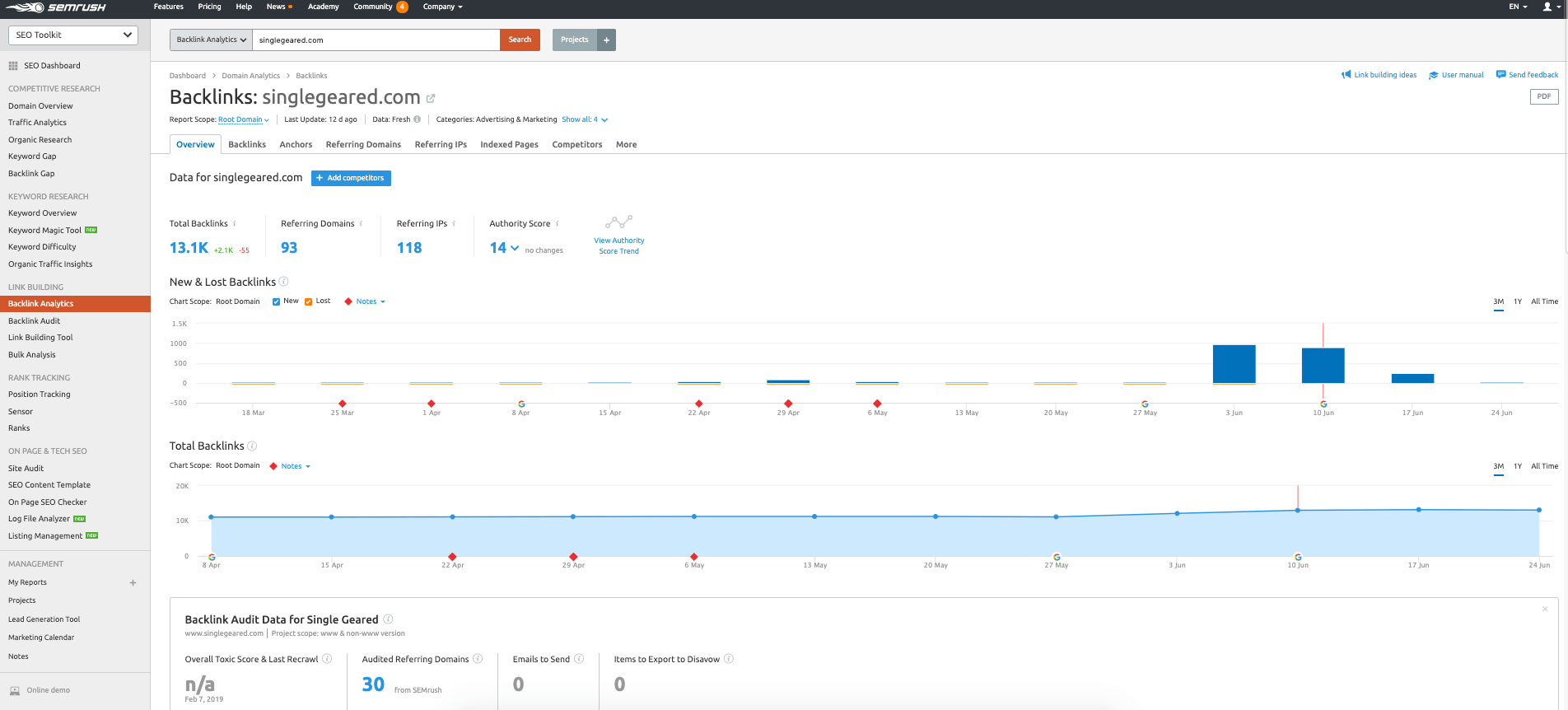
There are quite a few things to notice in this tool, as it packs a punch of features.
First, you can get a high-level look at link velocity to the domain in question over the last 3 months, a year, and all time.
This is a very high-level view but can help you understand if a site recently started building links purposefully.
Scrolling down, you get an understanding of link types, follow/nofollow, countries of origin (useful for seeing if a backlink profile might be spammy with TLDs from other countries), top anchors and terms, and more.
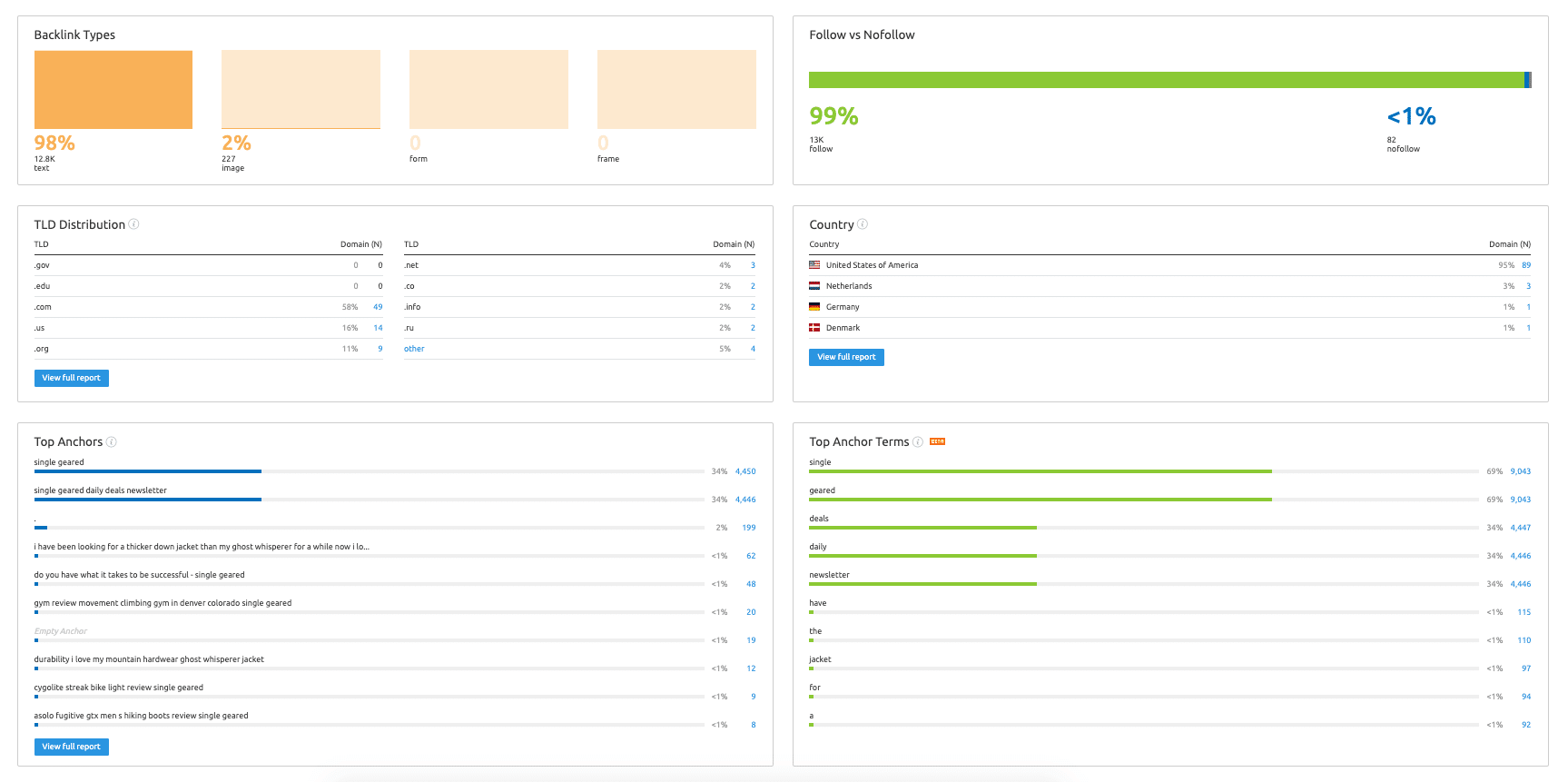
If you want to go deeper into the site’s backlinks, there are multiple tabs across the top:
- Backlinks (a list of all the individual backlinks to this domain);
- Anchors (all the anchor text of the links to the site);
- Referring domains (just the domain view of the Backlinks tab);
- Referring IPs (useful for identifying blog and link networks);
- Indexed pages (pages on your domain sorted by number of links);
- Competitors.
Basically, pretty much all the data you could want around backlinks to a domain is available in the Backlink Analytics tool.
There are some breakdowns (such as Page Score or Trust Score distributions) that are not available that would be useful at a high level, but I’d rather have the deep data than those higher level views if I have to choose.
Backlink Audit
Next up is the SEMrush “Backlink audit” tool.
This is found in the left sidebar under the “Backlink analytics” link:
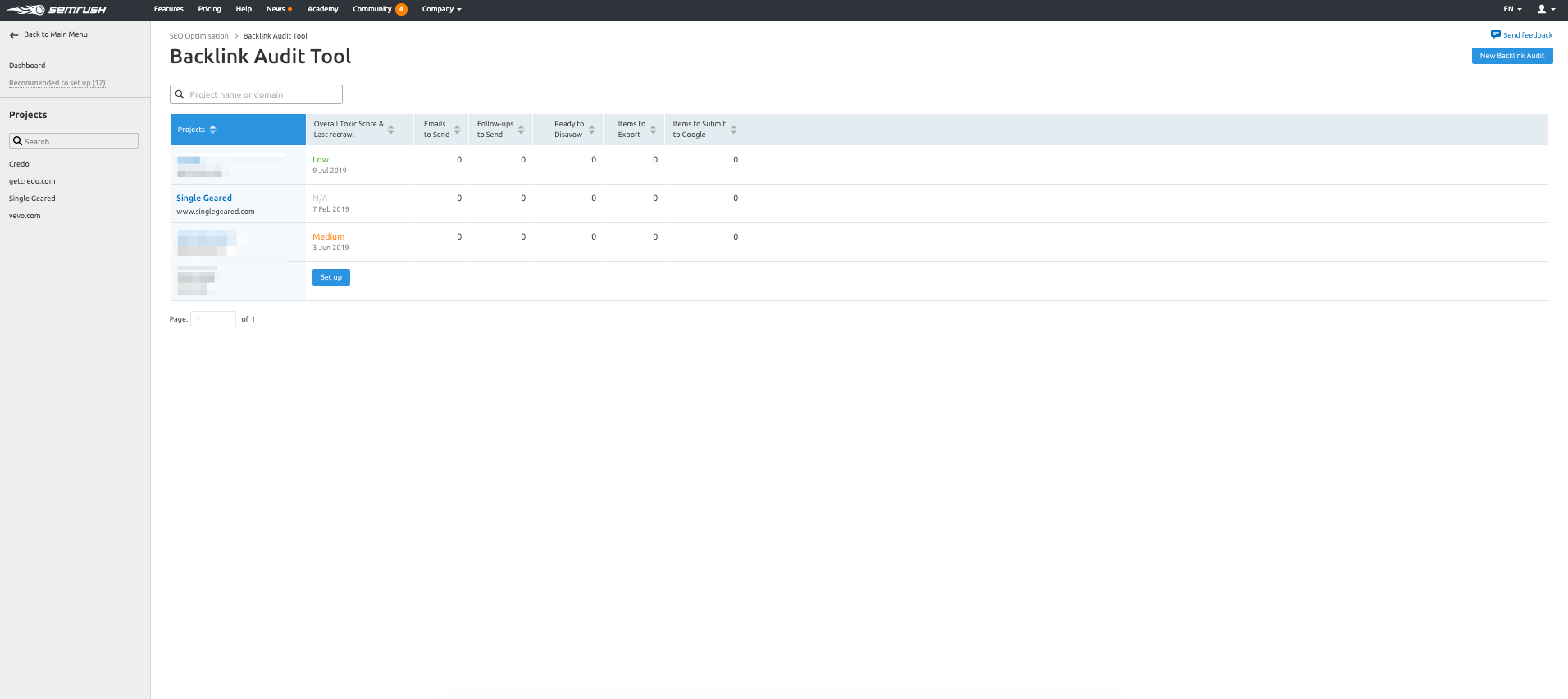
Here is the dashboard of a backlink audit that SEMrush runs weekly for Credo:

As you can see, there is a lot of data presented here. You can see:
- Your backlink toxicity (according to SEMrush)*;
- Referring domains and analyzed links;
- Anchor types;
- Top Anchors;
- Follow/nofollow.
Backlink toxicity can help especially with new clients or if you inherit a site that did a lot of bad link building in the past that may be affecting your rankings negatively now.
You can also add your own widgets to this dashboard.
Clicking into the “Audit” tab on this section, SEMrush helps you look through all of your links and determine if you think they need to be disavowed or if they should be reached out to in order to get the link removed.
They sort by link toxicity, which is helpful to prioritize your efforts:

For each link, you can do any of the following:
- Keep (and whitelist the domain);
- Delete (and move to either Remove or Disavow).
Once you’ve gone through and marked all the links, you can then even generate a Disavow file from the app to then upload to Google Search Console:

Another useful tool here is the “Lost and Found” tool, which is meant to help you identify on semi-regular basis sites where you have lost links so that you can reach out to the site and try to reclaim that link if it makes sense:
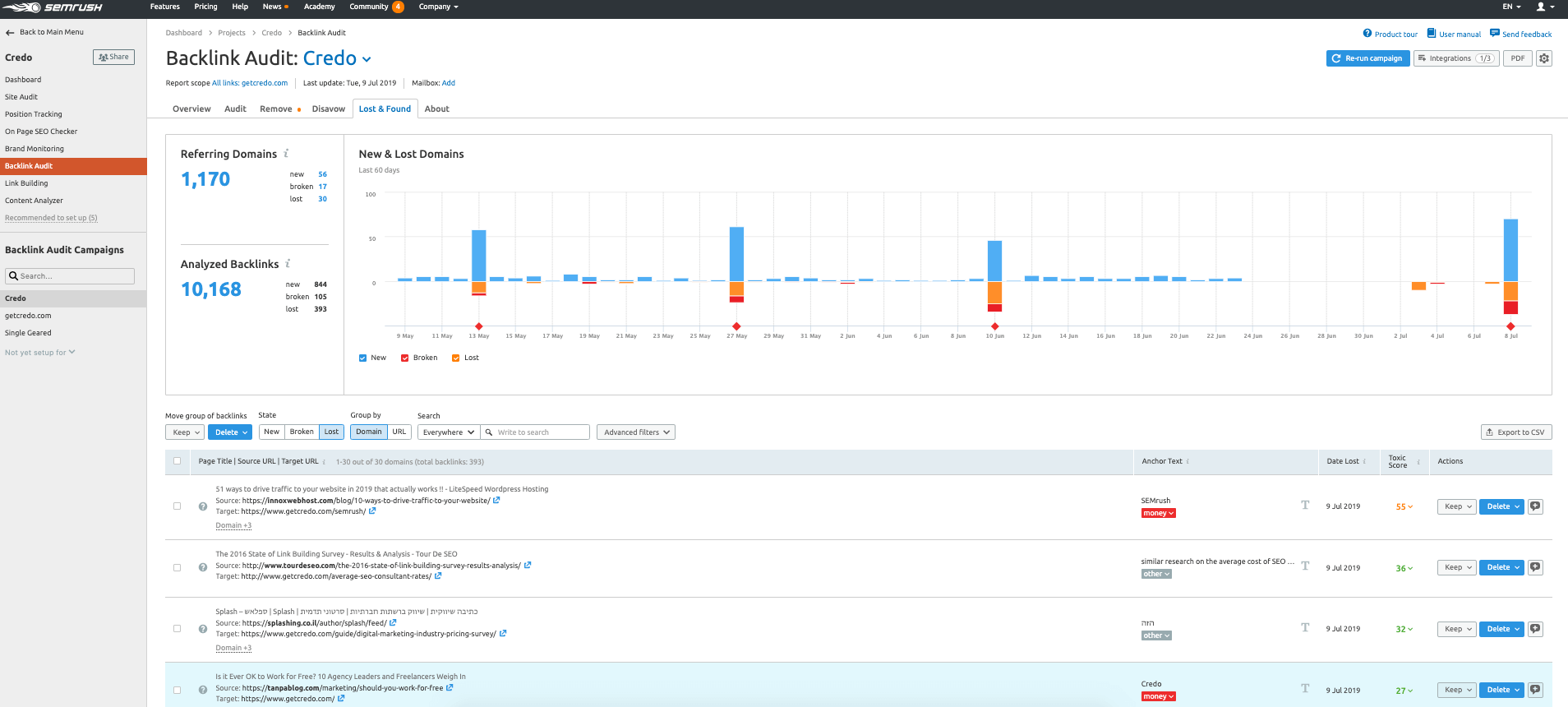
While this is a great tool in theory, right now it lacks something important: prioritization.
It gives you a list of New/Lost/Broken domains but they do not then give you any statistics on those domains or pages by which to prioritize your efforts.
Link Building Tool
Next up is the Link Building Tool, which is exactly what I hoped it would be – a CRM for sending link request emails based on SEMrush link data.
Now, I don’t really do active link building these days.
Most agencies I know who do link building use a tool like BuzzStream or Pitchbox to do their outreach and track it, but I could see this being useful for someone who just has one tool subscription who wants to be able to track their link outreach efforts in that same place.
Here’s how the tool looks (it’s part of their larger Projects architecture, in this case for Single Geared):

To be honest, the UX on this tool is a bit strange and it feels like a bolt-on tool that they launched to say that they have it.
But when put up against a Buzzstream or similar tool (or even a good CRM like ActiveCampaign), it’s hard to use and clunky.
Within the SEMrush Link Building Tool, you can connect your email address and Google Search Console so that SEMrush can pull in your GSC link data and only present you “Prospects” that you do not already have links from.
This is how SEMrush explains how the tool works (pretty simple on the face):
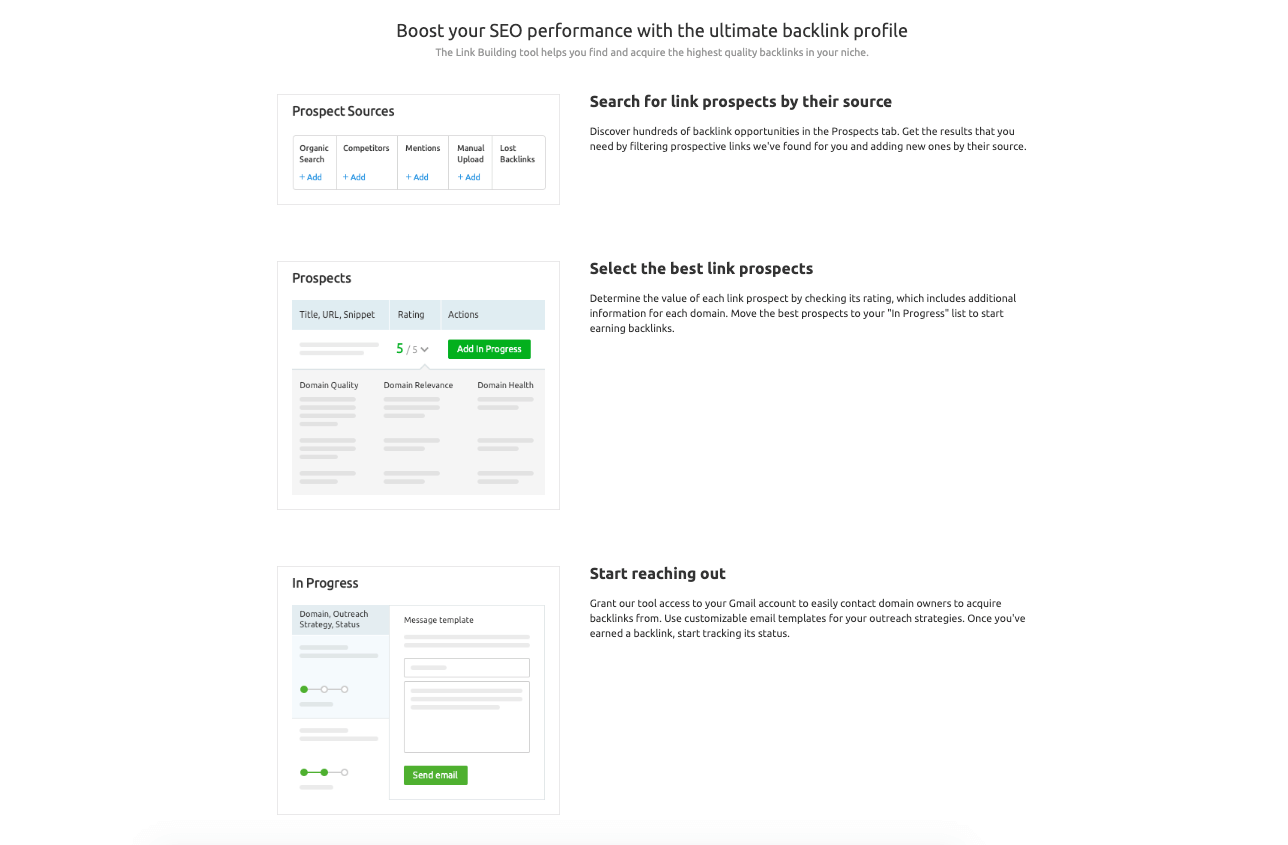
When setting up a new Project, you’re asked first to give the domain and name of the project.
Then you’re asked for a list of keywords:

Then a list of competitors:
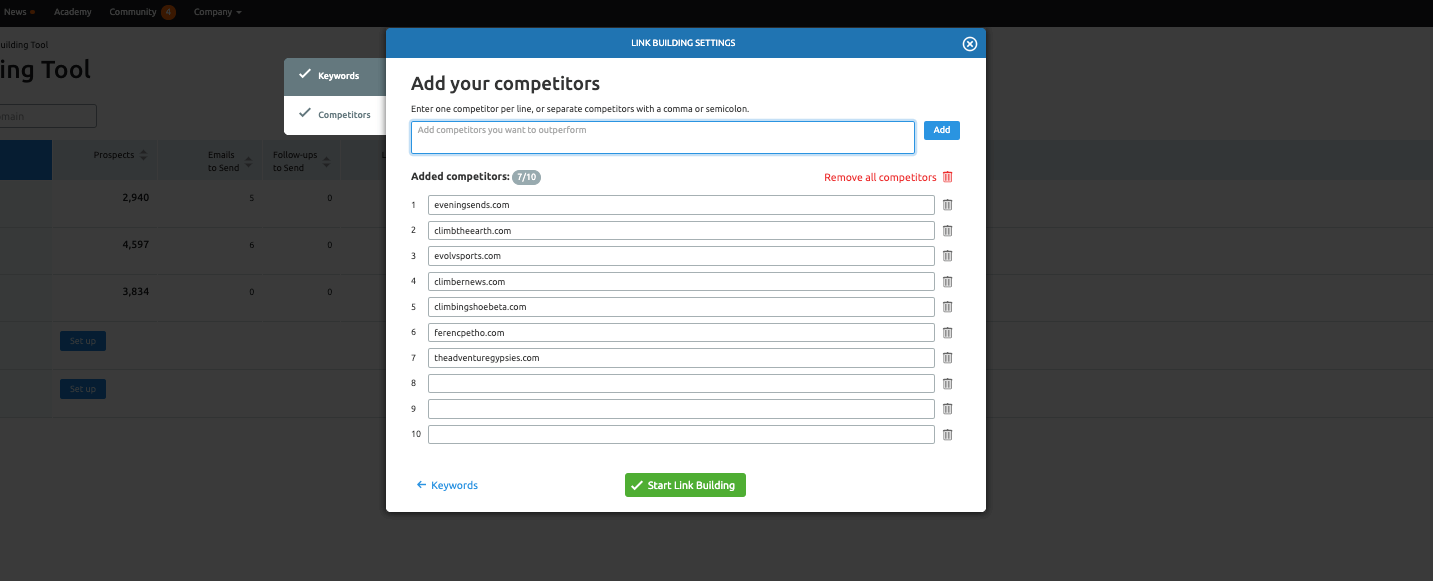
Once SEMrush processes the data, you’ll be presented with a list of prospects.
Before we get into that, I want to note that I think SEMrush should add at least one and possibly two more steps into this setup/onboarding.
The data/prospects presented would be much more valuable if they asked people to connect their Search Console in this setup as opposed to later.
It could be an optional step, but if even 25% of people do it then SEMrush would have a more valuable tool and get more data.
The second step they could add is email integration/setup, though it would take testing to determine if people would do it here or want to do it later. This would also be an optional step.
Alright, here’s an example prospect list where you can also see the functionality of adding specific prospects (basically, pages) to specific types of link-building projects:

Once you add a few, you’ll see them populated on your Prospects tab with the type of outreach strategy you defined.
There’s then an option to send an email:

Once you connect your email you’ll see the ability to add templates for outreach in a view like this:

SEMrush also pulls in emails from that domain so you can select who to send it to.
Assuming you acquire some of these links, you can then add them using the green check mark on the right side of the screen so that the domain appears in your Monitor tab:

Overall, I think this is a useful tool for someone who wants better tracking than what they’ll get through Gmail or other email providers, but also doesn’t need/want to use a dedicated tool like Buzzstream.
This tool is smart of SEMrush to have so that link builders/business owners can leverage SEMrush’s data to quickly build prospect lists and do outreach.
Bulk Analysis
SEMrush’s final link-building tool is their Bulk Analysis tool, where you can analyze backlink metrics for up to 200 domains at a time.
Here’s the initial screen:
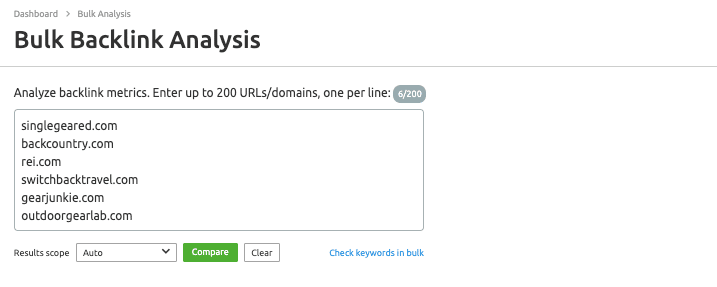
Once you run the report, you will see a view like this:

You can click into each domain to dive deeper if you want.
However, there is a lot of value in this report/view that shows clients/potential clients/bosses what your competitors are doing for link building and where you stand in comparison.
Especially in regards to raw link metrics (which we know are directional but not necessarily indicative of rankings, as SEO involves so many things other than links).
Ahrefs Link Research Tools
Now let’s get into Ahrefs’s link research tools.
As mentioned already, Ahrefs began as a link index and has broadened out into other SEO tools including their site auditor.
They announced in early 2019 that they’re building a search engine too, and they pride themselves on “big data”.
As of August 2022, they have 3.5 trillion external backlinks in their index. That’s massive:
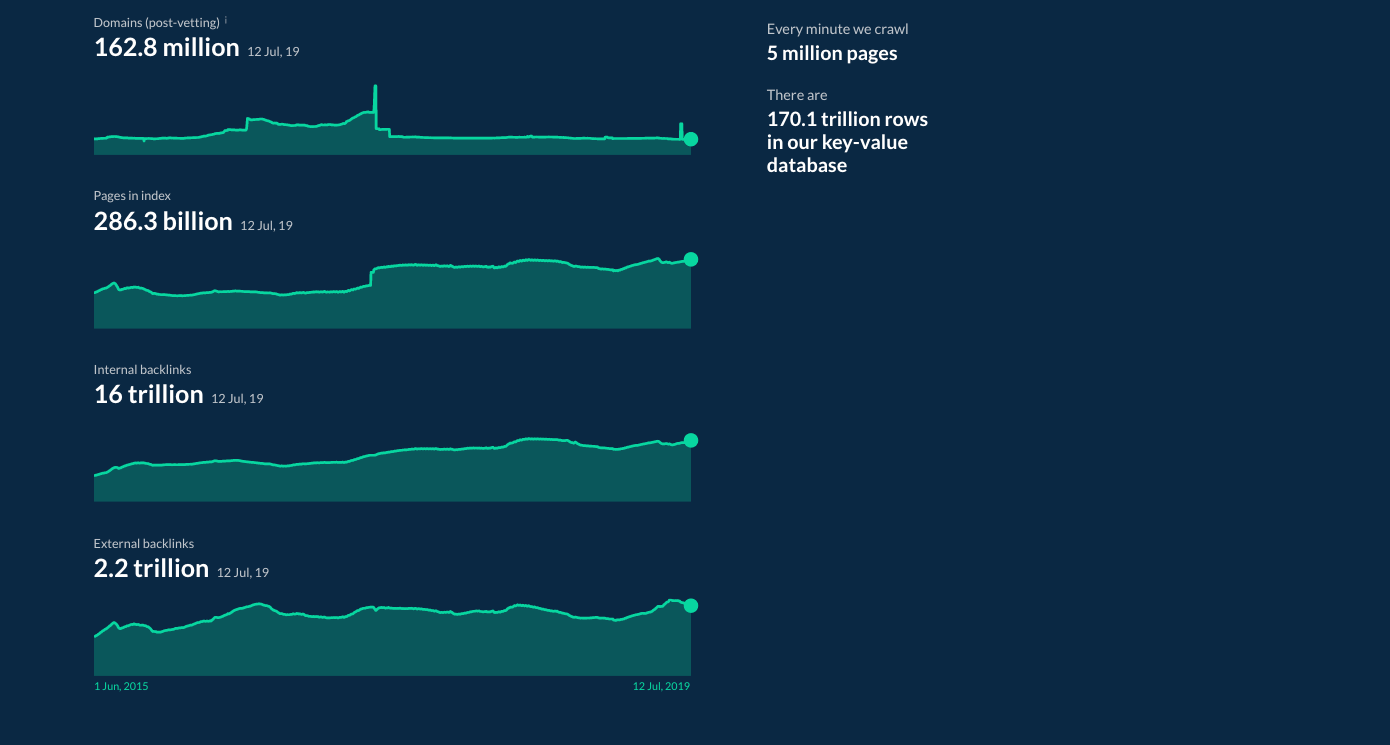
So, does a huge index mean that their tools are good? Let’s dive in.
Ahrefs’s link research tools are:
- Backlinks
- New
- Lost
- Broken
- Referring Domains
- New
- Lost
- Anchors
- Referring IPs
- Internal backlinks
- Link Intersect
To start off, all of the backlink tools in Ahrefs are found in the left sidebar once you are in a specific site’s view:
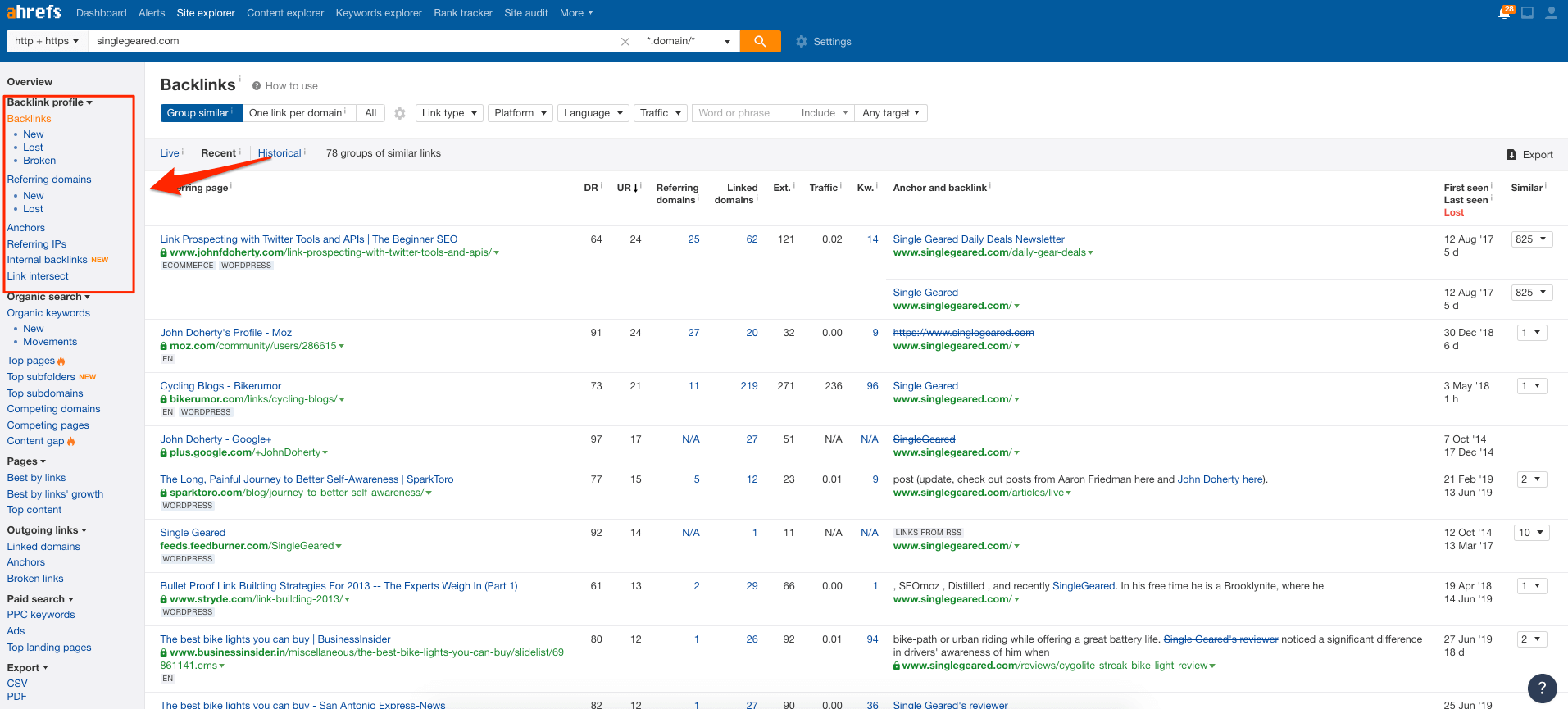
Backlinks
Starting off, the Backlinks report is Ahrefs’s main report for your (or your competitor’s) backlinks.
This report looks this:
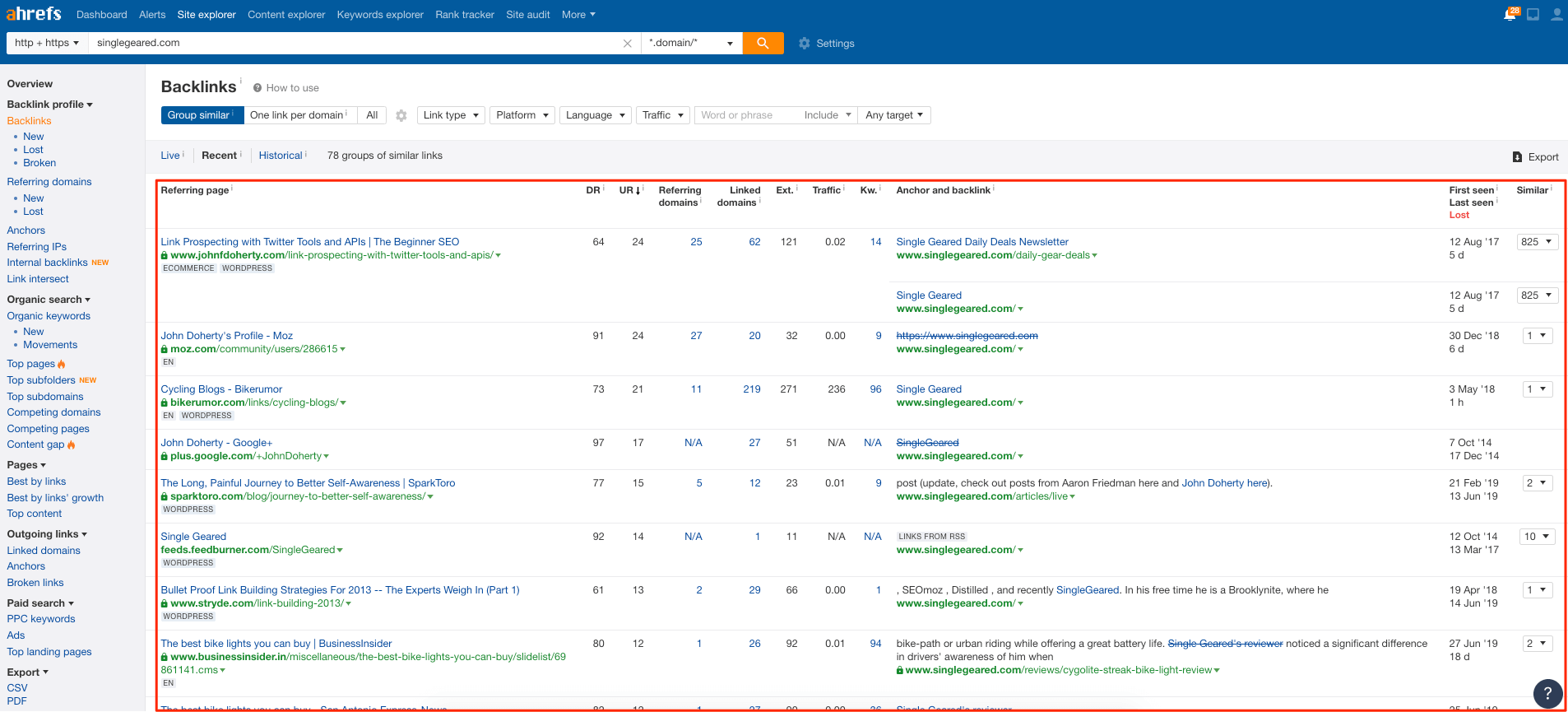
This report shows you:
- A list by the page of individual links to your site as well as which page on your site;
- The metrics on that page;
- When it was first seen, when it was last checked, and when dropped (if it was);
You can also view just Live, Recent (which is a combination of live and recently lost backlinks), and Historical (all live and lost backlinks).
The historical view gives you the most data in a cut.
There are also multiple filters up top to help you find areas of concern, such as:
- Links that redirect to somewhere else and could be redirected to be more powerful;
- From EDU/government/etc sites;
- Links containing certain words.
You can also view one link per domain, to narrow down from what could be a firehose of data.
The next step in this report is to export and manipulate the data elsewhere after you’ve filtered (or just export it all and manipulate it yourself).
There are also three other views underneath this report, which are:
- New links are shown as a calendar view so you can see which links were acquired on which days, or in a timeframe:
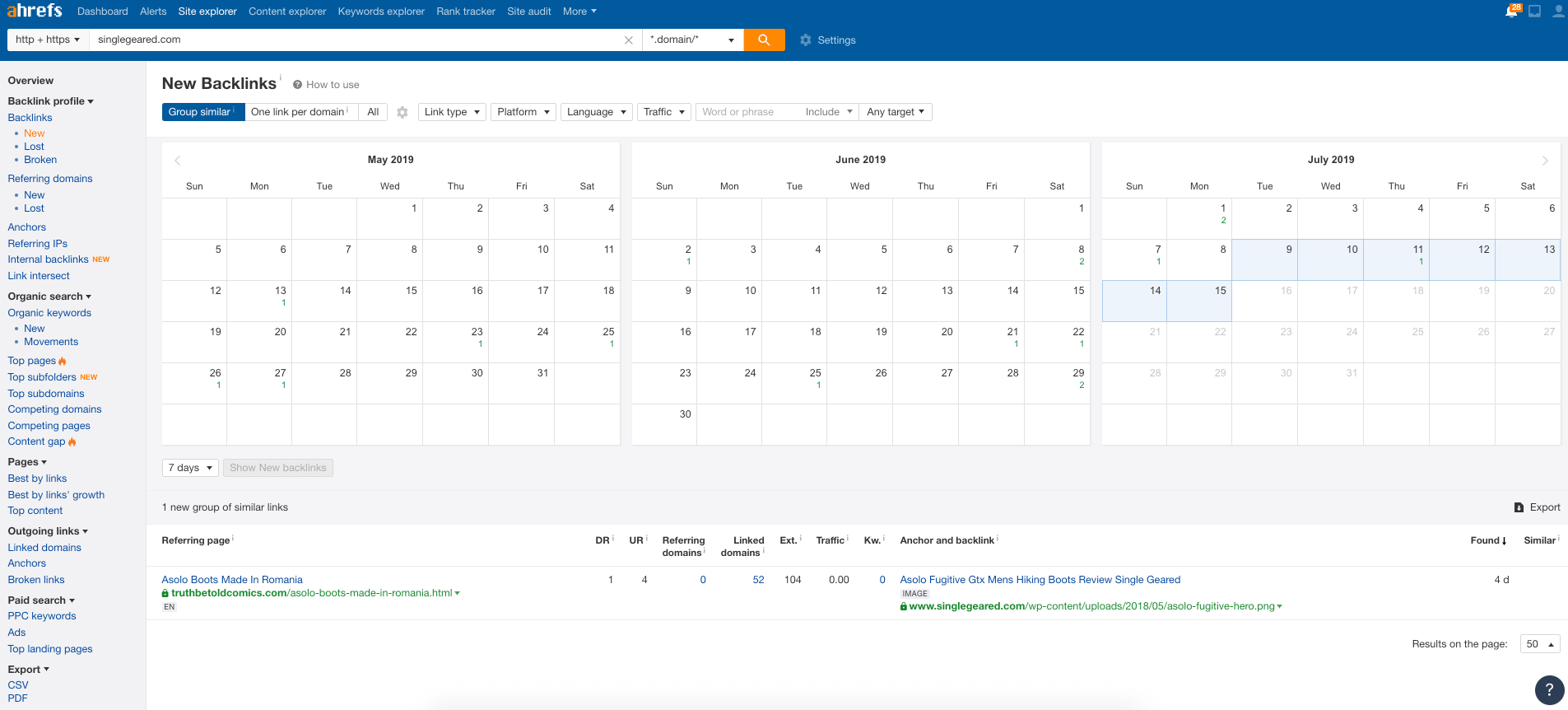
- Lost links as a calendar view to help you prioritize link reclamation. You can select pre-determined ranges of days or custom:

- Broken backlinks are links from other sites pointing to your site and pages that return an error status code. This can often be a quick win on a site, so this is a very useful report:
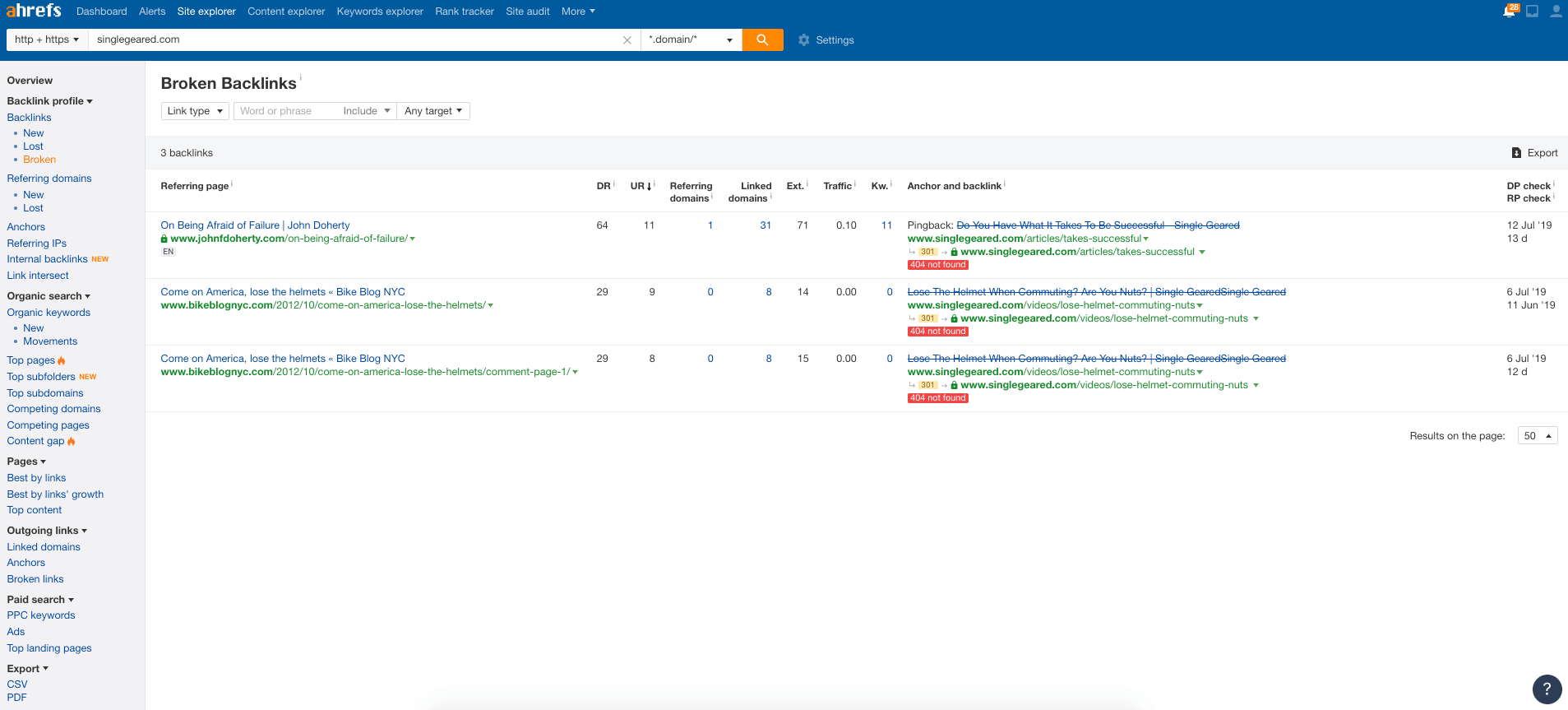
Referring Domains
The next report is “Referring domains” and under it are two reports called “New” and “Lost”.
“Referring domains” does the opposite of what the main Backlinks report does.
This “Referring domains” report shows you all of the individual domains linking to your site in case you want a full list:
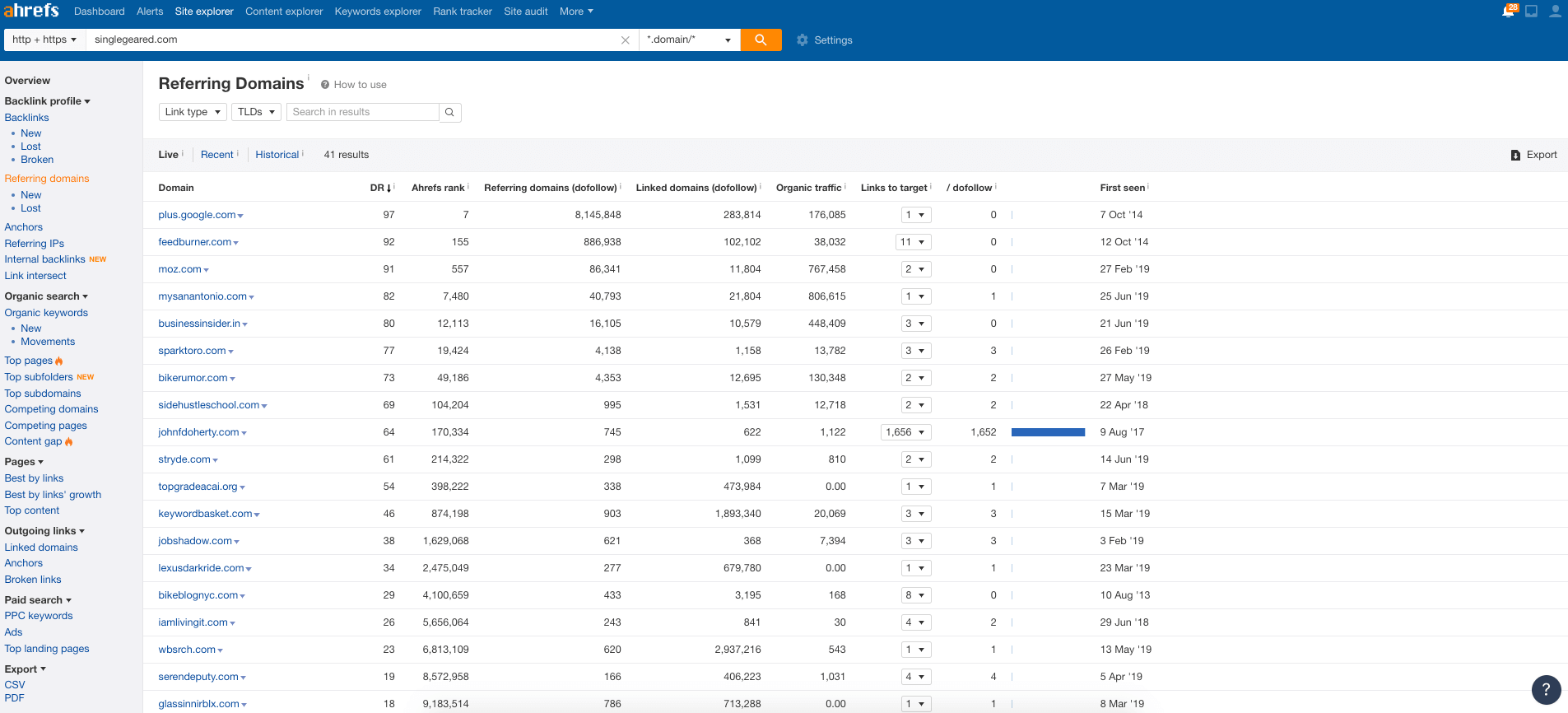
I actually really like this report because I used to spend a lot of time in Excel deduplicating domains to get a list of domains, so this can save a lot of time while prospecting for clients.
New and Lost reports do exactly what they say here. They’re just different views on the domain report.
Anchors
Next up is the Anchors report, which shows you a breakdown in the anchor text of links pointing to your site:
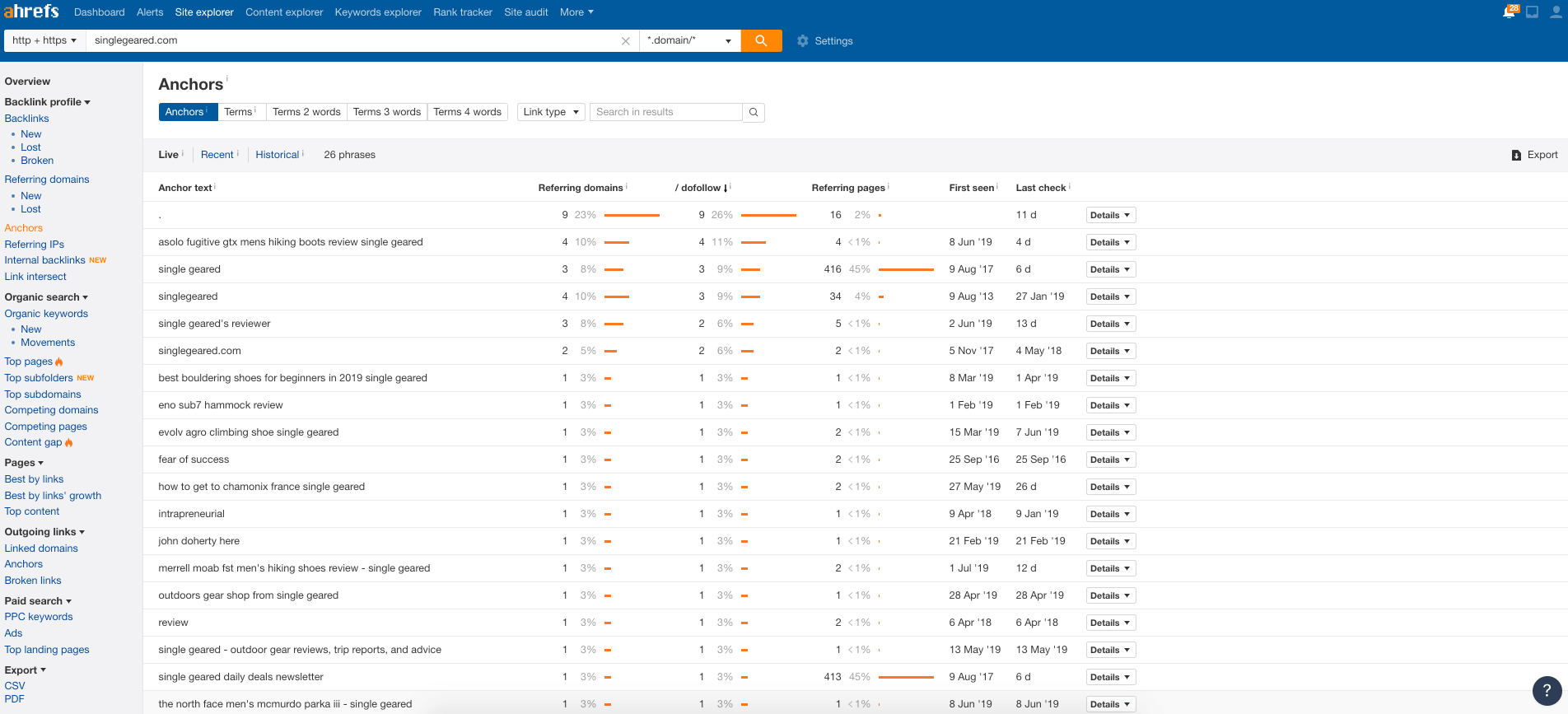
This report can be useful when you’re facing a site that may have a manual or algorithmic links penalty in Google.
Referring IPs
Next up is the Ahrefs “Referring IPs” report, which basically tells you the IP from which your links are coming. This report is great for identifying blog networks where the creator did not diversify IPs. This can be very useful for identifying low quality backlink building strategies:

Internal backlinks
The Internal backlinks report is a new report for Ahrefs and not one that many of the other tool providers have.
Basically, this report lets you see all of the internal links pointing to a page on your site. Building new internal links from strong internal pages to weaker internal pages can be a great way (when balanced with the user experience of course) to help lower pages rank better without building any external links!
For example, you can filter down to nofollowed internal links (in this case they are all to links that redirect to affiliate links) that could be hampering rankings:
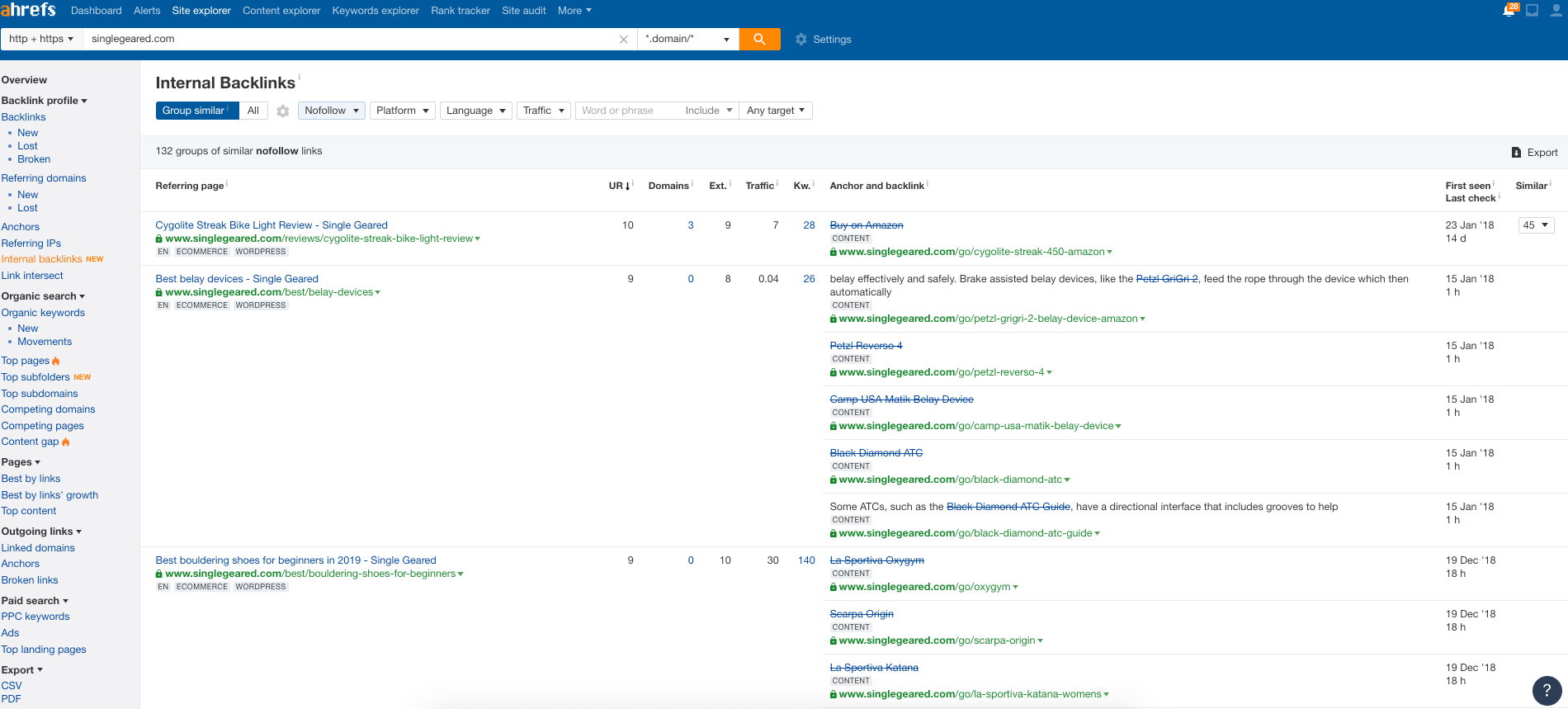
I find this report super useful because it helps me prioritize pages to which I need to be linking or where I could be adding in new links.
It also helps me save internal link equity, which can be one of the easiest wins with technical SEO.
Link Intersect
The final link report is the Link Intersect report which we talked about above.
This tool lets you compare competitor sites and find the sites that link to them but don’t link to you:

Winner: Edge to SEMrush
Both of these tools have great backlink data and helpful tools to make any SEO or web professional’s life easier.
The tools are similar, but offer different things of value.
Therefore we say this one is nearly a toss-up with a slight advantage to SEMrush at this time.
SEMrush takes their backlink data, lets you slice and dice it, and then takes it further with their link outreach tools.
Ahrefs, per usual, does a great job of making their data actionable through their front-end. I get more insights quickly from Ahrefs, but don’t know that I can get the breadth of data to manipulate on my own within Excel.
Once again, we did not independently verify the accuracy of their link indices. Others have done that way better than we could.

